Welcome to Infomatize, We are a team of professional writers, to provide our readers with high-quality, well-researched articles on a wide variety of topics. From current events and news to lifestyle, health and wellness, travel, and more, we designed this website on the principle of providing reliable and informative content to our readers. We understand the importance of accurate and reliable information, which is why we have a team of professional writers who are experts in their respective fields.
Don't wanna be here? Send us removal request.
Text
10 Surprising Facts About Breast Cancer You Need to Know
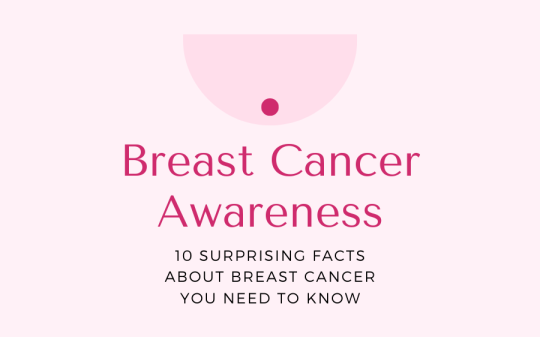
Introduction
Breast cancer is a significant health concern that affects millions of women around the world. It is the most common cancer among American women, and one in eight women will develop the disease in their lifetime . Early detection is crucial as it greatly increases cancer survival rates, and with early detection, the five-year survival rate for breast cancer is nearly 100% . In this essay, we will explore ten surprising facts about breast cancer that you need to know. It is not just a women's issue; it can also affect men, although it is rare. About one in a thousand men in the United States will experience breast cancer in their lifetime . Age is a significant factor in breast cancer risk, and a woman's risk for developing breast cancer increases as she gets older. Read the full article
#Australia#Austria#Belgium#BRCAgenemutations#Breastcancerandbonehealth#Breastcancerandbreastreconstruction#Breastcancerandcaregiving#Breastcanceranddiet#Breastcancerandemotionalwell-being#Breastcancerandenvironmentalfactors#Breastcancerandexercise#Breastcancerandfamilyhistory#Breastcancerandfertility#Breastcancerandgenetics#Breastcancerandhearthealth#Breastcancerandlifestylefactors#Breastcancerandlymphedema#Breastcancerandmenopause#Breastcancerandmentalhealth#Breastcancerandpregnancy#Breastcancerandsexualhealth#Breastcancerandstress#Breastcancerawareness#Breastcancerclinicaltrials#Breastcancerdiagnosis#Breastcancerfacts#Breastcancerinolderwomen#Breastcancerinyoungwomen#Breastcancerprevention#Breastcancerrecurrence
0 notes
Text
How to Install CyberPanel on Ubuntu 22.04 Like a Pro! – Quick Tips

CyberPanel is a user-friendly control panel that makes managing websites and servers much easier, even for beginners. It uses LiteSpeed Web Server (a fast web server) and offers features like one-click WordPress installation, automatic SSL certificates, and a simple interface. In this guide, we’ll break down every step to help you Install CyberPanel on Ubuntu 22.04 server in a way that’s easy to follow, even if you’re not an expert. Let’s dive into each step How to Install CyberPanel on Ubuntu 22.04 Like a Pro!

Why Choose CyberPanel?
Before diving into the installation process, you might wonder why you should choose CyberPanel over other control panels like cPanel or Plesk. Here are a few compelling reasons: - Open Source: It’s completely free (though there’s an Enterprise version with additional features if you’re interested). - Lightweight and Fast: Built around OpenLiteSpeed, CyberPanel is optimized for speed and performance. - Intuitive Interface: The dashboard is clean and user-friendly, even for beginners. - Advanced Features: From one-click installations of WordPress to built-in support for Git, Redis, and Docker, CyberPanel offers plenty of powerful tools. - Auto SSL: Easily install and manage SSL certificates. Sounds like the control panel of your dreams, right?
Pre-Installation Checklist
Before you can install CyberPanel on Ubuntu 22.04, there are a few things you’ll need to prepare. Don’t worry, nothing too crazy! 1. A Fresh Ubuntu 22.04 Server Make sure you’ve got a clean installation of Ubuntu 22.04. You can set this up on a virtual private server (VPS) from your favourite hosting provider. Avoid running the installation on a server that already has web services installed, as that can cause conflicts. 2. Root Access or Sudo Privileges You’ll need root access to your server, or at the very least, a user account with sudo privileges. If you don’t have this, the installation won’t work properly. 3. Server Specifications Here are the minimum recommended system specs for running CyberPanel: - 1 GB of RAM (though 2 GB is ideal for better performance) - 10 GB of free disk space (more if you plan on hosting multiple websites) - A 64-bit operating system (which Ubuntu 22.04 is) 4. Domain Name While it’s not strictly required for the installation, having a domain name handy will allow you to configure your website and apply SSL certificates more easily.
Step-by-Step Guide: How to Install CyberPanel on Ubuntu 22.04
Alright, with your server ready and your domain name in hand, let’s get into the nitty-gritty of installing CyberPanel.
Step 1: Update Your Server’s Software
Before you install anything new, it’s a good idea to make sure your Ubuntu system is up to date. This helps avoid problems later and ensures everything runs smoothly. To update your server, open your terminal (a place where you can type commands) and enter these two commands one after the other:

- The first command, sudo apt update, checks for the latest updates for your system. - The second command, sudo apt upgrade -y, installs those updates. This could take a few minutes, depending on your internet connection and the speed of your internet. Once this is done, your system will be ready for the next steps.
Step 2: Install Basic Tools
Now, we need to install some basic tools that CyberPanel needs to run properly. These tools will help us download and install other software in the next steps. Run this command in your terminal:

- wget is a tool that helps us download files from the internet. - curl is a tool that allows us to transfer data and communicate with servers. By installing these, you’re preparing your system for the main installation.
Step 3: Download the CyberPanel Installer
Next, we need to download a special script (a small program) that will help us install CyberPanel. To do this, use the following command:

This command downloads the CyberPanel installer script and saves it to a file called installer.sh on your server. Once the script is downloaded, you need to permit it to run. To do that, enter:

This command makes the script executable, which means we can run it in the next step.
Step 4: Start the Installation Process
Now that everything is set up, we can begin the actual installation of CyberPanel. This step will take a while, and you’ll be asked to make some choices along the way. To start the installation, type:

This command runs the installer script. Once it begins, you’ll see several options. Let’s walk through them: Choosing the Web Server You’ll be asked whether to install the LiteSpeed Enterprise (a paid version) or OpenLiteSpeed (a free version). Since OpenLiteSpeed is free and works well for most users, we recommend selecting it by typing: Full Installation vs. Minimal Installation Next, you’ll be asked if you want to do a Full installation or a Minimal installation. Choose Full installation, as it includes important tools like PowerDNS (for managing your domain names) and Postfix (for sending emails). Installing Memcached and Redis These are tools that help speed up your websites by caching data (temporarily storing it so it can be accessed quickly). If you plan to host websites that need fast performance, select yes when asked to install Memcached and Redis. Setting an Admin Password At the end of the installation, you’ll be asked to set a password for the admin user. This password will be used to log in to the CyberPanel dashboard. Make sure to choose a strong password and write it down somewhere safe and secure place. After answering these questions, the installation will continue and It may take several minutes to finish.
Step 5: Access the CyberPanel Dashboard
Once the installation is complete, you’ll be given a link to log in to the CyberPanel web interface. This is where you can manage your websites and server settings. To access CyberPanel, open your web browser and type in the following:

- Replace with the actual IP address of your server. - The :8090 at the end is the port number where CyberPanel runs. You might see a warning saying that the site is not secure. This is normal because the server is using a self-signed SSL certificate. You can click through the warning to access the dashboard. Log in using the admin username and the password you created during installation.
Step 6: Configure OpenLiteSpeed
After logging in to CyberPanel, you’ll need to configure OpenLiteSpeed (the web server that powers your websites). Here’s how to do it: - Access the OpenLiteSpeed Admin: From the CyberPanel dashboard, click on OpenLiteSpeed WebAdmin. You’ll be taken to the OpenLiteSpeed admin page. - Log in to OpenLiteSpeed: Use the default credentials: - Username: admin - Password: 123456 (or the one you set during installation). - Change the Admin Password: For security reasons, it’s important to change the default admin password. To do this, run this command in your terminal:

- Follow the instructions to change your password.
Step 7: Secure CyberPanel with SSL
To protect your data and ensure a secure connection to CyberPanel, we need to set up an SSL certificate. CyberPanel allows you to do this automatically using Let’s Encrypt, a free service that provides SSL certificates.

Here’s how to do it: - Log in to the CyberPanel dashboard. - Go to SSL > Hostname SSL. - Enter your server’s hostname (the name of your server or domain). - Click Issue SSL. This will install an SSL certificate, and your CyberPanel interface will now be secure.
Step 8: Create and Manage Websites
With CyberPanel installed and secured, you can now start hosting websites. Here’s an easy-to-follow guide to help you begin: - Add a New Website: In the CyberPanel dashboard, go to Websites > Create Website. Fill in the necessary information: - Domain Name: The name of your website (e.g., example.com). - Email: Your email address. - PHP Version: Choose a version that works with your site (the default should be fine). Once you’ve entered this information, click Create Website. - Set Up DNS for Your Domain: DNS (Domain Name System) is what helps people find your website online. To configure DNS, go to DNS > Create Zone. Enter your domain name and set the A (Address) record to point to your server’s IP address. - Install WordPress: CyberPanel makes it easy to install WordPress. Go to Websites > List Websites, find your domain, and click Manage. You’ll see an option to install WordPress with one click.
Step 9: Enable Backups
It’s very important to regularly back up your website to ensure you can recover it if anything goes wrong. CyberPanel has a built-in tool for scheduling backups. - Go to Backup > Schedule Backup. - Select the website that you want to take a backup. - Choose how often you want to back up (daily, weekly, etc.). - Select a destination for your backups (you can save them locally or send them to a remote server). Once this is set up, CyberPanel will automatically create backups for you.

Step 10: Optimize CyberPanel for Speed
To get the best performance from CyberPanel, you can make a few adjustments: - Enable LSCache: LSCache is a caching system that speeds up websites. Go to Websites > List Websites, find your website, and enable LSCache for faster load times. - Adjust PHP Settings: If your website uses a lot of PHP scripts (common for WordPress sites), you can tweak the settings. Go to Server > PHP > Edit PHP Configs to adjust things like memory limits. - Use Security Plugins: To keep your server secure, consider installing Security plugins such as CSF Firewall and ModSecurity help protect your server from malicious attacks and enhance your website’s overall security. Here’s how you can install them through CyberPanel: CSF Firewall: - Go to Security > Install CSF from the CyberPanel dashboard. This firewall helps protect your server by blocking unwanted traffic. - After installation, you can configure it by navigating to Security > CSF Configuration where you can add specific rules or adjust settings to secure your server. ModSecurity: - To install ModSecurity, go to Security > Install ModSecurity in the dashboard. - Once installed, it will monitor web traffic for suspicious activities and block potential threats. It’s an excellent tool for preventing attacks like SQL injections and cross-site scripting. Both security plugins work in the background to safeguard your server and websites, helping to prevent common vulnerabilities.
Step 11: Monitor Server Performance
After you’ve successfully installed and set up CyberPanel, it’s crucial to keep an eye on your server’s performance. Monitoring your server helps you spot any potential issues before they turn into bigger problems. CyberPanel comes with built-in tools to help you with this: - Real-Time Monitoring: Go to Server Status > LiteSpeed Status to see how your server is performing. This page shows you important details like CPU usage, memory usage, and active connections. - System Health Check: Under Server Status > System Status, you can check the overall health of your server. This includes key metrics such as available disk space, RAM usage, and the status of various services like MySQL and DNS. Monitoring these areas regularly ensures that your server runs efficiently and doesn’t run out of resources unexpectedly.
Step 12: Troubleshooting Common Issues
Even with a detailed guide, you may run into problems during or after installation. Here are some common issues you may face and how to fix them: Issue 1: Can’t Access CyberPanel Web Interface - If you can’t access CyberPanel at https://:8090, the most likely reason is that port 8090 is blocked. To fix this, open the port by running the following command on your server:

After that, try accessing the panel again in your browser. Issue 2: SSL Certificate Not Working - If the SSL certificate you issued using Let’s Encrypt isn’t working, try reissuing the certificate: - Go to SSL > Manage SSL in CyberPanel. - Select your domain and click Issue SSL again. This will attempt to reissue the certificate, solving most SSL-related issues. Issue 3: Website is Running Slowly - If your website is slow, you can enable LiteSpeed Cache (LSCache) for faster performance. You should also consider using CDN (Content Delivery Network) services like Cloudflare to speed up content delivery.
Final Overview
Installing CyberPanel on Ubuntu 22.04 may seem like a technical task, but with this detailed guide, even a beginner can complete the process with ease. By following each step, you will set up a robust, secure, and high-performing web hosting environment using the OpenLiteSpeed web server and CyberPanel’s powerful features. From basic installation to security measures and performance optimization, this guide ensures that your websites will run smoothly on your server. Whether you're hosting a personal website or managing multiple domains, CyberPanel offers the flexibility and tools you need to succeed, making it an ideal choice for anyone new to server management. Now, go ahead and explore the many features of CyberPanel!
FAQs
1. Is CyberPanel free to use? Yes, CyberPanel is completely free. There’s also a paid Enterprise version with more features, but the free version is more than enough for most users. 2. Can I install CyberPanel on a VPS with less than 1 GB of RAM? While it’s technically possible, it’s not recommended. CyberPanel runs much more smoothly on systems with at least 1 GB of RAM (preferably 2 GB). 3. What’s the difference between OpenLiteSpeed and LiteSpeed Enterprise? OpenLiteSpeed is the free, open-source version of LiteSpeed. LiteSpeed Enterprise offers premium features like better performance and more advanced caching options, but it requires a license. Read the full article
#cloudpanelvscyberpanel#cyberpanel#cyberpanelhosting#cyberpanelinstall#cyberpanellogin#cyberpanelvps#cyberpanelvpshosting#cyberpanelvscpanel#installcyberpanel#whatiscyberpanel
0 notes
Text
Pet Photography and Videography: Capturing Your Furry Friend in the Best Light Tips and Tricks for Stunning Shots

Introduction
Pet photography and videography can be a fun and rewarding way to capture your furry friend's personality and create lasting memories. Here are some tips and tricks from various sources to help you capture stunning shots of your pets: - Look for different perspectives: Try photographing from your pet's eye level to make them feel comfortable and enhance their personality. Using simple backgrounds can also help avoid unflattering photos, and always focus on the eyes of the pet. - Use the right camera settings: A wide aperture (low f-stop) and a fast shutter speed (at least two times faster than the focal length of the lens) can help you capture sharp images of your pet while blurring the background. If you want to capture action shots, you'll want your shutter speed higher than 1/800. - Catch their attention: Sudden sounds are a great way to surprise pets and capture an alert posture, while toys and strings can help get their attention in a more relaxed manner. Be sure to reward them regularly during the shoot, especially after getting a winning shot. - Lighting: Natural light is often the best for pet photography, so try to shoot near a window or in a well-lit area. You can also introduce studio lighting, but consider continuous lighting at first, as flash can be startling for pets who are not accustomed to it. Use a softbox to diffuse the light. - Get down to their level: Getting down to your pet's level can create more intimate and engaging shots. It can also help capture the texture of their fur or skin. - Be patient: Pets are unpredictable, and you may need to be patient to capture the perfect shot. Take your time and don't get frustrated if it takes a while to get the shot you want. By following these tips and tricks, you can capture stunning shots of your furry friend and create lasting memories to cherish for years to come.
Understanding Your Pet's Personality and Preferences

Pets, like humans, have their unique personality traits and preferences. Understanding your pet's personality can help you build a stronger bond with your furry friend and improve your relationship with them. Here are some findings that can help you understand your pet's personality and preferences. Dogs, for example, use posture, facial expressions, and body language to communicate their mood and intentions. Understanding dog body language can help you communicate with them more effectively and build a better relationship . Additionally, dogs can also show handedness, just like humans. Researchers call it "pawedness," and it can be an indicator of your dog's temperament and behavior . Some pets have personalities that are associated with their breed or zodiac sign. For example, a Sagittarius pet is energetic and always looking for adventure . However, pets can also have unique personalities regardless of breed or zodiac sign. For example, a pet with a vacuum-like personality will eat anything they can get their paws on and may stare at you while you eat . Furthermore, pet owners' personalities can also influence their pet's preferences and behavior. Dog owners, for instance, tend to be more extroverted, agreeable, and assertive, while cat owners tend to be more introverted and open-minded . Pet owners' personality traits can also influence their work preferences and attitudes towards others . In conclusion, understanding your pet's personality and preferences can help you build a better relationship with them. By observing their body language, behavior, and unique personality traits, you can develop a deeper understanding of their needs and wants. Additionally, understanding your personality and how it influences your pet's behavior can help you create a harmonious and enjoyable relationship with your furry friend. The Benefits of Knowing Your Pet's Personality for Photography Knowing your pet's personality can have many benefits for pet photography. Understanding your pet's personality can help you capture their unique characteristics and behaviors in your photographs. Here are some benefits of knowing your pet's personality for photography: - Choosing the right setting: Knowing your pet's personality can help you choose the right setting for your photo shoot. For example, if your pet is shy, you may want to choose a quiet and comfortable location for your photo shoot. On the other hand, if your pet is active and playful, you may want to choose a location where they can run and play freely. - Capturing their expressions and emotions: Understanding your pet's personality can help you capture their unique expressions and emotions. For example, if your pet is goofy and playful, you may want to capture them in a silly and playful pose. Alternatively, if your pet is calm and relaxed, you may want to capture them in a peaceful and serene pose. - Getting them to cooperate: Knowing your pet's personality can help you get them to cooperate during the photo shoot. For example, if your pet is easily distracted, you may want to use treats or toys to keep their attention focused on the camera. Alternatively, if your pet is nervous, you may want to take breaks during the photo shoot to help them relax. - Choosing the right equipment: Understanding your pet's personality can help you choose the right equipment for your photo shoot. For example, if your pet is active and playful, you may want to use a fast shutter speed to capture them in action. Alternatively, if your pet is calm and relaxed, you may want to use a shallow depth of field to create a soft and dreamy effect. In summary, knowing your pet's personality can help you capture their unique characteristics and behaviors in your photographs. By understanding their personality, you can choose the right setting, capture their expressions and emotions, get them to cooperate during the photo shoot, and choose the right equipment for the job. Capturing Your Pet's Unique Personality on Camera Capturing your pet's unique personality on camera can be a challenge, but it is a great way to preserve memories and showcase your pet's individuality. Here are some tips from the Infomatize team to help you capture your pet's personality in photographs: - Use the right camera settings: Shutter speed can be used to freeze action or create a blur effect. Depending on the type of shot you want to capture, adjust your camera settings accordingly. Use a slower shutter speed for portraits and a faster one for action shots. - Shoot from your pet's eye-level: To create a more natural and comfortable perspective, try photographing your pet at their eye-level. This can also help to enhance their personality and capture their unique features. - Choose a comfortable location: Pets will often be more relaxed and natural in a familiar environment. Try photographing your pet in a place where they are comfortable and free from distractions. This can help to capture their unique personality traits. - Capture your pet at play: Photographing your pet at play can be a great way to capture their unique personality and energy. Be sure to use a fast shutter speed to avoid blur and try to capture their playful expressions. - Focus on the eyes: The eyes are often the most expressive and interesting feature of your pet. Make sure to focus on them and capture their unique expressions. - Minimize distractions: Try to minimize any distractions that may startle or upset your pet. Turn off any beeping sounds on your camera and focus on capturing your pet's natural state. Remember, every pet is unique and has their own personality traits. By following these tips, you can capture your pet's individuality and create photographs that showcase their unique personality. Catering to Your Pet's Preferences for Stunning Shots Capturing stunning shots of pets requires catering to their preferences and needs. Here are some tips: - Get down to their level: To make your pet feel comfortable, try photographing from their eye-level. This will also enhance their personality in the photo. - Focus on the eyes: Sharp eyes are crucial in portrait photography, and pet photography is no different. The eyes are the window to the soul, and your pet's eyes can be very expressive. Make sure to focus on their eyes and keep them tack sharp. - Experiment with angles: Don't be afraid to experiment with different angles when composing your shot. Crouch down, sit, or lay on the ground for an interesting perspective. This will also make your pet feel more comfortable. - Use simple backgrounds: To avoid unflattering photos, use simple backgrounds that won't distract from your pet. This will also help to enhance their personality in the photo. - Consider aperture: To take a close-up shot of your pet with a smooth, blurred background, set your camera to aperture priority mode and your lens to the widest aperture possible (lowest f-stop number). This will create a shallow depth of field, which is great for portraits. - Adjust shutter speed: Shutter speed is important in capturing your pet's action shots. Use 1/2000 - 1/4000 to freeze action, 1/300 for portraits, and anything lower than 1/100 will begin to slow the camera down a lot. By catering to your pet's preferences and needs, you can capture stunning shots that showcase their unique personality.
Mastering the Art of Lighting in Pet Photography

Pet photography can be a challenging endeavor, but one of the most important aspects of creating stunning pet portraits is lighting. Here are some tips on mastering the art of lighting in pet photography: - Shoot in manual mode with manually triggered strobes . This allows you to focus on wrangling the animal and getting the best shots once your lighting is set up. - Look for natural lighting scenarios and take your photo from the same direction as the light source . Avoid shooting directly into the sun as it can create unflattering shadows. - Try photographing from your pet's eye-level to make them feel comfortable and to enhance their personality. Use simple backgrounds to avoid distracting elements, and always focus on the eyes of the pet . - Use bright lights and avoid low and dark lights. Professional pet photographers often use studio lighting for quality and accuracy . - Experiment with different lighting setups, such as using three midsize softboxes: a key light at 45 degrees on one side, a main light at 45 degrees on the other side, and a hair light coming from above and behind the pet . - Consider using off-camera speed lights for fill or effects lighting . - Test and adjust the lighting with a stand-in stuffed animal before bringing in the real subject . Mastering the art of lighting in pet photography requires experimentation and practice. Keep in mind that every animal is different, so be patient and flexible in your approach. By understanding the quality of light, playing with shadows and reflection, and experimenting with different lighting setups, you can create stunning, visually impactful pet portraits that capture the personality and essence of your furry friend. Natural Light vs. Artificial Light: Which is Better for Pet Photography? When it comes to pet photography, both natural and artificial light have their own advantages and disadvantages. Natural light is abundant, readily available, and free. It provides a soft and diffused light that can create a more natural and pleasing look to your pet's fur and eyes. However, natural light is not always available, especially in indoor settings, and can be affected by the weather conditions, causing inconsistent lighting results . Artificial light, on the other hand, offers a greater degree of control and consistency over lighting quality . By owning an artificial lighting solution, you can take photographs anytime, day or night, indoors or outdoors, regardless of the weather conditions . It also provides a full customization ability to your lighting setup, allowing you to tailor the lighting to fit your pet and the intended shot . However, artificial light can create harsher shadows and highlights, resulting in a less natural look for your pet. Also, pets may become agitated or frightened by flashes from artificial light sources, causing difficulty in capturing good photos . Ultimately, the choice between natural and artificial light in pet photography comes down to the photographer's preference and the situation at hand. Natural light can be ideal for outdoor shoots, while artificial light can provide greater control and consistency in indoor settings. It's recommended that photographers experiment with both and determine which suits their style and pet the best. How to Use Natural Light to Your Advantage in Pet Photography Natural light can be a great tool to use when photographing pets. Here are some tips on how to use natural light to your advantage in pet photography, as found in the search results: - Shoot on overcast days or when the sun is low in the sky to avoid harsh shadows. This will ensure that your pet's features are well-defined and the lighting is even . - Try photographing from your pet's eye-level to make them feel comfortable and showcase their personality. Use simple backgrounds to avoid unflattering photos, and always focus on the eyes of the pet . - Before the photo session, spend time exercising with your pet to burn off some excess energy. This will help keep them calm and focused during the shoot . - Reward your pet regularly during the shoot, especially after getting a winning shot. This will help keep them motivated and engaged throughout the session . - Timing is important when it comes to natural light. The best time of day for photography of any kind, including pet photography, is when the sun is low in the sky, just about to fall below the horizon. This period lasts anywhere from thirty minutes to half a day and is perfect for capturing soft, diffused light . Essential Lighting Techniques for Professional-Quality Pet Photos To take professional-quality pet photos, lighting is a crucial factor. Here are some essential lighting techniques that can help you take great pet photos: - Use natural light when possible, and avoid using strobe lights that may startle or agitate your pet . - Shoot on an overcast day or when the sun is low in the sky to avoid harsh shadows . - Consider using a telephoto lens to shoot from a distance, which is less distracting for your pet and causes less distortion than wide-angle lenses . - Use a macro lens to capture extremely sharp details in your photos . - Use an aperture priority mode and set your lens to the widest aperture possible (lowest f-stop number) to get a smooth, blurred background and draw attention to your pet's face or eyes . - Use simple backgrounds to avoid unflattering photos and always focus on the eyes of your pet . - Have enough space to get in front of your pet, and consider using elevated furniture or a platform for better composition . - Reward your pet regularly during the shoot, especially after getting a winning shot . By utilizing these essential lighting techniques and tips, you can take professional-quality pet photos that truly capture your furry friend's personality and spirit.
Nailing the Composition in Your Pet Photos
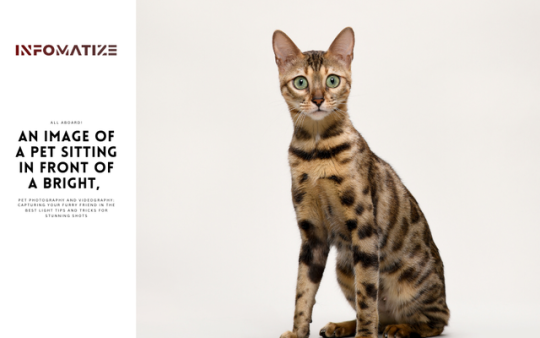
Photographing pets can be a fun and rewarding experience, but it can also be a challenging one, especially when it comes to composition. Here are some tips to help you nail the composition in your pet photos: - Get down to their eye-level: To make your pets feel more comfortable and to enhance their personality, try photographing them from their eye-level . - Use simple backgrounds: To avoid unflattering photos, use simple backgrounds that don't distract from your pet . - Focus on their eyes: As the saying goes, "the eyes are the window to the soul." By focusing on your pet's eyes, you can capture their essence and personality . - Be flexible: Professional pet photographers will often bend, twist, turn, crouch, and crawl to get the perfect shot. Be prepared to get your muscles working and move around to get the perfect composition . - Use natural light: Natural sunlight is one of the best lighting options for pet photography. It will keep the red-eye look out of your photos and is warmer than using the on-camera flash . - Incorporate a foreground element: When working with a wide-angle lens, make sure to include a foreground element in your composition. This will add depth and interest to your photos . - Experiment with texture: Interesting textures, such as those on walls and roofs, can add a unique element to your pet photos . - Crop for a snug fit: Use the crop tool to get a snug fit around your pet, and choose a 4:5 (8:10) aspect ratio for a more pleasing composition . By following these tips, you can improve the composition of your pet photos and capture the unique personality of your furry friends. The Rule of Thirds and Other Composition Tips for Stunning Pet Photos When it comes to taking stunning pet photos, composition is key. One composition technique that can greatly enhance your pet photos is the Rule of Thirds. According to Petapixel, the Rule of Thirds is a way of organizing subjects in a photo by dividing the frame into a three-by-three grid of nine equal-sized boxes, with the subject placed on one of the intersections or along the lines. This helps create a more balanced and aesthetically pleasing image . Click and Learn Photography explains that the Rule of Thirds is based on the principle that the focal points and points of interest in an image should fall on the intersections or lines of the grid. For example, if you are taking a photo of your pet in a natural setting, you might place your pet on the lower-left third intersection while the horizon runs roughly along the upper third line. This can produce a more balanced and aesthetically pleasing image . In addition to the Rule of Thirds, there are other composition tips you can use to take stunning pet photos. Shotkit suggests using the top left third, bottom left third, top right, and bottom right as power points in your image or design. This is because research shows that a viewer's eye is naturally drawn to these areas first. Using these power points can help create a visually engaging and aesthetically pleasing image . Digital Photography School explains that the Rule of Thirds encourages dynamism in your photos by placing key elements off to the side and taking the viewer on a visual journey throughout the image. This creates a more engaging photographic experience for the viewer. Read the full article
#Bestcamerasettingsforpetvideography#Bestlocationsforoutdoorpetphotography#Catphotography#Dogphotography#Howtocaptureyourpet'spersonalityinphotos#Howtocreateapetphotographyportfolio#Howtoeditpetphotosforaprofessionallook#Howtoeditpetvideosforaprofessionallook#Howtophotographpetsinaction#Howtoprepareyourpetforaphotoshoot#Howtotellastorythroughpetvideos#Howtousepropsinpetphotography#Petphotoshoots#Petphotography#Petphotographyandvideography#Petphotographyandvideographypackages#Petphotographyequipmentforbeginners#Petphotographyforspecialoccasions#Petphotographyideasforcreativeshots#Petphotographyposesforcuteandfunshots#Petphotographyservices#Petphotographytips#Petportraits#Petvideography#Petvideographyforsocialmediacontent#Petvideographytips#Tipsforcapturingstunningpetphotos#Tipsforphotographingblackpets#Usingmusicinpetvideos#Usingnaturallightinpetphotography
3 notes
·
View notes
Text
DIY Pet Projects 2023: A Comprehensive DIY Guide To Homemade Toy and Grooming Supply Ideas for Your Furry Friend
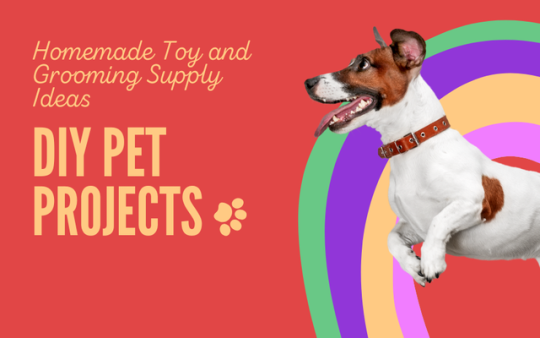
Introduction
If you're looking for DIY pet projects, there are plenty of options available to you! From homemade toys to grooming supplies, you can find ideas for a variety of projects online. Here are some examples of DIY pet projects to get you started: - Homemade Bottle Toy for Dogs: This simple toy requires only an empty plastic bottle and a sock, and can provide hours of entertainment for your furry friend. Simply put the bottle inside the sock, tie a knot at the end, and let your dog play! - Soda Bottle Treat Dispenser: This interactive toy made from a chicken nesting box and two 2-litre soda bottles is a brain teaser for your dog. It's a fun way to keep your pup occupied while rewarding them with treats. - DIY Snuffle Ball: This soft and safe toy is easy to make using the odds and ends of fabric. It's perfect for dogs of all ages and provides a fun snuffling experience. - Adorable DIY Cat Scratch Cactus: This creative DIY project allows you to make your own cat scratch pole using affordable materials like cardboard and sisal rope. It's a great way to keep your feline friend entertained and healthy. - Water and Food Bowl DIY Pet Ideas: This list of DIY pet projects includes ideas for creating a modern pet bowl stand using wooden dowels and glue, as well as a drawer storage unit for pet bowls. You can also create a chalkboard dog bowl using ceramic bowls and chalkboard spray paint. - Make Dog Toys Using Old Clothes: Reuse old clothes like t-shirts, sweatpants, and towels to make braided or knotted dog toys that are affordable and eco-friendly. - Upcycled Pet Toys: This list includes ideas for upcycling materials like t-shirts and tennis balls into fun and safe toys for your pet. You can also make a no-sew heart stuffie or a muffin tin treat game for your furry friend. - Pet ID Tags: Every dog needs a pet ID tag on its collar, and this craft is easy to make. You can also make stamped metal ID tags if you enjoy jewellery making or metalworking. These DIY pet craft ideas are a fun way to make money while having fun. - Clothing, Collars, and Leashes: This list includes ideas for creating adjustable dog collars, bandanas, frill dresses, and collars with bow ties. You can also personalize your creations by adding a name or message to the collar. - Easy DIY Dog Crafts to Make and Sell: This list includes 15 ideas for creating dog crafts that you can sell, including personalized dog collars, dog beds, and dog bandanas. These projects are easy to make and can provide a fun way to earn some extra cash.
DIY Pet Toys

If you're looking to create your own toys for your beloved pets, there are plenty of DIY options available. From simple chew toys to intricate puzzle games, here are some ideas to get you started. - Sweet Potato Dog Toy: Made with strong rope and dried sweet potatoes, this toy is great for dogs that love to chew. The knotted rope makes it difficult for even strong chewers to completely destroy it instantly. - Foxtail Toy: Upcycle one of your old t-shirts to create a simple foxtail toy for your dog. Simply cut the shirt straight across just below the sleeves, discard the neck and sleeves, cut the remaining fabric into strips, gather three of the strips together, and tie a knot at one end. - Denim Dog Toy: This no-sew toy is easy to make and perfect for heavy chewers. All you need is an empty 20-oz. plastic bottle, a sock that is at least 5 inches longer than the bottle, and a knot tied at the end of the sock that is open. - Chew Toy from Socks: If you're looking for a simple chew toy for your dog, try this option. Simply braid a few old socks together, tie the ends together, and you have a new chew toy for your furry friend. - Ring Toy: Use coloured basic 4-strand crown knots to create this simple, super-strong ring toy for your pet. Adjust the rope length and ring size according to the size of your dog. - Towel Braid Toy: Cut three strips of the towel, about 4 inches wide and at least 12 inches long, tie them off at one end with a small towel strip (1 inch wide and 6 inches long), braid them, and use another strip to tie off the end. - Pet Mat Toy: Cut fabric into 1" x 7" strips, push one end through a hole in the mat, take the other end and push it through the hole next to it, double knot the fabric, and push each end of a fabric strip through adjacent holes that are horizontal. There are many other DIY pet toy ideas out there, so get creative and have fun making toys that your pets will love. Happy crafting! DIY Catnip Toys: How to Make Your Cat's Favorite Toy Cats love catnip toys, and making them at home can be a fun and easy way to keep your feline friend entertained. Here are some DIY catnip toy ideas and instructions: - Sock catnip toy: Fill a sock with catnip and tie a knot at the end. You can also add some stuffing to make it more plump . - Felt catnip toy: Cut two identical shapes out of felt, like a fish or a mouse, and sew them together, leaving a small hole for stuffing. Fill the toy with catnip and stuffing, then sew the hole shut . - Catnip kicker toy: Cut two strips of fabric about 8 inches by 2 inches. Fold each strip in half and sew the two long sides together. Stuff the fabric tube with catnip and stuffing, then sew the ends shut. This will create a long, cylindrical shape that your cat can hold and kick with its back legs . - Pom-pom catnip toy: Make a small pom-pom out of yarn and attach a string to it. Dip the pom-pom in catnip and let it dry. Once the catnip has dried, give the toy to your cat to play with . Remember that catnip toys should be given to your cat in moderation, as too much catnip can make them hyperactive or anxious. It's also important to supervise your cat while they play with toys, as they may accidentally ingest small parts or strings. Homemade Chew Toys: Safe and Affordable Options for Your Dog Making your own chew toys for your dog is a great way to provide them with safe and affordable entertainment. Here are some ideas based on the various sources: - T-Shirt Ball Tug Toy: You can create a tug toy for your dog using an old t-shirt, a tennis ball, and scissors. Cut the shirt in three strategic places and wrap the ball inside two of the pieces, using the smallest piece to cinch the toy together. - Frozen Towel Chew: Soak a hand towel or washcloth in water or a mix of water and salt-free bouillon, wring it out thoroughly, and twist it into a long sausage shape. Freeze the towel until it's solid, then give it to your pup to chew. - No Chew Heart Toy: This chew toy is made by braiding three strands of fleece and forming them into a heart shape. It's a great way to keep your dog's teeth clean and healthy while satisfying their chewing needs. - Dried Sweet Potato Chews: Slice sweet potatoes into half-inch strips and bake them for four hours, flipping them over every two hours. When they're done, let them cool and then freeze them for a chewy, tasty treat. - Cinnamon and Coconut Oil Chews: Cut sweet potatoes into thin slices and top them with melted coconut oil or raw honey, and sprinkle with cinnamon. Bake for several hours until they're dry and chewy. Remember to supervise your dog while they play with homemade chew toys, and always make sure that the toys are safe and appropriate for your dog's size and chewing habits. With a little creativity, you can provide your dog with fun, safe, and affordable toys that they'll love to chew on. DIY Bird Toys: Fun and Simple Ideas for Your Feathered Friend If you are looking for some fun and simple DIY bird toys to keep your feathered friend entertained, here are some ideas to consider: - Dishwasher foraging basket: A dishwasher foraging basket is a great way to keep birds entertained for hours. You can use the Munchkin High Capacity Dishwasher Basket to create a safe and affordable foraging toy for your birds. - Paper bird toy: This easy DIY bird toy project only requires raffia string, scissors, beads, paper straws, and cupcake liners. Cut the paper straws and drill holes in the centre to string them together with beads. Attach the cupcake liners to create the bird's feet. - Wooden dowel perch: You can create a simple wooden dowel perch for your bird to sit and watch the world go by. Cut the dowel to size, drill a hole in each end, and attach a rope for hanging. - Paper straw toy: Create a toy using paper straws and a hanger. Cut the paper straws into pieces and drill holes in the centre. String them onto a hanger to create a fun and colourful toy for your bird. - Cupcake liner toy: Use mini cupcake liners to create a toy for your bird. String them onto a rope and tie knots in between each liner to create a fun and interactive toy. These DIY bird toy ideas are affordable, easy to make, and will provide your feathered friend with hours of entertainment. Remember to always supervise your bird when playing with toys and make sure they are safe and non-toxic
Homemade Pet Grooming Supplies

Homemade pet grooming supplies can be an affordable and effective way to keep your furry friend clean and healthy. Creating your own grooming kit will depend on your pet's coat type, breed, and size . A basic grooming kit should include a brush, comb, nail clippers, and shampoo. If you want to make your own shampoo, there are several natural recipes available, including an oatmeal shampoo that can be effective for dogs with dry skin or allergies . However, some grooming activities like haircuts, anal gland expression, and ear cleanings are best left to professionals . If you are looking for professional-grade grooming supplies, there are many online pet grooming stores available that carry the best pet grooming products, including brushes, combs, clippers, and shampoos . When it comes to choosing grooming supplies for your dog, it's important to consider their specific needs. For example, for dogs with thick, curly hair, corded clippers are recommended for consistent torque and cutting power . Additionally, many pet stores offer grooming packages that can include a variety of services such as hair rejuvenation, paw revitalization, skin treatments, nail grinding, and teeth brushing . Overall, creating homemade pet grooming supplies can be a fun and rewarding experience for both you and your furry friend. However, it's important to remember that certain grooming activities are best left to professionals and to always consider your pet's individual needs when selecting grooming supplies. DIY Dog Shampoo: Safe and Effective Recipes for Your Pup Dog owners who are looking for a natural and affordable way to keep their furry friends clean and healthy might want to try making their own dog shampoo at home. Here are some safe and effective recipes for DIY dog shampoo: - Oatmeal Dog Shampoo : Oatmeal is a soothing ingredient that can help relieve itching and dry skin in dogs. To make this shampoo, grind a cup of oatmeal until it's a fine powder, mix it with baking soda and a quart of water in a bowl, and stir until the ingredients are completely blended. - Vinegar and Dish Soap Dog Shampoo : This recipe uses white vinegar and dish soap to create a gentle but effective cleaning solution. Mix two cups of warm water, 1/4 cup of nontoxic dish soap, and 1/2 cup of white vinegar in a spray bottle, shake to mix, and wet your dog's coat with warm water before applying the shampoo. - Essential Oil Dog Shampoo : Essential oils can provide a variety of benefits for dogs, such as repelling insects and moisturizing the skin. Some safe options to try in your DIY dog shampoo include lemongrass, lavender, rosemary, and chamomile. - Flea-Repellent Dog Shampoo : To keep fleas and ticks at bay, try this simple recipe that only requires three ingredients. Mix 10 ounces of warm water, 1 tablespoon of Castile soap, and 2 ounces of aloe vera gel in a bottle, shake to mix, and apply to your dog's coat. - Oatmeal and Baking Soda Dog Shampoo : Similar to the oatmeal shampoo recipe above, this one adds baking soda for extra cleaning power. Grind one cup of uncooked oatmeal in a food processor until it's a powder, mix it with 1/2 cup of baking soda and 1 quart of warm water, and stir until well combined. It's important to note that not all dogs will react the same way to every ingredient, so it's recommended to test a small area of your dog's skin before using any new shampoo recipe. Additionally, be cautious when using essential oils and consult with a veterinarian before using them on puppies, pregnant dogs, or dogs with certain health conditions. Homemade Cat Litter: Eco-Friendly and Affordable Options If you're looking for an eco-friendly and affordable alternative to store-bought cat litter, there are several options you can consider. One popular option is cornmeal, which clumps when it comes into contact with cat urine or faeces and is biodegradable . Wood shavings or sawdust are another popular option that clumps and is also inexpensive, made of cedar, spruce, or fir, and good for odour control . You can also make homemade cat litter out of recycled paper, by shredding newspaper or other paper products, soaking them in a solution of warm water and dish soap, and draining the paper by pressing it against a screen or colander . Some recipes recommend adding baking soda for natural odour control . Ultimately, the best option will depend on your preferences and your cat's needs. DIY Pet Wipes: Quick and Easy Grooming Solution for Your Furry Friend If you're looking for a quick and easy way to groom your furry friend, DIY pet wipes may be the solution for you. Here are some steps on how to make them: - Choose your ingredients: DIY pet wipes typically include a mixture of water, an oil (such as coconut oil), and essential oils (such as lavender or frankincense) . - Mix your ingredients: Combine your chosen ingredients in a bowl, mixing them together thoroughly . - Choose your wipes: You can either use paper towels or reusable cloth rags as your wipes . - Add mixture to the container: Gently pour your mixture into your wipes container, making sure to give the wipes time to absorb the moisture . - Use your wipes: When you need to use a wipe, simply pull it out of the container and use it to groom your pet. If you're using reusable cloth rags, make sure to wash them after each use . Overall, DIY pet wipes are a quick and easy grooming solution for your furry friend. They can be made using simple ingredients that you may already have on hand, and they can be used with either disposable or reusable wipes. Just make sure to follow the instructions carefully and use the wipes as needed to keep your pet looking and feeling their best.
Pet Bed and Furniture Projects

If you're looking for ideas for pet bed and furniture projects, there are many resources available online to help you get started. From DIY tutorials to buying guides, you can find inspiration for projects of all skill levels and budgets. One popular trend in pet bed furniture is using dark and light colours, such as navy blue, neutral grey, light-coloured oak, mahogany, and pastels in beige and blue. There is also a wide selection of styles available, including boxy creations that look as if a contemporary architect designed them . If you're interested in making your own pet bed, there are plenty of DIY projects available online. For example, you can make a bolster pet bed, an adaptable bed for picky cats, a raised dog bed with steps, or a no-sew fleece pet bed design . For those who are more experienced with DIY projects, there are more advanced tutorials available. One tutorial shows how to make a heavy-duty dog bed that can hold up to a 160-pound American Mastiff, using woven nylon strapping stapled to a square wooden frame and finished with upholstery tacks. Colourful turned furniture legs give the bed a fun vibe . For those with multiple pets, bunk beds can be a great option. You can make your own wooden dog bunk beds for about $100 or purchase pre-made ones . If you're looking for a pet bed that also doubles as furniture, you can consider options such as an end table with a soft foam cushion or a compact dog furniture bed with highly rounded sides and tapered, angled wood legs . Finally, pet furniture is an expression of love from architects and designers, and can include not just pet beds but also cat trees, scratching posts, and more. You can find inspiration for unique pet furniture ideas online . Overall, whether you're looking to make your own pet bed or purchase one that also serves as furniture, there are many options available to suit your style and budget. DIY Pet Bed: Cozy and Comfortable Sleeping Space for Your Furry Friend If you're looking to create a cosy and comfortable sleeping space for your furry friend, there are plenty of DIY pet bed options available. Here are some of the top search results: - Country Living offers a tutorial on how to create a simple and cute dog bed that is both cosy and comfortable. The bed is made using fleece fabric and stuffing and can be customized to fit your pet's size . - Hill's Pet provides instructions on how to create four different DIY cat beds that won't break the bank. These include a vintage suitcase bed, a no-sew cat tent, a cosy cat cave, and a cat hammock . - Apartment Therapy offers a tutorial on how to create an industrial-style dog bed using wood and metal pipes. This bed has a rugged, minimalist feel and can be customized to match your decor . - Homesthetics provides instructions for creating a rustic pallet dog bed, using simple wood (potentially salvaged pallet wood) and including your pet's name tag . - Hepper provides 20 DIY dog bed plans, ranging from simple and easy to advanced. These include a wine barrel dog bed, a denim dog bed, and a PVC pipe dog cot . With these options, you can create a comfortable and stylish sleeping space for your furry friend that fits your personal style and budget. Homemade Cat Tree: Create a Fun and Stimulating Space for Your Cat If you want to provide your feline friend with a fun and stimulating space, building a homemade cat tree can be a great idea. Here are some resources to help you get started: - Show Cats Online offers a free cat tree plan that includes a top platform, a small home, a bed, and a tube, all of which are fully carpeted. The plan shows you everything you need for putting this together, including the list of materials, all the basic tools required, and 15 steps. - Excited Cats has a cat tree plan that cleverly upcycles an A-frame bookshelf to create a stylish cat tree with multiple platforms as well as cozy spots for your cat to sleep in. The majority of the construction is already made for you, so you can concentrate on painting and adding cute accessories. This plan is perfect for beginners. Read the full article
#DIYideasforpettoysandgroomingsupplies#DIYpetcareprojects#DIYpetcareprojectsfortoysandgrooming#DIYpetgroominghacks#DIYpetgroomingtips#DIYpetgroomingtools#DIYpetprojectsforhomemadetoysandgrooming#DIYpettoyandgroomingideas#DIYpettoyideas#EasyDIYpettoysandgroomingproducts#Homemadepetgroomingrecipes#Homemadepetgroomingsupplies#Homemadepetgroomingtechniques#Homemadepetsuppliesandgroomingsolutions#HomemadepettoyandgroomingDIYs#Homemadepettoyandgroominghacks#Homemadepettoyhacks#Homemadepettoytutorials#Homemadepettoysandgroomingsupplies#Petprojectsformakinghomemadetoysandgroomingsupplies
0 notes
Text
Expert Veterinarian Q&A: The Latest Pet Health Information You Need to Know

Introduction
As a pet owner, it's important to stay informed about the latest pet health information to ensure that your furry friend stays happy and healthy. Fortunately, there are a variety of online resources available to help you stay up-to-date. One great source of information is WebMD Pets, which provides a wealth of information on a variety of pet health topics. They offer expert veterinarian Q&A sessions on topics ranging from pet vaccines to behavioural issues, and they also provide tips on everything from grooming to nutrition . Another reliable source of pet health information is PetMD, which features articles that are written and reviewed by veterinarians. Their site includes information on over 400 different breeds of animals, as well as advice on common health issues and pet care topics. Whether you're looking for information on rabbits or dogs, PetMD is a great resource . For specific questions about pet vaccines, be sure to check out Chewy's interview with Dr Taylor Marchman, DVM, from Westlake Animal Hospital in Austin, Texas. She provides valuable insights into the importance of pet vaccines, as well as tips for keeping your pet healthy and safe . If you're looking for a comprehensive resource that covers a wide range of pet health topics, consider checking out Veterinarians.org. Their mission is to provide pet owners with up-to-date, expert information and resources to help them make informed decisions about their pets' health and well-being . It's also worth noting that while the internet can be a valuable resource for pet owners, it's important to consult with a veterinarian when it comes to your pet's health. As Dr Dym, a holistic veterinarian, points out, there is a lot of misinformation out there, and it's important to consult with a trusted expert when you have questions or concerns about your pet's health . In summary, there are a variety of online resources available for pet owners looking to stay informed about the latest pet health information. Whether you're looking for advice on vaccines, grooming, nutrition, or any other pet-related topic, be sure to consult reliable sources like WebMD Pets, PetMD, Chewy, and Veterinarians.org. And of course, don't forget to consult with your veterinarian when you have questions or concerns about your pet's health.
Understanding Your Pet's Health Needs

Understanding your pet's health needs is crucial for keeping them healthy and happy. Here are some key takeaways: - Learning about your pet: Before you can properly care for your pet, you need to learn about the specific animal you have. This includes researching their breed, behaviour, and health needs. - Basic needs: Like humans, pets need food, water, and shelter to survive, but they also require physical care, mental stimulation, and nurturing to thrive. Some of their tangible needs include a secure environment, proper nutrition, clean water, and regular exercise. - Health concerns: Keeping your pet healthy involves regular visits to the veterinarian and addressing any health concerns they may have. Common issues include dental disease, obesity, and heart ailments. - Environmental factors: Pets require protection from extreme hot and cold temperatures and other extreme weather. They should not be expected to live exclusively outside and need to be provided with proper shelter. Additionally, they may be at risk of predators such as coyotes. - Mental health benefits: Caring for a pet can have a positive impact on your own mental health and well-being. Pets can reduce stress, anxiety, and depression, encourage exercise and playfulness, and provide valuable companionship. In conclusion, understanding your pet's health needs requires research, proper care, attention to environmental factors, regular visits to the veterinarian, and recognition of the mental health benefits that pets can provide. By taking these steps, you can ensure that your pet is healthy, happy, and thriving. What Are Common Health Concerns for Dogs and Cats? Dogs and cats are prone to different health concerns, some of which are more common than others. Here are some common health concerns for both dogs and cats, based on the provided web search results: For dogs, dental disease, vomiting, and overactive adrenal function (Cushing's) are common . Dental disease, in particular, periodontal disease, is a serious and often overlooked health concern for dogs. It is essential to maintain proper oral hygiene, as bad breath can be a sign of dental disease. Vomiting is another common dog health problem, with dozens of possible causes, from infection or intestinal parasites to pancreatitis and kidney failure. Overactive adrenal function, also known as Cushing's disease, is common in middle-aged and older dogs and can cause a variety of symptoms, including excessive thirst and urination, increased appetite, and lethargy. For cats, chronic renal failure, overt and occult hyperthyroidism, and dental disease are common . Chronic renal failure is a common health concern for older cats. Overt and occult hyperthyroidism are other common health concerns in older cats, and they can cause symptoms such as weight loss, increased appetite, and vomiting. Dental disease, particularly periodontal disease, is also a significant concern for cats. Obese cats are more prone to diabetes, an expensive and worrisome condition to treat. Maintaining a good weight can lower your cat's risk of lower urinary tract disease. In addition, some dog breeds are prone to specific health concerns, such as Huskies being prone to eye diseases like cataracts and glaucoma, hip dysplasia, autoimmune diseases, bleeding disorders, epilepsy, and thyroid problems, while Bulldogs tend to be genetically predisposed to bowed legs, flat faces, broad chests, and a short body . Signs of a Healthy Pet: What to Look For There are many signs to look for when assessing the health of your pet. A healthy mouth is an indicator of good overall health in dogs, so clean teeth and relatively clean-smelling breath are important to look for. Healthy skin is another sign of a healthy pet. It should be smooth and flexible without scabs, growths, white flakes, or red areas. The skin ranges in colour from pale pink to brown or black depending on the breed. Additionally, a pet's faeces should be firm, not hard, and well-formed, and they should be brown in colour. Any discolouration could indicate a problem. The colour of a pet's urine can also indicate how hydrated they are and be a good indicator of other health issues. Other signs of a healthy pet include no excessive coughing or sneezing and no limping. If your pet has these symptoms, it might point to issues like allergies, kennel cough, or even something more serious like heartworm disease, so it's best to have them checked by a vet. A healthy diet is also essential to your pet's health. Your pet's dietary needs change over the course of their life, from birth to adolescence to adulthood and then to old age, so it's important to choose a diet tailored to meet their different nutritional needs. Overall, taking note of your pet's physical appearance, bathroom habits, and behaviour can give you a good idea of their overall health. How to Create a Healthy Environment for Your Pet Creating a healthy environment for your pet is crucial for their overall well-being. Here are some tips on how to create a healthy environment for your pet based on the sources: - Use safe, green cleaning solutions: Many commercial cleaning solutions contain harmful chemicals that can be toxic to pets if inhaled or ingested. To avoid this, use safe and natural cleaning solutions that are safe for both you and your pet . - Provide a stress-free environment: Your pet's environment should be stress-free to ensure their comfort and ease within the home. To achieve this, establish a safe space for your pet and acquire stress-relieving toys and accessories that can help them to unwind . - Keep up with your pet's health: Talk to your pet's veterinarian about how to keep your pet healthy, and provide them with a good diet, fresh water, clean bedding, and plenty of exercises. Additionally, keep up with your pet's vaccines, deworming, and flea and tick control to ensure that they stay healthy and free from serious diseases like Lyme disease and Rocky Mountain spotted fever . - Ensure a safe and secure living space: Your pet's home should be safe, secure, and free from any hazards that could harm them. Additionally, provide them with enough exercise and stimulation through toys and exploration, as dogs are intelligent and can become bored . - Listen to your pet: To make your pet happy and healthy, it's essential to listen to them and understand their needs. A veterinarian recommends that you should pay attention to your pet's body language, vocalizations, and other behaviours to understand their moods and emotions. Providing them with a healthy environment that caters to their needs can help them stay happy and healthy .
Nutrition and Exercise Tips for Your Pet

Ensuring proper nutrition and exercise for your pet is essential for their overall health and well-being. Here are some tips to help you keep your pet healthy: - Provide a well-balanced diet: Feeding your pet a proper diet is important for their health and helps prevent obesity and other conditions associated with being overweight. Consult with your pet's veterinarian for advice on what to feed your pet and how much to give them. - Offer fresh water: Always provide your pet with access to clean, fresh water to keep them hydrated. Change their water regularly and wash their bowl to prevent bacterial growth. - Include treats in moderation: Treats can be a great way to reward your pet and encourage good behaviour, but be sure to give them in moderation. Too many treats can contribute to obesity and other health problems. - Regular exercise: Just like humans, pets need regular exercise to stay healthy. The type and amount of exercise your pet needs will depend on their age, breed, and physical condition. Consult with your pet's veterinarian for recommendations on appropriate exercise routines for your pet. - Regular veterinary checkups: Schedule regular checkups with your pet's veterinarian to monitor their health and detect any potential issues early. Be sure to keep up with your pet's vaccines, deworming, and flea and tick control. By following these nutrition and exercise tips, you can help ensure your pet remains healthy and happy for years to come. What Foods Should You Feed Your Dog or Cat? Feeding your pet a balanced and nutritious diet is essential to their overall health and well-being. The specific dietary needs of dogs and cats can vary depending on their size, activity level, and age. Here are some general guidelines for feeding your furry friend: Dogs: - Water: Dogs must have access to clean water at all times . - Protein: Dogs require protein to maintain healthy muscles and organs . Look for high-quality protein sources such as chicken, beef, and fish in your dog's food. - Fat: Fat provides dogs with energy and essential fatty acids . Choose food that includes healthy fats like omega-3 and omega-6 fatty acids. - Carbohydrates: Carbs provide dogs with energy and fibre . Look for high-quality carbs like brown rice, sweet potatoes, and whole grains. - Vitamins and minerals: Dogs need a variety of vitamins and minerals to maintain a healthy immune system and overall health . - Avoid: Avoid feeding your dog foods that are high in salt, sugar, or processed ingredients . Cats: - Water: Cats must have access to clean water at all times . - Protein: Cats require high-quality protein for healthy muscles and organs. Look for meat-based protein sources like chicken, turkey, and fish . - Fat: Fat provides cats with energy and essential fatty acids. Look for a food that includes healthy fats like omega-3 and omega-6 fatty acids . - Carbohydrates: Cats are obligate carnivores and don't require carbs in their diet, but some cat foods include carbohydrates for energy and fibre . - Vitamins and minerals: Cats require a variety of vitamins and minerals, including taurine, which is essential for heart and eye health . - Avoid: Avoid feeding your cat foods that are high in salt, sugar, or processed ingredients. Also, avoid feeding your cat dog food as it does not meet their specific nutritional needs . Mixing Pet Foods: Mixing different pet foods can be beneficial for providing variety and meeting all of your pet's nutritional needs. However, it is important to consider the dos and don'ts of mixing pet foods, such as offering foods with different shapes, textures, and aromas, and avoiding mixing wet and dry foods in the same dish . Training your pets: If you have both a dog and a cat, it's important to train them to stay away from each other's food. One How to Read Pet Food Labels Pet food labels are important sources of information for pet owners to understand the quality and composition of the food they are feeding their pets. Here are some key points on how to read pet food labels, based on the various sources: - All pet food labels follow a similar format that includes the product and brand name, quantity, ingredients, and nutritional information . - Pet food labelling is regulated at two levels: federal regulations enforced by the United States Food and Drug Administration (FDA) and the Association of American Feed Control Officials (AAFCO) . - The nutritional adequacy statement on the label indicates that the food product provides a certain blend and level of nutrients, which needs to be verified through testing . - Understanding the ingredient list and the quality of ingredients used is important to ensure the food meets the pet's nutritional needs. Look for high-quality sources of protein, carbohydrates, and fats . In summary, understanding the format and regulatory standards of pet food labelling, as well as the quality of ingredients used, are key elements in learning how to read pet food labels. Pet owners should read the label thoroughly and choose high-quality pet food that meets their pet's nutritional needs. It is also recommended to consult with a veterinarian to determine the appropriate type and amount of food for the pet. Exercising with Your Pet: Tips for Staying Active Together Exercising with your pet can be a great way to bond with them and keep both of you active and healthy. There are many activities you can do with your pet to stay active, and the provided web search results offer some great tips to get started. One idea is to start with a fast-paced walk and incorporate lunges and sits for your dog. This can help improve your dog's obedience and your own leg strength . Other activities that you can do include going for a walk or run, playing fetch in your yard, swimming, and spending time at the dog park . If you're looking for indoor activities, try playing hide and seek with your dog or teach them new tricks. This can help stimulate their mind and keep them entertained. For puppies, socializing with other dogs is important, and regular exercise can also help them learn the rules of canine social interaction . In addition to the physical benefits, exercising with your pet can also help establish a strong bond of affection between you and your furry friend . It's important to start slow, especially if your pet is not used to exercise and to monitor their exercise tolerance and take breaks as needed. Also, don't forget to bring plenty of water along on runs and other outdoor activities . Overall, there are many fun and exciting ways to stay active with your pet. By incorporating these activities into your daily routine, you can improve your pet's health and your own, while also strengthening your bond with them.
Preventative Care for Your Pet
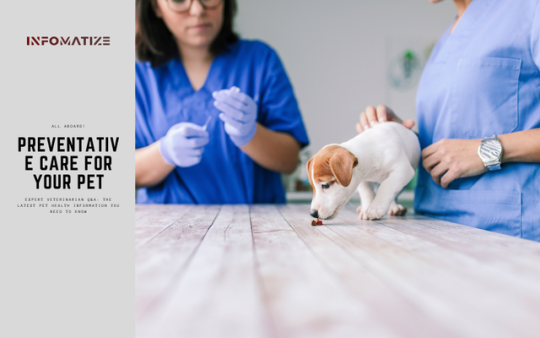
Preventative care for your pet is essential for maintaining their overall health and avoiding unwanted and even life-threatening illnesses. This includes regular visits to your veterinarian for wellness exams, vaccinations, parasite prevention and treatment, and prescription medications . Grooming, dental care, and proper nutrition are also important components of preventative care . The American Animal Hospital Association recommends that you take your pet for a veterinary checkup at least once a year to ensure they receive the necessary preventative care and to promote a long, rewarding relationship between you and your pet . Regular wellness exams can help identify any potential health issues and catch early signs of serious conditions or life-threatening illnesses . Preventive care also includes spaying or neutering, heartworm preventatives, flea and tick control, age-related conditions, and mental and physical stimulation . Additionally, some pet stores hold monthly clinics where they provide examinations, vaccinations, heartworm and/or Lyme tests, FeLV/FIV tests, and antibiotics for your pets . In conclusion, preventive care for your pet involves taking steps to maintain their overall health and prevent health issues from arising. Regular visits to your veterinarian, proper nutrition, grooming, dental care, and parasite prevention are all essential components of preventive care. By taking care of your pet's health, you can help them live a long, healthy, and happy life. The Importance of Regular Vet Visits Regular visits to the veterinarian are crucial for maintaining the health and well-being of your pets . These visits allow your veterinary team to identify potential health problems in the early stages when they are more easily treatable and manageable with medication or lifestyle changes . By keeping up with regular vet appointments, you can help your pet live its healthiest life and prevent potential medical conditions from developing . During a regular veterinary visit, the vet will perform a thorough physical exam, checking for any abnormalities, and may also recommend additional tests if necessary . Additionally, the vet will check your pet's teeth and gums for signs of gingivitis, tooth problems, and other dental health issues, which are crucial for your pet's overall health and well-being . By bringing your pet to the vet annually, you can increase their lifespan, keeping them happy and problem-free . Regular veterinary visits also help vets track how your pet is progressing through life and identify any underlying conditions that your pet may be afflicted with later on, which you may not have been aware of . Read the full article
#Expertadvice#Expertadviceonpethealthfromveterinarians#Expertveterinariananswers#Expertveterinariananswersforpethealth#ExpertveterinarianQ&A#ExpertveterinarianQ&Aforpethealth#Latestpethealthinformation#Latestpethealthinformationfromveterinarians#Latestpethealthupdatesfromveterinaryexperts#Pethealthinformation#Pethealthinformationfromveterinaryprofessionals#PethealthQ&Awithveterinaryexperts#Pethealthquestions#Pethealthupdates#Q&Awithveterinariansaboutpethealth#Veterinaryadvice#Veterinaryadviceforpethealthquestions#Veterinaryprofessionals#VeterinaryQ&A#VeterinaryQ&Aforpetowners
0 notes
Text
Sustainable Fashion Revolution: The Ultimate Guide to Dress Responsibly and Look Fabulous in 2023

Introduction
Sustainable fashion has gained significant attention in recent years, as consumers and brands alike are becoming more aware of the negative impact of the fashion industry on the environment and society. Sustainable fashion refers to the production, use, and disposal of clothing items in an environmentally responsible and socially conscious manner. Here are some key takeaways from the provided web search results regarding sustainable fashion and how it can help us dress responsibly in 2023: - Sustainable fashion is an emerging trend in the fashion industry, but progress remains slow . - Creating a greener wardrobe is a simple step towards sustainability. It involves taking stock of your existing wardrobe, choosing sustainable fabrics, and supporting sustainable brands . - Sustainable fashion brands use natural or recycled fabrics that require less or no chemical treatment, less water, and less energy. Some of the most sustainable fabrics include linen, hemp, organic cotton, and Tencel . - There are several sustainable fashion brands that offer stylish and environmentally friendly clothing options. These brands source upcycled fabrics and eco-minded materials for their clothing, and prioritize ethically sourced and sustainable materials and working conditions. Some of the top sustainable fashion brands include Christy Dawn, Reformation, Cuyana, Amour Vert, Whimsy + Row, and Mara Hoffman . - Sustainable fashion is a key step towards dismantling the fast fashion industry, which is responsible for more greenhouse gas emissions than the shipping and aviation industries combined . - Sustainable fashion is also gaining traction among consumers. A 2020 report on sustainability in fashion found that 67% of shoppers now consider environmentally friendly fabrics when choosing a brand . - The fashion industry is taking steps towards sustainability, such as Copenhagen Fashion Week's sustainability requirements for participating designers, with the goal of setting a new industry standard . In conclusion, sustainable fashion is a key aspect of dressing responsibly in 2023. By choosing sustainable fabrics, supporting sustainable brands, and taking steps towards a greener wardrobe, we can contribute to a more environmentally friendly and socially conscious fashion industry.
Sustainable Materials for Fashion

Sustainable fashion has gained increasing attention in recent years due to the negative environmental impact of the fashion industry. Several sustainable materials can be used in a fashion that minimizes waste, reduces carbon emissions, and conserves natural resources. Some of the most commonly used sustainable materials in fashion include organic cotton, recycled cotton, hemp, linen, bamboo, cork, ECONYL® recycled polyester, Lyocell, Modal, ECOVERO™, Piñatex, and Bananatex® . The fashion industry's conventional raw materials sourcing has contributed significantly to the planet's declining health, including petroleum refining for polyester, water contamination and depletion, soil degradation, and deforestation for industrial cotton and viscose production. Consequently, the industry is turning to sustainable materials that prioritize the environment and promote ethical practices in production. Polyester, which accounts for approximately 65% of all clothing, is produced from fossil fuels and consumes 70 million barrels of oil annually, causing significant pollution to the environment. Similarly, the fashion industry uses considerable amounts of fossil fuel-based plastic for packaging and hangers. Less than one per cent of clothing is recycled to make new clothes, which contributes to significant waste generation in the industry . Wool is another sustainable fabric that can be produced sustainably, depending on how it's made. Climate Beneficial™ Wool produced on carbon farming landscapes captures carbon and puts it back into the soil. Wool is also compostable, insulating, and does not shed plastic microfibers . Several sustainable materials are emerging, and luxury brands are turning to them to respond to customer demand for greener textiles. Examples include mushroom leather and pineapple fabric, which are gaining popularity and could play a significant role in sustainable fashion in the future . Several sustainable fashion brands prioritize using sustainable materials in their production, including Outerknown, which sources 90% of its fibres from sustainable materials such as recycled mango fruit, organic cotton, recycled Polyurethane (PU) leftovers, and environmentally-certified leather. Similarly, Reformation, based in Los Angeles, uses upcycled sneakers made of sustainable materials such as recycled mango fruit, organic cotton, recycled Polyurethane (PU) leftovers, and environmentally-certified leather. . Other sustainable materials include linen and hemp, which were commonly used in clothing in the past. Hemp is three times stronger than cotton, UV-resistant, durable, breathable, and can be grown without fertilizer or pesticides. It also requires less water to grow compared to cotton . Recycled plastic bottles are also a sustainable material used in fashion production, and they are being adopted by many designers due to their eco-friendliness . In conclusion, several sustainable materials are available for use in fashion production, ranging from organic and recycled cotton, hemp, linen, and bamboo to mushroom leather and pineapple fabric. Sustainable fashion brands prioritize The Rise of Recycled Materials in Sustainable Fashion Sustainable fashion has become a growing trend in the fashion industry, and the use of recycled materials is one of the ways that fashion brands are becoming more eco-friendly. Recycled materials, such as organic cotton, hemp, and linen, are being used in fashion lines to reduce waste and carbon emissions. Some fashion brands are even implementing compostable packaging and branding to further reduce their environmental footprint . The use of recycled materials in sustainable fashion is not only beneficial to the environment but it can also be implemented through fair labour practices, such as the Maasai beadwork. Additionally, upcycling, a process that transforms waste and byproducts of manufacturing into new products, has gained popularity in the fashion industry. Designers like Ancuta Sarcas have even started upcycling discarded Nike shoes and high-waste materials like mesh to create unique fashion pieces . The COVID-19 pandemic has further accelerated the demand for eco-friendly fashion. Fashion brands, manufacturers, and traders are looking at more sustainable approaches to meet the market demand for products meeting environmental, social, and governance (ESG) criteria. Carbon emissions reduction is also one of the targets of global efforts to promote sustainable economic development . Overall, recycled materials are becoming increasingly prevalent in a sustainable fashion as designers and brands look for ways to reduce waste and carbon emissions while still producing stylish and unique fashion pieces. Organic Cotton: The Benefits for the Environment and Your Wardrobe Organic cotton is cotton grown without the use of synthetic chemicals such as fertilizers, pesticides, or genetically modified organisms (GMOs). It offers various benefits to the environment and to the people wearing the clothes made from it. One of the most significant benefits of organic cotton is that it requires much less water to grow compared to conventional cotton. The farming process used in organic cotton production relies on rainwater for about 80% of its needs, resulting in approximately 71% less water used overall . Additionally, organic cotton cultivation methods avoid the use of synthetic fertilizers, which can lead to soil degradation and pollution of water sources, ultimately helping to prevent water contamination . Furthermore, organic cotton production methods play a role in mitigating climate change by avoiding the use of synthetic chemicals, reducing energy consumption, and sequestering carbon more efficiently in healthier soils . As such, it has been established that organic cotton cultivation has significant environmental benefits, such as promoting biodiversity, reducing greenhouse gas emissions, and helping to prevent soil erosion and degradation . Aside from its environmental benefits, organic cotton is also better for the farmers who grow it. They are not exposed to harmful chemicals that can cause a range of health problems, including respiratory issues and cancer . Moreover, organic cotton is also softer and less likely to cause irritation than conventional cotton, making it a better choice for those with sensitive skin . In summary, the benefits of organic cotton are numerous, and it is an excellent choice for those looking to reduce their impact on the environment while also supporting the health and well-being of farmers and consumers. The Future of Sustainable Textiles: Innovations and Breakthroughs Sustainable textiles are becoming increasingly important in the fashion industry. Several recent developments suggest that innovative and groundbreaking new textiles are on the horizon. Researchers at MIT are exploring the intersection of textile research and sustainable materials, seeking potential synergies that could advance the field . McKinsey and Company predict that there will be significant growth in sustainable fashion consumption, particularly in products made from more sustainable materials such as organic cotton . Science Daily reports on new textiles that can change shape when heated, potentially offering designers a wide range of new options for responsive and adjustable aesthetics . Drapers Online covers a variety of textile innovations, offering insights into the latest developments in the industry . Finally, the European Commission has launched a roadmap for the future of sustainable textiles in the EU, outlining efforts to increase the circularity of the fashion ecosystem . With these developments and more, it seems clear that sustainable textiles are an area of rapid innovation and growth, and we can expect exciting breakthroughs in the near future.
The Circular Fashion Movement

The Circular Fashion Movement is a growing global trend in the fashion industry that aims to promote sustainable and responsible production and consumption of clothing while reducing the negative impact of the fast fashion industry on the environment and society. Circular fashion involves designing, producing, and using clothes that are meant to be used and circulated responsibly and effectively for as long as possible, and then safely decomposed or repurposed when they are no longer of use to humans . The movement has gained significant momentum in recent years, with numerous fashion brands and organizations committing to circularity commitments and initiatives, such as take-back and resale programs, upcycling, and closed-loop production systems . The Circular Fashion Pledge is a simple concept that asks fashion brands to pledge to one or more circularity commitments by the end of the calendar year, such as enabling take-back or resale programs . Circular fashion has been identified as a key solution to the environmental and social challenges posed by the fast fashion industry, including waste, pollution, exploitation of labour, and depletion of resources . The movement has also gained significant attention and support from sustainability experts and advocates, who believe that it can help to create a more equitable, resilient, and sustainable fashion industry that benefits both people and the planet. Overall, the Circular Fashion Movement represents a growing global trend towards more sustainable and responsible fashion production and consumption and has the potential to revolutionize the way we approach clothing and fashion in the future. Understanding Circular Fashion: What It Is and Why It Matters Circular fashion is a concept that has emerged from the intersection of the circular economy and sustainable and ethical fashion . Essentially, it refers to a system in which all garments can be reused, recycled, or returned to the earth (by virtue of being biodegradable or compostable), reducing the hugely damaging impact the fashion industry has on the planet . In other words, products are designed and developed with the next use in mind, with the aim of keeping resources in use for as long as possible and minimizing waste . The fashion industry has long been known for its negative impact on the environment, including the strain on natural resources, the vast amount of CO2 emissions it produces, and the giant heaps of clothing that end up in landfills . Circular fashion is one solution to this problem, as it aims to reduce the harmful impact of fast fashion by circulating and reusing articles for as long as possible before decomposing them safely . Circular fashion also means using sustainable and natural materials in production, such as organic cotton, bamboo, and Tencel, and avoiding synthetic and plastic fabrics like polyester and nylon derived from fossil fuels . Additionally, the production and transport of items should be powered by renewable energy sources . In summary, circular fashion is a sustainable and ethical approach to fashion that aims to reduce waste and minimize the harmful impact of the industry on the environment. It involves reusing, recycling, and upcycling as much as possible, using sustainable and natural materials, and powering production and transport with renewable energy sources . From Cradle to Cradle: The Principles of Circular Fashion Design Circular fashion design principles are heavily influenced by the cradle-to-cradle (C2C) approach, which is a design framework for creating products that mimic natural systems and support the circular economy. The C2C approach promotes the high-quality use and circulation of biological and technical nutrients, protecting and enriching ecosystems while enabling economic productivity . The aim of the C2C approach is to optimize products from the molecular to modular level and establish these principles in all industry sectors, including the textile industry, consumables, buildings, automotive, packaging, and cosmetics . Circular fashion design principles follow the four principles of the circular economy: preservation of natural capital, optimization of available resources, risk reduction, and renewable flow of resources and products . The principles of circular fashion design also emphasize the importance of planning the entire lifecycle of a product at the design stage, incorporating aspects such as sustainable materials, biodegradability, recyclability, and durability. Circular fashion aims to eliminate waste, pollution and the negative environmental impact of the fashion industry, by designing products for reuse, recycling, and composting . Closing the Loop: How Brands are Embracing Circular Fashion Circular fashion refers to a closed-loop system that rethinks and redesigns the way products are made, used, and discarded to reduce waste and promote sustainability. Many fashion and luxury companies, including LVMH, Kering, H&M, VF Corp, and Gap, have embraced circularity as a way to reduce their environmental footprint . A fully closed-loop apparel recycling system in California could achieve a total holistic impact of $11 billion to $13 billion a year, based on the estimate of the total holistic impact of approximately $5.5 billion to $6.5 billion from closed-loop recycling of polyester, which represents a significant portion of textile production . In order to combat unethical practices in the fashion and textile industry, the industry must embrace a closed-loop system, rethinking and redesigning the way products are made, used, and discarded . Many fashion brands are now working towards closing the loop on waste and promoting circular design, such as Loop Swim, a brand that transforms post-consumer plastic bottles into sun-protective swimwear . In February 2022, Reformation launched RefRecycling, a program that allows customers to return any well-worn Ref goods to the company to be recycled, thus promoting circular fashion and reducing waste .
Ethical and Slow Fashion
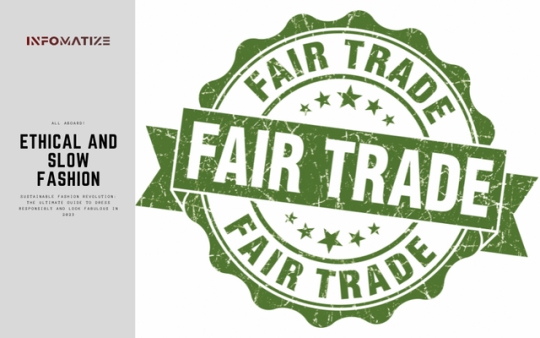
Ethical and slow fashion are two related concepts that are gaining more attention in the fashion industry. While they share some similarities, they also have distinct differences. Ethical fashion focuses on ensuring fair treatment of workers throughout the supply chain, from safe working conditions to fair wages and eliminating child and slave labour . It also considers the treatment of animals, making sure that the materials used in clothing production are cruelty-free . On the other hand, slow fashion is about producing high-quality, timeless clothing that is sustainable and environmentally friendly . Slow fashion leans into sustainable practices, such as using eco-friendly materials and minimizing waste . Both ethical and slow fashion is countercultural, going against the current societal norms that prioritize fast and cheap production over ethical and sustainable practices. Hallmarks of slow fashion include longer production timetables, fewer items produced, and more ethical labour practices, with an emphasis on creating timeless pieces that will stand the test of time . In summary, ethical fashion is focused on the fair treatment of workers and animals throughout the supply chain, while slow fashion is about sustainable and timeless clothing production. Both concepts are aimed at creating a more sustainable and ethical fashion industry, challenging the norm of fast and cheap fashion production. Slow Fashion: The Antidote to Fast Fashion Slow Fashion is an approach to clothing production that takes into account all aspects of the supply chain, including the environmental and social impact, as well as animal welfare. It aims to create sustainable, ethical, and high-quality garments, produced on a smaller scale with more eco-conscious materials and locally manufactured to reduce transportation and promote fair wages for workers . In contrast to fast fashion, where clothing is produced quickly and cheaply with a focus on trends and low prices, slow fashion considers the long-term impact of the production process and encourages consumers to value quality over quantity . If you're interested in adopting slow fashion practices, here are a few tips to get started: - Have a clear-out of your closet and donate or sell the clothes you don't wear anymore to avoid cluttering and promote the use of existing garments . - Buy clothes made from sustainable and eco-friendly materials such as organic cotton, recycled fabrics, or biodegradable fibres . - Choose locally-produced garments to support your community and reduce the environmental impact of transportation . Read the full article
#Consciousfashion#Eco-consciousfashion#Eco-friendlyclothing#Eco-friendlyfashion#Ethicalclothing#Ethicalfashion#Fashionrevolution#Responsiblefashion#Slowfashion#Sustainableclothingbrands#Sustainablefashion#Sustainablefashionbloggers#Sustainablefashionbrands#Sustainablefashionforallages#Sustainablefashionforallbeliefs#Sustainablefashionforallbodytypes#Sustainablefashionforallbudgets#Sustainablefashionforallcelebrations#Sustainablefashionforallclimates#Sustainablefashionforallcultures#Sustainablefashionforallethnicities#Sustainablefashionforallevents#Sustainablefashionforallgenders#Sustainablefashionforallhobbies#Sustainablefashionforallholidays#Sustainablefashionforallinterests#Sustainablefashionforalllifestyles#Sustainablefashionforalllocations#Sustainablefashionforallnationalities#Sustainablefashionforalloccasions
2 notes
·
View notes
Text
Accessorizing Like a Pro in 2023: Expert Tips and Advice to Choose the Right Jewelry, Bags, and Shoes for Any Occasion
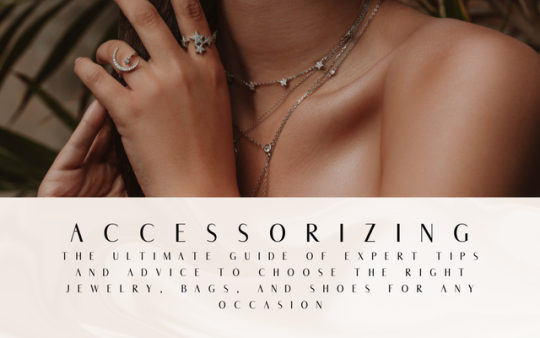
Introduction
Accessorizing is an art that can elevate any outfit to the next level. With so many options available, it can be overwhelming to decide which accessories to choose for a particular occasion. In this ultimate guide of expert tips and advice, we will explore how to choose the right jewellery, bags, and shoes for any occasion. When it comes to accessorizing, balance is key. Adding the right accessories can make even the most basic outfit look glamorous. To start, choose a signature accessory that makes you feel great and can be worn with multiple outfits . When it comes to jewellery, there are four major types: statement earrings, chandelier earrings, delicate earrings, necklaces, and wristwear . When selecting jewellery, consider the neckline of your clothing and choose a necklace that compliments it. It should be visible but not compete with your outfit . Also, think about the focal point of your outfit and try not to overcrowd it with all four types of jewellery . Matching the jewellery to the wedding dress style is also important. As a general rule, your jewellery should complement your dress and not distract from your look . For a navy blue dress, silver jewellery offers a classic touch of sparkle, perfect for celebrating the happy couple . Bags are not just for carrying things, but they can also be a statement accessory. Consider the occasion and choose a bag that is appropriate, such as a clutch for a formal event or a crossbody for a casual outing. When wearing a multicoloured print, pick one of the less prominent colours and add a bag that matches that shade . Shoes are the foundation of any outfit and should complement the rest of your accessories. For example, when overlapping metals, choose a dominant shade and make that your base, and introduce a few contrasting pieces to master . Also, consider the occasion and select shoes that are appropriate, such as heels for a formal event or flats for a casual outing. In summary, accessorizing is all about balance and choosing the right accessories for the occasion. Focus on a signature accessory, match the jewellery to the dress style, choose a bag that is appropriate, and select shoes that complement your accessories. With these expert tips and advice, you can master the art of accessorizing and elevating any outfit.
How to Choose the Right Jewelry for Any Occasion
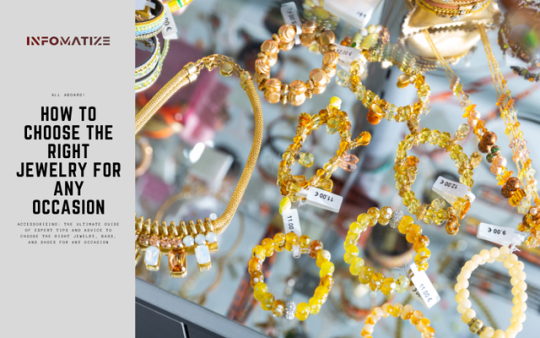
Jewellery is an essential accessory to any outfit, and choosing the right pieces can elevate your look for any occasion. Here are some tips to help you choose the right jewellery for any occasion: - Consider the occasion: Different events require different levels of formality, and your jewellery should match the tone of the occasion. For conservative and formal get-togethers, classic jewellery is more expected, but you can play around with it and mix and match . For casual or day hangouts, pair your outfit with chunky hoop earrings, stacked rings or bracelets, and layered necklaces . For a special occasion or a party, choose your jewellery after deciding on the dress you're going to wear to ensure that your jewellery doesn't clash with the neckline or sleeves. Choose the right necklace according to your neckline and pair it with a matching bracelet and ring to complete the look . - Consider the outfit: Your jewellery should complement your outfit, not compete with it. For low-necked shirts or dresses, wear shorter chains that match the shape of your neckline . When it comes to formal wear, necklaces are important. Check out the neckline of your dress and buy jewellery accordingly . - Mix and match: Mixing different sizes and shapes of jewellery can add dimension to your outfit. Gems, beads, and metal charms can pair together when you keep style and colour in mind. Mix and match the length of your necklaces and the thickness of your bracelets. The key to mixing pieces is to have a common thread . - Consider your skin tone: Choosing jewellery that complements your skin tone can enhance your look. If you don't know where to start, pick silver and diamond jewellery because they complement almost every skin tone. Silver or white gold jewellery will enhance your beauty the most if you have a cool skin tone . - Purchase meaningful jewellery: Giving jewellery as a gift leaves a long-lasting impression on the recipient. Consider adding a personal touch by having the jewellery piece engraved with a personal message or adding a charm of great importance. Personalized jewellery given as a gift always makes a loving gesture . - Stacking rings: Stacking tiny rings on a few fingers is an easy way to keep your fingers jewelled and stylish. Go for a softer finish by leaving some fingers bare or be bold and pick out a few statement rings for every other finger. The placement is completely up to you, so go with what feels right . In conclusion, when choosing the right jewellery for any occasion, it's essential to consider the occasion, outfit, and skin tone. Mixing and matching jewellery pieces and purchasing meaningful Expert Tips for Accessorizing with Necklaces Accessorizing with necklaces can add a touch of elegance and sophistication to any outfit. Here are some expert tips to help you get the most out of your necklace game: - Comfort is key: When choosing a necklace, consider the length, weight, and material of the necklace to ensure it's comfortable to wear for extended periods of time . - Experiment with shapes: When layering necklaces with different shapes, pay attention to how the shapes work together. Layering a pendant with a chain necklace is an easy way to get around that . - Mix textures, thicknesses, and lengths: For a subtle, everyday stack, mixing styles that are close in thickness and length is recommended. This ensures there are plenty of dimensions and your jewellery won't end up in one clump . - Choose a centrepiece: To build around one piece of jewellery such as a statement necklace, ring, or bracelet, can be an easy way to begin accessorizing. This piece would be the focus of your outfit, and then all the other pieces would be minimal . - Avoid over-accessorizing: Keep in mind that less is sometimes more when it comes to accessorizing with necklaces. Avoid over-accessorizing and keep the rest of your jewellery and outfit simple . By following these expert tips, you can elevate your necklace game and add an extra touch of sophistication to any outfit. The Best Earrings to Complement Your Face Shape When it comes to selecting earrings, it's important to consider your face shape to find the best styles that complement your features. Here are some tips and recommendations from various sources: - Match your bone structure to your earrings. Your bone structure will determine the size and weight of the earrings that will look best on you. For example, those with fine bone structures, like Sharon Stone, should go for fine earrings, while those with larger bone structures, like Oprah, can wear larger earrings . - Consider your face shape. Oval faces are the most versatile and can wear any size, width, and length of earrings . Round faces should go for longer earrings to create more length in the face and avoid circular shapes that will further widen the face . Square faces can benefit from rounded and hoop earrings, while heart-shaped faces look great with chandelier or teardrop earrings that balance the narrower chin . Rectangular faces should opt for earrings with rounded edges, such as buttons, hoops, and ovals . - Choose colours that complement your eyes. Earrings can also highlight your eyes, so it's a good idea to select colours that complement them . - Overall, the earrings should complement your personal style and fit your aesthetic . Keep in mind that these are general guidelines and ultimately, you should wear what makes you feel confident and comfortable. Bracelets, Bangles, and Cuffs: How to Choose the Right Arm Candy Bracelets, bangles, and cuffs are popular pieces of jewellery that can add a stylish touch to any outfit. Here are some tips on how to choose the right arm candy for you based on the provided web search results: - Consider which side to wear the bracelet: According to some beliefs, the left side of the body is associated with internal self and healing, so if you want to keep yourself from negative energy or absorb positive energy, you should wear good luck bracelets on your left side . - Experiment with metals and colours: If your skin tone is neutral, you can look great in both silver and gold bracelets and a variety of colours. To choose the right bracelet, hold each one up to your skin to see which particular shades look great against your skin . - Mix and match bracelets: You can create a unique arm candy look by mixing and matching different types of bracelets. For example, you can layer a Pandora Reflexions™ mesh bracelet with your go-to dangle charms and then add a sterling silver Pandora Reflexions™ bracelet to mix things up . - Choose the right type of bracelet: There are different types of bracelets to choose from, including cuff, tennis, wrap, bangle, and link bracelets. Each type has its unique style, and you can choose one based on your preference and the occasion you're attending. Link bracelets are composed of different decorative components connected together to form the entire bracelet. They are often closely linked to the personal sphere of the one who wears it . - Find the right size: It's important to find the right size for bracelets, bangles, and cuffs to ensure they are comfortable and don't slip off your wrist. To measure your wrist, use a tape measure or a strip of paper, then add an extra 2 cm / 0.79 to your wrist circumference measurement to get the recommended size for a comfortable fit .
The Ultimate Guide to Choosing the Perfect Bag

When it comes to choosing the perfect bag, there are a lot of factors to consider. First and foremost, size is key. A larger bag will be more comfortable to wear and will be able to hold more items, but it may also be bulkier and heavier. A smaller bag will be more compact and lighter, but it may not be able to hold as many items . If you're looking for a designer bag but want to economize your purchase, consider buying pre-owned bags from third-party sellers. eBay is a good option for this, as it houses an enormous selection of designer bags. Plus, buying pre-owned is more sustainable and eco-friendly . For a travel bag, size is also an important consideration. A 18x14x8-inch bag is a perfect size for a carry-on bag that will fit in the overhead compartment of most airlines. This size is also great for shorter trips, as it will hold enough clothing and essentials for a few days without being too bulky . When it comes to choosing a backpack, consider the purpose and lifestyle it will serve. There are different backpacks for different needs, whether it's for hiking, commuting, or travelling. Make sure to choose one that is both stylish and functional, made from premium materials, and designed with your needs in mind . For backpacking in particular, the Osprey Farpoint 40 travel backpack is a great option. It's a smaller backpack that hasn't sacrificed comfort and features and is a great price. It has a high rating and is a great 40-litre size . If you're in the market for a designer handbag, consider your personal style and what will work for your daily needs. Some top bag brands include Gucci, Prada, Chanel, and Louis Vuitton. Shoulder bags are currently trending, but consider what will work for you and your lifestyle . For a duffel bag, consider an 80 to 90-litre size for Kilimanjaro packing needs. For commuting, a 50 to 60-litre size is better for smaller duffel bags . When it comes to choosing a sleeping bag, women may want to consider specialized sizes and shapes that are shorter with more insulation and narrower at the shoulders and wider at the hips . Finally, if you're looking for a disc golf bag, consider the Ultimate Disc Golf Backpack with Cooler. This backpack boasts a spacious integrated cooler compartment in the base that can hold up to 12 cans, keeping your drinks and snacks cool during the game . Tote, Clutch, or Crossbody: Which Bag to Choose for Every Occasion Choosing the right bag for different occasions can be challenging. Totes, clutches, and crossbody bags are three popular styles that can work for a variety of events. Here's a breakdown of each style and when to choose them: Tote bags are spacious and practical, making them a great choice for work, school, or travel. They can fit a lot of items, such as laptops, notebooks, and water bottles. Additionally, tote bags come in various styles and materials, from canvas to leather, so you can find one that suits your taste and needs . Clutch bags are elegant and compact, making them perfect for formal occasions, such as weddings or black-tie events. They typically fit only the essentials, such as a phone, keys, and lipstick, but they add a touch of sophistication to any outfit. Clutch bags come in different shapes and materials, from metallic to beaded, so you can choose one that complements your dress . Crossbody bags are versatile and functional, making them ideal for everyday wear or casual outings. They free up your hands and distribute the weight evenly, which can be helpful if you're running errands or travelling. Crossbody bags come in different sizes and styles, from boho to structured, so you can find one that fits your personality . Ultimately, the bag you choose should depend on the occasion and your personal preferences. If you need to carry a lot of items, a tote bag might be the best option. If you're attending a formal event, a clutch bag might be more appropriate. If you want a hands-free option, a crossbody bag might be the way to go. Whatever bag you choose, make sure it complements your outfit and makes you feel confident and comfortable. Expert Tips for Matching Your Bag to Your Outfit Choosing the right bag to match your outfit can sometimes be a daunting task. Here are some expert tips from various sources that can guide you in choosing the perfect bag to complement your outfit: - Consider the Functionality: One of the key things to consider when choosing a bag is functionality . For example, if you need to be hands-free while sightseeing or running errands, a crossbody bag may be a better choice . If you’re going to a formal event, a clutch may be more appropriate . - Match Your Bag To Your Outfit: To match your bag to your outfit, you can choose a bag that features a range of colours and match your outfit to one or two of the smaller areas for a subtle outfit match . You can also play with colours by knowing which colours go well together . - Choose a Material That Complements Your Other Clothes: When choosing a bag, consider the material and texture that complements your outfit. You can select bags and purses in any fabric, and some designers offer a wide range of materials to choose from . - Consider the Occasion: When selecting a bag to match your outfit, it is essential to consider the occasion. For instance, you can pair formal clothes with smaller and elegant bags while going with larger bags for casual outings . Structured day bags in a classic shape best complement ladylike dresses . By following these tips, you can confidently choose the right bag to match your outfit for any occasion. Investment Pieces: The Best Designer Bags Worth the Splurge Investment pieces are a great way to add value and longevity to your wardrobe, and designer bags are no exception. If you're looking for the best designer bags worth the splurge, here are some options to consider: - Chanel 19 Flap Bag: This lambskin quilted bag is a timeless classic and one of Chanel's most sought-after styles . - Louis Vuitton Neverfull: The Neverfull is a classic tote bag that comes in endless material options, as well as limited editions and special artist collaborations . - Chanel 2.55 Flap Bag: This iconic bag is a must-have for any fashion lover and is a great investment piece . - Kiss Leather Cross-Body Bag: This luxury investment bag is a favourite among fashion insiders and has a minimalist design that is perfect for everyday wear . - Chanel 11.12 Bag: Also known as the Chanel Classic Flap Bag, the 11.12 bag is a true classic that has stood the test of time . Investing in a designer bag can be a big decision, but with the right choice, it can be a valuable addition to your collection. Remember to choose a bag that fits your personal style and needs, and to consider factors such as durability, versatility, and brand reputation before making your purchase.
Shoes that Elevate Your Style: Tips and Tricks
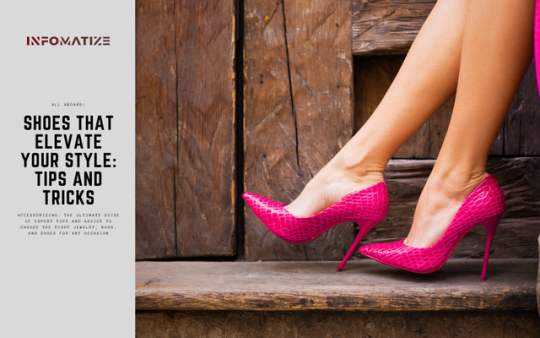
Shoes are an essential part of any outfit, and they can make a significant impact on your overall style. Whether you're looking to elevate your look for a special event or just want to step up your everyday style game, there are plenty of tips and tricks out there to help you choose shoes that elevate your style. One of the most popular shoe retailers that can help you achieve this is Nordstrom. They offer a wide selection of shoes that cater to different occasions and styles, so you can find what you need to elevate your look. If you're looking to elevate your style, there are some shoes you may want to avoid. For example, platform heels can be less chic and less elevated than other options. Instead, consider investing in shoes that flatter your body type and help you feel confident and comfortable. In addition to shoes, there are other ways to elevate your style. For instance, choosing high-neckline clothing pieces can make your outfit more sophisticated and polished. Similarly, investing in good basics can provide a solid foundation for your wardrobe. You can also mix textures and patterns to create a more expensive and stylish look. Accessories like handbags and belts can also help to elevate your outfit. Having a variety of bags and belts to choose from can provide unique and interesting options for different occasions. Belts aren't just for function, they can be fashionable too. There are many small tweaks you can make to your outfit to elevate your look. These can include tucking in or scrunching your shirt, rolling or cuffing your sleeves, or adding a scarf. Layering is another great option, as it can add depth and interest to your outfit. Ultimately, the key to elevating your style is to stay true to yourself and choose items that make you feel confident and comfortable. Don't be a slave to trends, and instead, focus on what works for you and your personal style. Read the full article
#Accessorizingadvicefromexperts#Accessorizingin2023#Accessorizinglikeapro#Accessorizingtipsfromfashionexpertsin2023#andshoes#andshoesforanyoccasion#andshoesforevents#andshoesforfashion-forwardlooks#andshoesforspecialoccasions#Bagandshoecoordination#Bagandshoecoordinationfordifferentoccasions#Bagandshoeselectionfordifferentevents#Bagandshoestylingfordifferentevents#Bagandshoetrends2023#Bagandshoetrendsfor2023#bags#Bagsandshoesforevents#Bagsandshoesforfashion-forwardlooks#Choosingjewelryforoccasions#Choosingtherightaccessoriesfor2023#Essentialaccessoriesforanyoccasion#Essentialaccessoriesforevents#Expertaccessorizingtips#Expertadviceonaccessorizingforevents#Experttipsforaccessorizingin2023#Experttipsforchoosingaccessories#Fashiontipsforchoosingtheperfectaccessories#Fashiontipsforjewelry#Howtochoosetherightjewelryforanyoccasion#Howtomatchjewelry
0 notes
Text
Nail Care in 2023: Tips and Advice for Maintaining Healthy Nails and Achieving Salon-Quality Manicures at Home
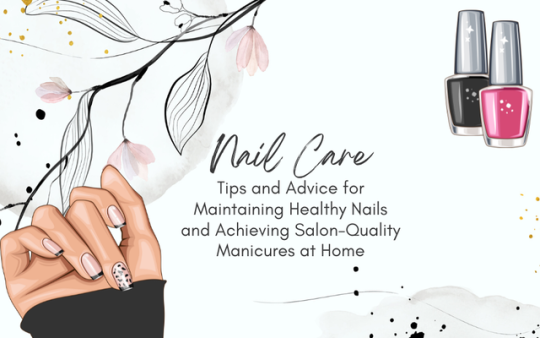
Introduction
Nail care is an essential part of personal grooming and hygiene. Maintaining healthy nails not only keeps them looking tidy and clean but also promotes overall hand and nail health. Neglecting nail care can lead to various problems such as dry, brittle nails, fungal infections, and even more severe health issues . To maintain healthy nails, it is essential to practice proper hygiene and sanitation. The CDC recommends keeping nails short and trimming them regularly, scrubbing the underside of nails with soap and water, and cleaning any nail grooming tools before use . The Mayo Clinic suggests using sharp manicure scissors or clippers and trimming nails straight across, then round the tips in a gentle curve. It is also essential to use moisturizer and apply a protective layer, such as a nail hardener, to strengthen nails . In addition to hygiene and sanitation, nutrition and diet play a crucial role in maintaining healthy nails. A well-balanced diet rich in protein, vitamins, and minerals can help improve nail health and prevent dryness and brittleness . For achieving salon-quality manicures at home, there are several tips and techniques. It is essential to start with clean, dry nails, apply a base coat to protect the nail, use high-quality nail polish, and finish with a top coat to prevent chipping and extend the life of the manicure . In summary, maintaining healthy nails is crucial for overall hand and nail health. Proper hygiene and sanitation, nutrition and diet, and at-home manicure tips are all essential components of nail care. Neglecting nail care can lead to a variety of issues, so it is crucial to incorporate these practices into your daily routine for healthy and beautiful nails .
The Basics of Nail Care
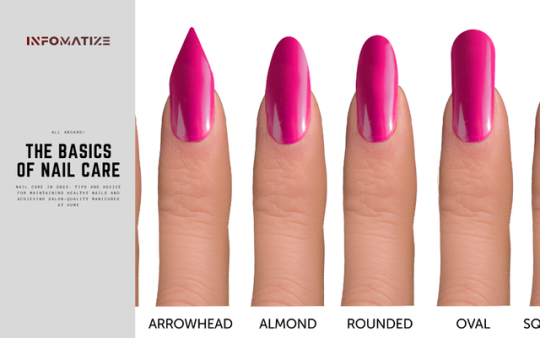
Nail care is an important aspect of personal hygiene that involves maintaining healthy and well-groomed nails. The following tips are recommended for proper nail care: - Keep nails clean and dry by washing them regularly with soap and water. Avoid overexposure to water, which can weaken the nail structure . - Trim nails straight across to avoid ingrown nails, and file the edges gently with an emery board to shape them . - Moisturize your nails and cuticles regularly by applying hand lotion and rubbing it into your nails and cuticles. You can also use nail hardeners to strengthen your nails . - Avoid biting your nails, as it can cause damage to the nail bed and increase the risk of infection . - If you rely on manicures to keep your nails looking good, it's important to understand the dos and don'ts of various nail care products . - To remove dirt and exfoliate any dead skin without harsh, drying chemicals, use a clean toothbrush to scrub your nails and surrounding skin . - To avoid blackening of the nails, be mindful of fungal infections or injuries, and perform nail care after soaking the hands or feet in a basin of warm water for 10-15 minutes to soften the nails . - To slow down the ageing process of your hands, use a moisturizing cream for your hands and nails every day, massaging it into cleaned skin until it's fully absorbed . By following these basic tips, you can ensure that your nails remain healthy and well-groomed. How to Shape Your Nails Like a Pro Shaping your nails properly is an essential part of a good manicure. Here are some tips on how to shape your nails like a pro: - Start by trimming your nails to the desired length using a straight-edge nail clipper . It's best to trim your nails in small sections rather than in one clip . - Once you have trimmed your nails, file them to the desired shape. To file your nails like a pro, use a file perpendicular to the nail and file in one direction . Avoid using a back-and-forth sawing motion as this can weaken your nails and cause them to split . - Choose a nail shape that suits the shape of your nail bed and the length of your fingers. There are many nail shapes to choose from, including square, round, oval, and almond. To achieve the square shape, start by filing your nails straight across the free edge. Next, fill the left side using an up-and-down motion, keeping the file straight. Repeat on the right side . - Once you have achieved your desired nail shape, apply some cuticle oil to all of your nails and rub it into the cuticles and the skin around the nail. This will help to nourish your nails and keep them looking healthy and shiny . By following these simple steps, you can shape your nails like a pro and achieve a salon-worthy manicure at home. For more tips and tricks, check out the video tutorials available on YouTube, such as "How to Shape Your Nails Like a Pro in 3 Easy Steps" by Sally Hansen . The Importance of Cuticle Care Cuticles are the thin layer of skin that covers the base of your nails. Taking care of your cuticles is essential for healthy nails and preventing infections. Here are some key points on the importance of cuticle care from the provided web search results: - Soaking cuticles: Soaking your hands or feet in warm soapy water for 10 minutes every few days can help keep cuticles clean and prevent infection. - Moisturizing cuticles: Cuticles can become dry, cracked, and flaky, just like skin. Applying a good moisturizer to the cuticles is essential for healthy nail growth. Any skin moisturizer can be used. - Practising good nail hygiene: Trimming nails straight across and rounding the tips in a gentle curve, using sharp manicure scissors or clippers, and moisturizing with lotion can help keep nails healthy. Applying a nail hardener might also help strengthen nails. - Hand lotion: Once cuticles have been properly pushed back, applying hand lotion can keep the area moisturized. Nail slugging can also be used to provide added moisture to the cuticles. - Cuticle overgrowth: Neglecting cuticle care can cause cuticle overgrowth. Practice good nail hygiene, which includes soaking and moisturizing your cuticles, and gently pushing back the cuticles with a cuticle pusher. In summary, taking care of your cuticles is crucial for healthy nail growth and preventing infections. Practising good nail hygiene, moisturizing regularly, and pushing back cuticles gently can help maintain healthy cuticles and nails. The Best Nail Strengthening Products for Strong, Healthy Nails If you're looking for nail-strengthening products, there are several options to choose from. Here are some of the best nails strengthening products recommended by experts: - duri Rejuvacote 1 Original Maximum Strength Nail Growth System: This is a popular option for its maximum strength formula that helps promote nail growth while strengthening nails. It can be used as a base coat or a topcoat. - Sally Hansen Mega Strength Hardener: This drugstore option is budget-friendly and helps strengthen nails while also adding shine. It's easy to use and long-lasting. - Orly Nail Defense Nail Strengthener: This is another drugstore option that is a favourite of many due to its strengthening and nourishing properties. It helps prevent breakage and peeling. - Ella+Mila Nail Care Nail Strengthener: This is a 17-free formula that is free of harmful ingredients like formaldehyde, acetone, and more. It helps strengthen nails while promoting healthy growth. - OPI Nail Envy: This formaldehyde-free strengthener contains nail-shielding ingredients that prevent breakage and make nails feel harder. It's a panel favourite and can be used alone or as a basecoat. - Nail care products with nourishing ingredients like cuticle oils, lotions, and more can also help promote healthy nail growth and prevent brittleness. Check out this list of the most effective nail care products recommended by experts.
Achieving a Salon-Quality Manicure at Home

If you're looking to achieve salon-quality nails at home, there are several steps you can take. Firstly, when applying polish, begin with a thin centre swipe and then swipe on either side. You should be able to cover the average nail plate in two to three strokes. Let dry for at least two minutes before applying your second thin coat of polish. If you need a third thin coat for full-colour coverage, go for it . In addition to applying polish correctly, nail filing is important to maintain the uniform length and shape of the nails and can also keep them from breaking or becoming uneven . To achieve salon-quality results at home, you can invest in a variety of tools that file, smooth, shine, shape, buff, and polish your nails . However, it's important to note that achieving a quality at-home manicure can actually be quite a challenge and may take some practice. Between the accidental smudges, chips, and streaks that can occur, it may take some trial and error to find the technique that works best for you . If you're new to DIY manicures, you might want to consider investing in a starter kit that comes with everything you need to create a salon-quality manicure at home. For example, the Sally Hansen Gel Polish Manicure Starter Kit includes a UV lamp, gel nail polish, base and top coat, nail buffer, cuticle stick, and nail cleanser pads . When shaping your nails, avoid soaking them, which can soften nails and cause the polish to chip. Instead, wash your hands and let your nails dry completely before filing them in one direction . There are also many manicure sets available that can help you achieve salon-quality nails at home, such as the Sephora Manicure Nail Tool Kit . If you're interested in gel nail kits, make sure to check whether or not the kit you're considering requires a lamp to cure the nails . Finally, to prepare your nails for polish, gently push back cuticles using a cuticle remover to help soften and dissolve dead skin. Then, use a cuticle stick to gently push your cuticles back. Since cuticles help protect your nails from bacteria, you don't want to cut them - just push them back. Finally, wash your hands with soap and water to remove any leftover lotion . Alternatively, you might want to consider a game-changing device like Nimble, which uses patented pioneering technology to scan, paint, and dry your nails with one device. It claims to provide flawless manicures in 40 minutes and is available 24/7, with no appointments needed . How to Apply Nail Polish Like a Pro To apply nail polish like a pro, follow these steps: - Prep your nails: Remove any old polish and clean your nails thoroughly with soap and water. Dry them completely. - Apply a base coat: Apply a thin layer of base coat to each nail and wait for it to dry before proceeding. - Mix your polish: Roll the bottle between your palms instead of shaking it to mix the polish without creating air bubbles. - Apply the nail polish: Dip the brush into the polish and wipe one side clean. Fan the other side out along the neck of the bottle, and then lightly tap off the excess polish. In one smooth motion, apply the brush to the centre of the nail, from cuticle to tip. Then, swipe it along the left and right sides of the nail. - Apply additional coats: Wait for the first coat to dry, and then apply additional coats as necessary to achieve your desired opacity. - Apply a top coat: Once the last coat of nail polish has dried completely, apply a thin layer of top coat to each nail to protect the colour and add shine. - Clean up excess polish: Dip a cotton bud or ball into nail polish remover and use it to clean up any excess polish around the edges of your nails. To get the perfect manicure, also consider using hacks like applying petroleum jelly around the edges of your nails before painting them and using quick-dry drops to speed up the drying process. You can find more tips and tricks on the OPI Nail Lacquer website . The Best Nail Tools for a Perfect Manicure Achieving the perfect manicure requires the right tools, and there are plenty of options available to choose from. Here are some of the best nail tools for a perfect manicure according to the provided web search results: - Nail Drills - Nail drills like TouchBeauty's Nail Drill and the Rechargeable Nail Drill can be used to shape, buff, and polish your nails with ease. These are especially helpful for those who want to remove gel or acrylic nails. - Manicure Sets - Manicure sets like the Ulta Beauty Nail Kit and the Acrylic Manicure Set come with a variety of tools that are essential for a perfect manicure such as cuticle pushers, nail clippers, and nail files. - Nail Buffers - Nail buffers like the Japanese Nail Buffer can be used to file, smooth, and polish your nails. This particular nail buffer has three sides for different purposes and is great for achieving a glossy, salon-quality finish. It is important to note that the right tools can make a significant difference in the outcome of your manicure. Investing in high-quality tools that are designed specifically for nails can save you time and effort in the long run. Tips for Creating Intricate Nail Art at Home Creating intricate nail art at home can be a fun and creative way to express yourself. With the right tools and techniques, you can achieve salon-worthy results. Here are some tips and tools to help you create intricate nail art at home: First, you'll want to have a base coat, a variety of nail polish colours, and a top coat on hand to create your design. Additionally, consider investing in a few tools to help you create more intricate designs, such as nail art brushes, dotting tools, and stencils . One popular tool for creating intricate nail art at home is nail wraps or stickers, such as ohora Semi Cured Gel Nail Strips. These can be a quick and easy way to achieve a salon-quality look at home . If you prefer to freehand your nail art, there are many design ideas to choose from, such as French tips, polka dots, marbled nails, bright stripes, and more. One technique to try is creating a negative space design, where you leave some parts of your nails unpainted to create a pattern or design . For more intricate designs, try using a striper brush or toothpick to draw lines or shapes on your nails. You can also use a stencil to create a precise design . If you're feeling adventurous, consider trying 3D nail art. You can use individual metallic embellishments and accent shapes to create a bold and unique look . Finally, if you're a nail art enthusiast, consider investing in a dip powder kit, such as the Nailboo Dip Kit Starter. This kit has all of the essentials for a dip powder manicure, which can create long-lasting, intricate designs .
Natural Nail Care Tips
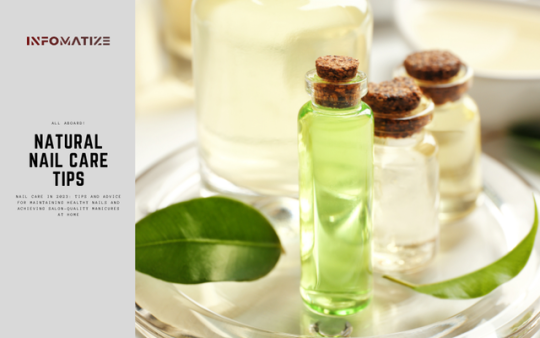
Nail care is an essential aspect of personal hygiene and health. Maintaining healthy and strong nails requires consistent care and attention. Here are some natural nail care tips based on the web search results: - Keep your nails clean and dry: Regularly wash your hands and nails with soap and water to prevent the buildup of dirt and bacteria. Avoid exposing your nails to water for extended periods as this can lead to dryness and brittleness . - Eat a healthy diet: A balanced diet that includes vitamins and minerals such as biotin, vitamin E, and calcium is essential for healthy nails. Vitamin deficiencies can lead to weak and brittle nails . - Trim your nails: Use sharp manicure scissors or clippers to trim your nails straight across and round the tips in a gentle curve. Avoid cutting your nails too short as this can increase the risk of ingrown nails . - Use moisturizer: Rub a moisturizer into your nails and cuticles after washing your hands or whenever you use hand lotion. This helps to prevent dryness and cracking of the nails . - Apply a protective layer: Nail hardeners or base coats can help strengthen and protect your nails from damage. However, make sure to choose a product that does not contain harmful chemicals such as formaldehyde, toluene, or dibutyl phthalate . - Use natural oils: Natural oils such as lavender oil, tea tree oil, and coconut oil have anti-inflammatory and antifungal properties that can help prevent nail infections and promote healthy nail growth. Simply apply the oil to your nails using cotton balls and leave it for 15-20 minutes before rinsing off . - Keep your tools clean: Clean metal tools with soap and warm water after every use to prevent the growth of bacteria and rusting. Store your nail kit in a breathable container such as an envelope to prevent moisture buildup . - Do not remove cuticles: The cuticle is the nail's natural protective seal and should not be removed. Pushing back the cuticles gently using a cuticle pusher is sufficient to maintain healthy nails . By following these natural nail care tips, you can maintain healthy and strong nails without using harmful chemicals or procedures. However, if you notice any changes in your nail's appearance, such as discolouration, swelling, or pain, consult a healthcare professional for advice. How to Make Your Own DIY Nail Care Products If you're looking to make your own DIY nail care products, there are several recipes and tips available online. Here are some popular recipes and methods: - DIY Nail Growth Serum: To make a DIY nail growth serum, grate some orange zest and squeeze out the fresh orange juice. Mix these with olive oil and warm coconut oil in a small bowl. Apply the mixture to your nails and massage it in. - DIY Nail Strengthener: Mix all ingredients in a bowl, then apply the mask to your hands and nails. Cover your hands with cotton gloves and leave them on for 20 minutes. This treatment is recommended to be done once a week. The key to strong nails is a healthy cuticle, which protects new nail growth. - DIY Nail Bleach: To make a DIY nail bleach, mix glycerin and a 3 per cent solution of hydrogen peroxide in an 8-ounce bottle. Fill the bottle with orange flower water, then shake well. Soak your nails in this mixture for about 15 minutes. Repeat as needed. - DIY Nail Polish: To make your own nail polish, mix olive oil and coloured powder in a small pan on low heat. Stir until well-blended. Olive oil helps the polish apply smoothly, but more importantly, it helps strengthen and moisturize the nails. Olive oil can penetrate the skin and nails, providing repair to damaged nails and cuticles. There are also many other DIY nail care recipes and tips available online, including nail masks, cuticle oils, and nail scrubs. It's important to note that these DIY recipes may not have the same effects as store-bought products and may not work for everyone. Additionally, it's important to always do a patch test before using any new product to make sure you're not allergic or sensitive to any of the ingredients. The Benefits of Using Natural Nail Polish Using natural nail polish can offer many benefits to your overall nail health. Read the full article
#Bestnailcareproductsforhomeuse#Bestpracticesformaintaininghealthynails#Brittlenails#DIYnailcare#DIYnailcaretechniques#Essentialoilsfornailhealth#Essentialoilsfornails#Healthynails#Homenailcare#Homeremediesfornailcare#Howtoachievesalon-worthynailsathome#Long-lastingmanicures#Nailcare#Nailcareduringdifferentseasons#Nailcareforacrylicnails#Nailcareforartificialnails#Nailcareforartists#Nailcareforathletes#Nailcareforbeginners#Nailcareforbrides#Nailcareforbrides-to-be#Nailcareforbrittlenails#Nailcareforbusylifestyles#Nailcareforchefs#Nailcareforcomputerusers#Nailcarefordamagednails#Nailcarefordippowdernails#Nailcareforelderly#Nailcareforelderlyindividuals#Nailcareforfrequenthandwashers
0 notes
Text
Haircare Secrets 2023: The Ultimate Guide of Tips and Advice for Choosing the Right Products and Styling Like a Pro
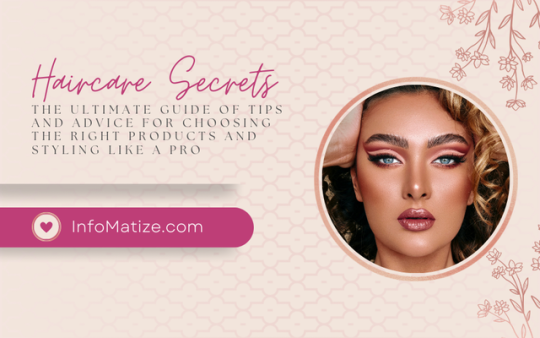
Introduction
Importance of haircare Hair is an important aspect of our overall appearance and can impact our confidence and self-esteem. Proper hair care is essential for maintaining healthy, shiny, and manageable hair. Neglecting hair care can lead to various problems such as dryness, breakage, split ends, and hair loss. Overview of hair types and common hair problems There are various hair types, ranging from straight to curly, and each type has its own unique characteristics and needs. Common hair problems include dryness, dandruff, oily scalp, breakage, and hair loss. Understanding your hair type and common hair problems can help you choose the right products and develop a hair care routine that is best suited to your needs. The objective of the article The objective of this article is to provide tips and advice on how to care for your hair. We will cover topics such as how to choose the right hair care products, how to prevent hair damage, and how to style your hair. Our goal is to help you achieve healthy, beautiful hair and to empower you to take charge of your hair care routine.
Haircare Tips for Different Hair Types
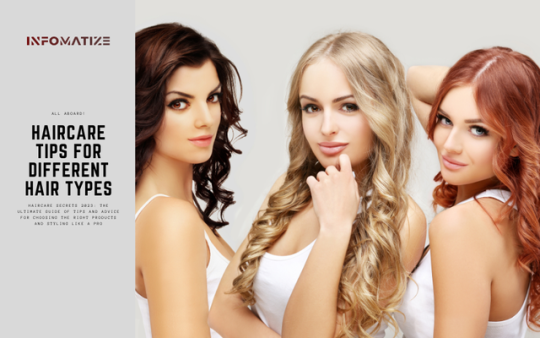
Haircare routines are not one-size-fits-all, as different hair types have unique needs. Here are some haircare tips for various hair types: - Straight Hair - People with straight hair can benefit from using products that add volume and texture to their hair. It is recommended to use mild shampoos and conditioners, as daily washing might not be necessary . - Wavy Hair - Wavy hair is prone to frizz, so it is essential to use moisturizing shampoos and other suitable hair care products to avoid frizz and dryness. Detangling wavy hair is crucial, and people with wavy hair should use a wide-toothed comb for wet and damp hair. - Curly Hair - People with curly hair should avoid daily washing, as it can strip natural oils from their hair, which can lead to dryness and breakage. It is recommended to use sulfate-free shampoos and conditioners and apply hair masks regularly. Finger detangling is recommended, and people should avoid using brushes and combs on their curls. - Coily Hair - Coily hair needs lots of moisture to prevent breakage, so it is recommended to use leave-in conditioners and oil-based products. Deep conditioning treatments are also beneficial. People with coily hair should avoid using heat-styling tools and use a wide-toothed comb or their fingers to detangle their hair. Regardless of hair type, people should avoid hot water when washing their hair, as it can strip essential oils from the hair. Lukewarm water is recommended instead . It is also important to protect hair from heat and sun damage, by wearing protective hairstyles or a hat when going outside . In conclusion, different hair types have unique needs, and people should tailor their hair care routines to their specific hair types. Using the right hair care products, avoiding hot water when washing, and protecting hair from heat and sun damage can help maintain healthy and beautiful hair. Understanding the Different Hair Types: A Comprehensive Guide Understanding the Different Hair Types: A Comprehensive Guide can help you to identify and care for your hair better. According to the search results, there are different hair types, and they are categorized into four main types: Type 1 (Straight), Type 2 (Wavy), Type 3 (Curly), and Type 4 (Coily) . Each of these types has its subtypes and characteristics. Type 1 (Straight) hair lies flat on the scalp, has no curl pattern, and can be of varying thicknesses. There are three categories of straight hair: Type 1A, which is thin and fine; Type 1B, which is medium thickness and has some volume; and Type 1C, which is coarse and thick . Type 2 (Wavy) hair has an "S" shape and ranges from loose, beachy waves to defined spiral curls. This hair type has three subcategories: Type 2A, which is fine and tends to be straight at the roots and wavy at the ends; Type 2B, which is medium thickness and has a more defined wave pattern; and Type 2C, which is thick and has a strong wave pattern with some curls . Type 3 (Curly) hair has a definite curl pattern, ranging from loose spirals to corkscrew curls. It has three subcategories: Type 3A, which has large, loose curls; Type 3B, which has tight, springy curls; and Type 3C, which has corkscrew curls that are tighter and more defined . Type 4 (Coily) hair has a very tight curl pattern, ranging from tightly coiled to kinky curls. It has three subcategories: Type 4A, which has tightly coiled curls that are the size of a crochet needle; Type 4B, which has a "Z" shape pattern and bends in sharp angles; and Type 4C, which has a zig-zag pattern and is tightly coiled and fragile . Apart from the type and subtype, there are other factors to consider when caring for your hair, such as individual strand shape, thickness, and porosity. Understanding your hair type can help you select the right products, treatments, and styling techniques to maintain healthy and beautiful hair. Best Haircare Practices for Curly Hair: Tips and Tricks Curly hair requires special care and attention to keep it healthy and looking its best. Here are some best hair care practices for curly hair that you can follow: - Determine Your Hair Type: To learn how to best manage your curls, you first need to discover the diameter of your hair, aka your hair type. Your hair type refers to how curly your hair is and how much space is in between each curl. There are four hair types: type 2 (wavy), type 3 (curly), and type 4 (coily/kinky). - Use a Gentle Touch: Avoid brushing your hair when it's dry, and use a detangler when brushing to avoid pulling and yanking. Try not to tie your hair back into tight ponytails or buns, which can cause breakage and split ends. Instead, use soft, scrunchies or satin hair ties. - Condition and Moisturize: Curly hair tends to be dry, so it's important to condition and moisturize your hair regularly. Instead of wetting hair, take a small amount of conditioner and apply it to the mid-lengths and ends of hair to refresh, remoisturize, and revitalize curls. The conditioner acts as lotion does for your skin. - Protect Your Hair: Avoid excessive heat stylings, such as blow drying and flat ironing, as this can cause damage and make your curls frizzy. If you must use heat, use a heat protectant spray and low heat settings. Consider using a silk pillowcase to reduce frizz and breakage while you sleep. - Try the Pin-Up Method: For a curlier look on dry or second-day hair, try the pin method. Starting at the crown, wrap a section of hair around your finger, slide the finger out, hold the coil with your other hand, and insert a clip at a right angle. After the hair is dry, gently remove the clips and loosen the curls with your fingers. Finish with a tilt and scrunch. - Choose Hair Products Wisely: Look for hair products specifically designed for curly hair, such as shampoos, conditioners, and styling products. Avoid products containing harsh chemicals like sulfates and alcohol, which can strip your hair of natural oils and cause damage. Opt for products with natural ingredients, such as aloe vera, shea butter, and coconut oil, to help moisturize and nourish your hair. Straight Haircare: Products and Techniques for a Sleek Look Achieving a sleek, straight look requires specific haircare products and techniques. Here are some tips and tricks to get started: - Use a hair-straightening product: Products like Bumble and Bumble Bb can help make curly hair more manageable, while also protecting it from heat damage. Look for products with ingredients like keratin or argan oil, which can help smooth the hair. - Deep-condition your hair: Use a hair mask with ingredients like raw egg, manuka honey, or avocado to restore protein to your hair and make it more relaxed . This can help prevent frizz and make it easier to straighten. - Air dry your hair: Letting your hair air dry a bit before blow-drying can lead to better results . It can also reduce damage from heat styling. - Brush your hair carefully: Limit hair brushing to twice a day to prevent damage and frizz . Use a wide-toothed comb to detangle your hair, starting at the ends and working your way up. - Use a straightening treatment in the shower: Wash with a shampoo that helps smooth hair or combine with a treatment that helps straighten hair, like Garnier Fructis Sleek Shot In-Shower Styler . This treatment can help straighten hair without a flatiron and reduce sleeking time. By following these tips and using the right products, you can achieve a sleek, straight look while protecting your hair from damage.
Professional Haircare Routines for Everyday Use
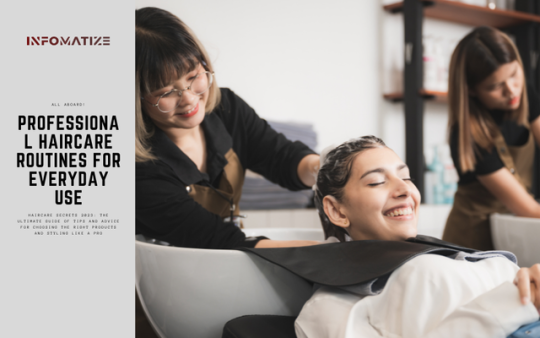
Maintaining a professional haircare routine for everyday use is crucial for keeping your hair healthy and beautiful. Here are some tips and recommendations based on the various sources: - Concentrate on cleaning primarily the scalp while washing your hair, rather than washing the entire length of hair. This will prevent flyaway hair that is dull and coarse. Use conditioner after every shampoo, unless you use a 2-in-1 shampoo that cleans and conditions hair. - Moisturize and seal your hair. This process involves using a moisturizing product followed by a sealing product to lock in the moisture. This can be particularly useful for kinky or coily hair. - Use lukewarm water to wash your hair and cool water to rinse. Using hot water can strip your hair of essential oils, leaving it feeling dry and looking dull. - Air-dry your hair 75% before styling. Wet hair is vulnerable to stretching and breaking, which can lead to damage. - Use a mild, sulfate-free shampoo to preserve your hair's natural oils. Harsh shampoos can strip your hair of oils and cause dryness and damage. Wash your hair only twice a week to prevent dryness and damage. You can co-wash (wash your hair with conditioner) every alternate day to cleanse your hair without drying it. - Use professional haircare products suitable for everyday use, such as Nexxus Moisturizing Shampoo and Conditioner, which are hydrating and free of harmful ingredients. Other recommended products include Olaplex No. 4 Bond Maintenance Shampoo, which pairs well with Olaplex No. 3 Hair Perfector and Olaplex No. 5 Bond Maintenance Conditioner. Remember to choose a haircare routine that suits your hair type and lifestyle. Whether you prefer to visit a salon or style your hair at home, maintaining a professional hair care routine is important for healthy and beautiful hair. A Busy Girl's Guide to Haircare: 10-Minute Routines As a busy girl, you might find it challenging to maintain a hair care routine that fits into your schedule. However, with some planning and the right products, you can have healthy, beautiful hair without spending hours in front of the mirror. Here are some tips for a 10-minute hair care routine: - Use a good-quality hair dryer with adjustable heat . It will save you time and help you style your hair quickly. - Apply conditioner to the mid-shaft of your hair to the ends, massaging the product into the hair. Depending on the type of conditioner, leave it in for a few minutes before rinsing . - Instead of shampooing your hair every day, aim to wash your hair two to three times a week, depending on your hair type . This will help prevent your hair from drying out and keep it healthy. - Apply a leave-in conditioner to your damp hair to detangle and moisturize it . This will save you time in the morning, as you won't have to spend as much time brushing out tangles. - If you have curly hair, use a diffuser attachment on your hair dryer to dry your hair. Scrunch in some gel, air dry for 10-15 minutes to help the curl pattern set, and diffuse until dry . - Protect your curls at night by sleeping on a satin pillowcase or wrapping your hair in a silk scarf . - Use dry shampoo to refresh your hair between washes . This will save you time in the morning, as you won't have to wash and style your hair every day. - Experiment with different hairstyles that can be done quickly, such as a messy bun or a ponytail . - Use a deep conditioner once a week to nourish and moisturize your hair . Apply it to your hair and let it sit for 45 minutes, then shampoo and rinse. For added hydration, allow the deep conditioner to soak in for 10-15 minutes under a steamer or 15-20 minutes under a dryer, then rinse it . - Remember to listen to your hair and adjust your routine as necessary. Your hair will likely react differently than a friend's hair to certain products and care . Low Maintenance Haircare: Tips for a No-Fuss Hair Routine Maintaining healthy hair can often feel like a daunting task, but it doesn't have to be! For those with a busy lifestyle, incorporating low-maintenance hair care practices into your routine can help keep your hair looking healthy and fabulous with minimal effort. Here are some tips from hair care experts and enthusiasts to help you streamline your hair routine: - Opt for air-drying or minimal heat styling to reduce heat damage. To enhance natural waves, gather hair into two loose buns high on your head and use a dryer to wave around them, then let hair cool and release ]. - Use lukewarm water to wash your hair and cool water to rinse to prevent over-drying your hair ]. - Incorporate weekly treatments to strengthen and nourish your hair, such as a hair mask or leave-in conditioner ]. - When styling, avoid using excessive styling products and keep them away from your roots. If you encounter unruly pieces, pin them back instead of piling on more products ]. - Try the tension method of holding a section of hair taut while drying to reduce the need for heat styling ]. By implementing these low-maintenance hair care practices, you can simplify your hair routine and still maintain healthy and gorgeous locks. Salon-Quality Hair at Home: Step-by-Step Haircare Routine Achieving salon-quality hair at home requires a consistent and effective hair care routine. Here are some steps to follow to help you achieve that perfect look: Step 1: Shampoo or dry shampoo your hair, depending on your hair type and the number of natural oils in your hair. Use a sulfate-free shampoo to avoid stripping your hair of its natural oils . Step 2: Use lukewarm water to wash your hair and cool water to rinse. Hot water can damage your hair cuticles by opening them too much and allowing moisture to leach out of your hair shaft . Step 3: Apply a thickening or volumizing spray to the roots of your hair to give your hair a lift and that professional quality look . Step 4: Deep condition your hair at least once a week using a hair mask, either store-bought or homemade, to strengthen and moisturize your hair . Step 5: Apply a hair oil or serum to the mid-lengths and ends of your hair to add shine, moisture, and protection from heat damage. Use a generous amount of the product and make sure it contains UV protection and bond-building properties . Step 6: Secure your hair at night with a simple ponytail or plait to prevent tangling and damage while you sleep . By following these steps, you can create a salon-quality hair care routine at home that will leave your hair looking healthy, shiny, and beautiful.
Choosing the Right Haircare Products for Your Hair
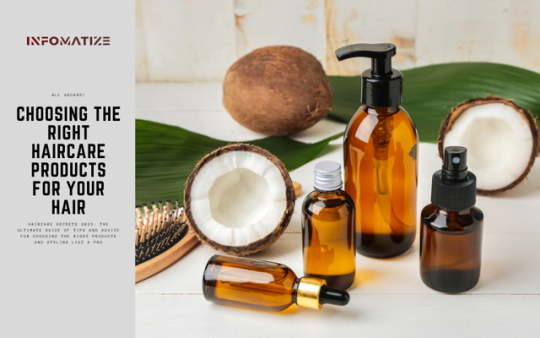
Choosing the right hair care products can be a daunting task, but it is essential to maintaining healthy and beautiful hair. Here are some tips based on the provided web search results to help you choose the right hair care products for your hair: - Determine your hair type: Identifying your hair type (e.g., curly, straight, oily, dry, fine, thick) is the first step in selecting the right hair care products. This will help you choose products that are specifically designed for your hair type. - Know your hair concerns: In addition to hair type, understanding your specific hair concerns (e.g., frizz, breakage, dryness, dandruff, colour-treated hair) will also guide you in selecting the right products. - Look for ingredients that target your hair concerns: Once you know your hair type and concerns, look for hair care products that contain ingredients that target those concerns. For example, if you have dry hair, look for products with moisturizing ingredients like shea butter, jojoba oil, or coconut oil. - Avoid harmful ingredients: Avoid hair care products that contain harmful ingredients like sulfates, parabens, and silicones, as they can strip the hair of natural oils and cause damage. - Experiment with different products: Don't be afraid to try different products to find the ones that work best for your hair. Consider trying sample sizes or travel-sized products before investing in full-sized products. - Layer products correctly: When using multiple hair care products, layer them in the correct order. Typically, the order is shampoo, conditioner, leave-in conditioner/detangler, styling products (e.g., mousse, gel, cream), and finishing products (e.g., oil, hairspray). By following these tips, you can choose the right hair care products for your hair type and concerns, and achieve healthy and beautiful hair. Finding the Perfect Shampoo and Conditioner for Your Hair Type Finding the perfect shampoo and conditioner for your hair type can be a daunting task, but with the right information, it doesn't have to be. After analyzing the web search results, here are some suggestions for selecting the best shampoo and conditioner for different hair types. For full hair, Living Proof Full Shampoo is a gentle formula that can remove residue and buildup, repel dirt and oil, and ensure maximum fullness and body . If you're looking for a shampoo for frizzy hair, the John Frieda Frizz Ease Dream Curls Curl Defining Shampoo is a sulfate-free and curl-friendly option that has received great reviews from judges . For dry scalp issues, it is recommended to use shampoos that promote moisture, smoothing, and hydration while avoiding volumizing, fortifying, and strengthening formulas. Shampoos with tea tree oil and menthol can also help retain moisture, and Nioxin shampoo is a good option for severe dry-scalp issues. Additionally, it is recommended to stay away from formulas with sulfates . Olaplex No. 4 Bond Maintenance Shampoo is another great option for different hair types. This shampoo can be paired with Olaplex No. 3 Hair Perfector and Olaplex No. 5 Bond Maintenance Conditioner to help repair damaged hair and maintain its health . Read the full article
#Australia#Austria#Belgium#Canada#Choosinghairproducts#Choosingthebesthairproducts#Choosingthebesthaircareproducts#Choosingtherighthairproducts#Denmark#Expertadviceforchoosinghairproducts#Expertadviceforhaircare#Experthaircareadvice#Experttipsforhaircare#Finland#France#Germany#Hairstylinglikeapro#Hairstylingsecretsfor2023#Hairtipsandadvice#Haircarefor2023#Haircareforallhairtypes#Haircareforbeautifulhair#Haircareforgorgeoushair#Haircarein2023#Haircaresecrets#Haircaresecrets2023#Haircaresecretsfor2023#Haircaresecretsforbeautifulhair#Haircaresecretsforgorgeoushair#Haircaresecretsforhealthyhair
0 notes
Text
Skincare Tips 2023: Your Comprehensive Guide to Choosing the Right Products and Cleansing for Glowing Skin.
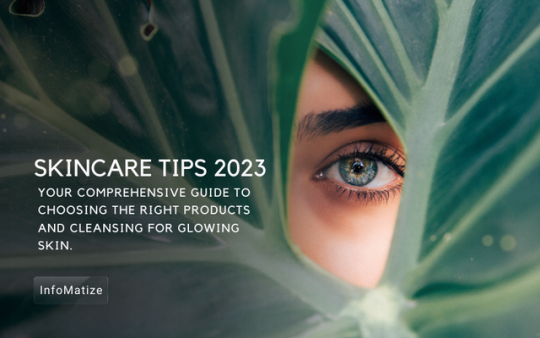
Introduction
Skincare is an essential part of maintaining healthy and glowing skin. With the constantly evolving skincare industry, it can be challenging to know what products and techniques to use. However, with the right information and knowledge, you can achieve your desired results. Here are some tips on how to choose the right products and cleansing techniques to achieve glowing skin in 2023. - Cleanse your skin properly: Cleansing is an essential step in any skincare routine, and it is crucial to do it correctly. Use a gentle cleanser that is suitable for your skin type and avoid harsh scrubs that can damage your skin . Consider using an alpha hydroxy acid cleanser if you have brown spots or melasma . - Use a toner: Toning can help balance your skin's pH levels and prepare it for the rest of your skincare routine. Avoid toners that contain alcohol and instead choose a toner that contains gentle ingredients . - Choose the right products: It's essential to choose products that are suitable for your skin type and address your specific concerns. Look for products that contain ingredients such as vitamin C, vitamin E, retinol, and niacinamide, as they can help improve the appearance of your skin . - Avoid using too many products: Layering on too many products can irritate your skin. Focus on the basics, such as a gentle cleanser, sunscreen, and moisturizer. Establish a morning and nighttime skincare routine that works well for your skin, and stick with it . - Test new products carefully: When incorporating new products into your skincare routine, it is best to start slow and test each product one at a time to see how your skin reacts. This will help you avoid any adverse reactions and find the right products for your skin . - Consider vitamin drips: In 2023, luxury skin clinic Ouronyx is introducing an exciting new generation of vitamin drips that work on all skin types . These vitamin drips can help improve the appearance of your skin and boost your immune system. By following these tips, you can choose the right products and cleansing techniques to achieve glowing skin in 2023. Remember, skin care is not a one-size-fits-all approach, and it may take some trial and error to find the right products for your skin type and concerns.
Understanding Your Skin Type
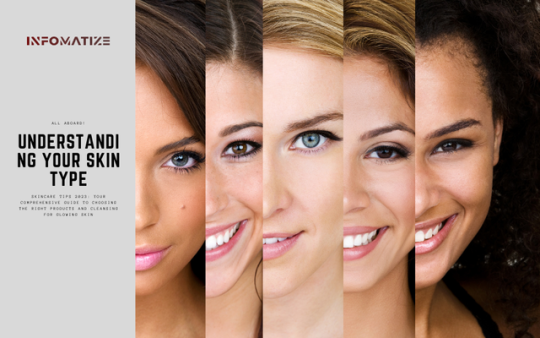
Understanding your skin type is an essential step in developing a skincare routine that suits your needs. Your skin type determines how it reacts to different environmental factors, what types of products work best, and what types of problems it may be prone to. Here are some key takeaways from the provided search results on understanding your skin type: There are several different skin types, and it is possible to have multiple skin types at once . The most common skin types include oily, dry, combination, normal, and sensitive skin . One way to determine your skin type is to observe how it behaves over the course of a typical day . Dry skin may feel tight and rough, while oily skin may appear shiny and be prone to breakouts . Combination skin is oily in some areas and dries in others, such as the T-zone and cheeks respectively . Sensitive skin may be easily irritated by certain products or environmental factors and may appear red or inflamed . It is important to take good care of your skin regardless of your skin type . This may include using a broad-spectrum sunscreen to protect against UVA and UVB rays , applying moisturizer to dry skin , and using products specifically formulated for your skin type . In addition to understanding your skin type, it is important to be aware of other risk factors for skin cancer, such as sun exposure and family history . If you have concerns about your skin or notice any changes, it is a good idea to consult a dermatologist . Overall, understanding your skin type is an important step in developing a personalized skincare routine that will help you maintain healthy, glowing skin. How to Determine Your Skin Type in 2023 Determining your skin type is an essential step in creating an effective skincare routine that meets your specific needs. Here are some ways to identify your skin type in 2023: - Observe your skin throughout the day: One of the easiest ways to determine your skin type is to observe how it behaves from morning to evening on a typical day. If your skin appears shiny throughout the day, you likely have oily skin. If it feels tight and is flaky or scaly, you likely have dry skin. If the shine is only in your T-zone, you probably have combination skin. If your skin feels hydrated and comfortable, but not oily, you likely have normal skin . - Apply a moisturizer to dry skin: Apply a fragrance-free cream to the dry areas on your skin. If your skin still feels dry and tight after a few minutes, you likely have dry skin. If your skin feels hydrated and comfortable, you likely have normal skin. If your skin feels oily, you likely have oily skin . - Consider the Fitzpatrick scale: The Fitzpatrick scale is commonly used to describe a person's skin type and tone, particularly in terms of how it responds to light. Developed in 1975, the scale includes skin types I-VI. Types I and II refer to fair skin that burns easily, while types V and VI refer to dark skin that rarely burns. Skin types III and IV falls in between. This scale can help you understand your skin's response to the sun and guide your sun protection measures . - Become an expert on your own skin: Getting acquainted with your skin's needs and behaviours will inform your entire skincare routine. From choosing the right sunscreen or cleanser, it's up to you to become an expert on your own skin. Finding a routine that works for you, making your skin look its best, and keeping it healthy should be your ultimate goal . In summary, determining your skin type requires observation, trial and error, and knowledge about the Fitzpatrick scale. By becoming an expert on your own skin, you can develop a skincare routine that is customized to your specific needs and help you achieve healthy, glowing skin in 2023. Skincare Products for Dry Skin in 2023 If you have dry skin, using the right skincare products can help keep your skin hydrated and healthy. Here are some skincare products for dry skin that may be worth considering in 2023: - First Aid Beauty Ultra Repair Cream Intense Hydration: This moisturizer contains dimethicone, which is known to help reduce water loss from the skin and is recommended by dermatologists for acne-prone skin. It also contains colloidal oatmeal, which can help soothe and hydrate dry skin. - Vanicream Moisturizing Cream: This moisturizing cream is free of fragrances, dyes, and other potential irritants, making it a good choice for those with sensitive skin. It is also formulated to help soothe dry, itchy skin. - Drunk Elephant Protini Polypeptide Firming Cream: This cream is formulated with a blend of proteins and peptides that can help improve the appearance of fine lines and wrinkles, while also providing hydration to the skin. It is a good choice for those with dry, mature skin. - EltaMD Moisture-Rich Body Crème: This body cream is formulated to provide intense hydration to extremely dry skin. It contains a blend of ceramides, hyaluronic acid, and enzymes to help soothe and hydrate the skin. - Weleda Sensitive Care Facial Cream: This facial cream is formulated with almond oil and other natural ingredients to help soothe and hydrate sensitive, dry skin. It is also free of synthetic fragrances and other potential irritants. In addition to these products, the skincare trend for 2023 is skinimalism, which means that people will focus on using a smaller number of high-quality products that are tailored to their specific skin concerns, rather than a large number of products that may not be necessary. Skincare Products for Oily Skin in 2023 There are several skincare products that could be useful for oily skin in 2023. - Ole Henriksen Balancing Force Oil Control Toner is a dermatologist-recommended product that can help reduce oil and sebum production in oily skin. It contains salicylic acid and AHAs to exfoliate and refine pores, while also reducing oiliness. - The Therabody TheraFace Pro is a cordless facial therapy massager that uses microcurrent technology to firm and tightens facial skin. It is a useful tool for those with oily skin as it can help reduce oil production and improve the overall appearance of the skin. - The LilyAna Naturals Collagen Building Complex Face Cream is a lightweight, hydrating option that can minimize the signs of ageing without clogging pores. It contains collagen, hyaluronic acid, and other ingredients that help nourish and protect oily skin. - The Derm Review lists a range of products that can help with oily skin, including the Caudalie Vinopure Natural Salicylic Acid Pore Minimizing Serum, the Neutrogena Oil-Free Acne Wash, and the Mario Badescu Drying Lotion. These products can help unclog pores, reduce oil production, and prevent breakouts. - Finally, Real Simple recommends the Dr Dennis Gross Skincare Alpha Beta Extra Strength Daily Peel Pads for oily skin. These pads contain glycolic acid, lactic acid, malic acid, retinol, resveratrol, and green tea extract, which create an effective two-phase system that keeps the skin radiant while tackling signs of ageing. They can also help control oil production and prevent breakouts. Overall, there are many skincare products available that can help oily skin in 2023, ranging from toners and serums to tools and peel pads. It's important to find products that work best for your specific skin type and concerns.
Choosing the Right Skincare Products
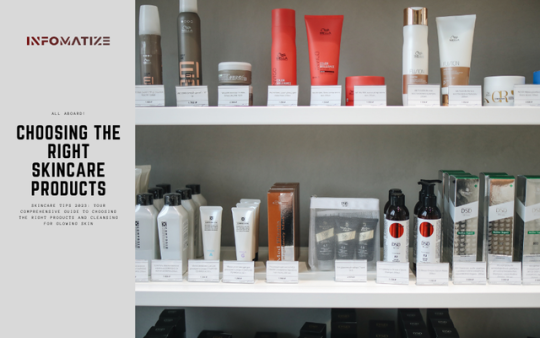
Choosing the right skincare products can be overwhelming, especially with the plethora of options available in the market. However, understanding the ingredients, the order in which to apply them, and your skin type can help you select the best products for your needs. One approach is to consider a few key ingredients that have been found to be effective in skincare. For example, vitamin C and vitamin E work well together to protect and repair the skin, while retinol stimulates collagen and helps to reduce the appearance of fine lines and wrinkles . Niacinamide, also known as Vitamin B3, is another ingredient to look for as it helps to improve skin texture, reduce the appearance of pores, and brighten the skin . To determine which products are best for you, consider taking a skincare quiz that can help you identify your skin type and specific concerns . Once you know your skin type, you can select products that are formulated for it. For example, if you have oily skin, look for a lightweight, oil-free moisturizer. If you have sensitive skin, choose products without added fragrances or harsh ingredients . It's also important to consider the order in which you apply your skincare products. Generally, you should start with a cleanser, follow up with a toner, then apply any serums or treatments, and finish with a moisturizer and sunscreen . If you're new to skincare, start with the basics and build your routine as needed. Finally, make sure to check the expiration dates of your products and avoid using expired skincare as it can cause skin irritation and infection . Overall, it's important to choose products that work well for your skin type, and that address your specific concerns. With a little research and experimentation, you can find a skincare routine that works best for you. Importance of Ingredient Lists in Skincare Products in 2023 As the skincare industry continues to evolve, one important aspect that consumers should consider is the ingredient list of the products they use. In 2023, skincare ingredient trends will continue to emerge, and it is essential to understand the importance of ingredient lists to make informed decisions when selecting products. The first step to achieving healthy skin is understanding the ingredients in your skincare products. According to skincare experts, one of the essential ingredients in skincare products in 2023 will be emblica extract, which is derived from the Indian gooseberry or Amla . This extract has been used in Ayurvedic medicine for many years and is known for its powerful antioxidant properties. Another important ingredient that skincare experts predict will be popular in 2023 is niacinamide, which has anti-inflammatory properties and helps to reduce redness and inflammation in the skin . When it comes to choosing skincare products, it is crucial to read the ingredient list carefully. According to skincare experts, smart ingredients and sustainable products will be trends in 2023 . Consumers should look for products that contain natural ingredients and avoid harsh chemicals that can damage the skin. Skincare products that include mushroom extracts and peptides are also becoming popular . Moreover, with the trend of "skinimalism," consumers are expected to opt for highly curated arsenals with fewer products in their skincare routine. In 2023, it is expected that maximalist morning skincare routines will give way to simpler routines . By reading the ingredient list, consumers can choose products that are tailored to their skin's unique needs and avoid unnecessary products that can cause irritation. In conclusion, understanding the importance of ingredient lists in skin care products is crucial for making informed decisions about which products to use. As the skincare industry continues to evolve in 2023, consumers should look for products that contain natural ingredients, avoid harsh chemicals, and consider ingredients like emblica extract and niacinamide. By paying attention to the ingredients in skincare products, consumers can help to achieve healthy and radiant skin. How to Choose Skincare Products for Aging Skin in 2023 As we age, our skin requires more specific and targeted care to keep it looking youthful and healthy. To choose the best skincare products for ageing skin in 2023, you should consider factors such as the ingredients, formulation, and consistency of the product. Here are some tips based on the various source: - Look for anti-ageing ingredients: Ingredients such as retinol, vitamin C, hyaluronic acid, and glycolic acid can help to reduce fine lines and wrinkles, hydrate the skin, and improve skin texture . - Consider the product formulation: Some products, such as retinol creams, maybe too strong for sensitive skin, so it's important to consider the formulation of the product before using it. Look for products that are specifically formulated for ageing skin and are gentle on the skin . - Choose products with a good consistency: As we age, our skin tends to become drier and thinner, so it's important to choose products with a thicker, more emollient consistency to help hydrate the skin and lock in moisture. Look for products such as moisturizers, serums, and creams with a rich, nourishing texture . By considering these factors and doing some research on the specific products you're interested in, you can choose the best skincare products for your ageing skin in 2023, and keep your skin looking youthful and healthy. Understanding Acne-Fighting Ingredients in Skincare Products in 2023 When it comes to choosing skincare products for acne-prone skin, it's important to understand the acne-fighting ingredients in those products. Benzoyl peroxide, salicylic acid, and retinoids are three of the most commonly recommended ingredients for treating acne . Salicylic acid is an anti-inflammatory ingredient that helps unclog pores, while benzoyl peroxide is an antibacterial ingredient that can kill acne-causing bacteria. Retinoids, which are derived from vitamin A, work to minimize oil production in the skin and help unclog pores as well. Additionally, glycolic acid, lactic acid, malic acid, resveratrol, and green tea extract are ingredients that can help keep the skin radiant while also addressing signs of ageing in a two-phase system . When choosing skincare products for acne-prone skin, it's important to start with a clean slate by thoroughly cleansing your face to remove dirt, oil, and makeup . A gentle cleanser containing salicylic acid or other anti-acne ingredients can be especially beneficial for unclogging pores. In addition to cleansers, moisturizers containing ingredients like propolis, green tea, aloe, and allantoin can provide light hydration and have anti-inflammatory properties with healing benefits . Overall, understanding the ingredients in skin care products and how they work to fight acne can help in choosing effective products for acne-prone skin. It's always a good idea to consult with a dermatologist for personalized advice and treatment options.
Skincare Routine Tips
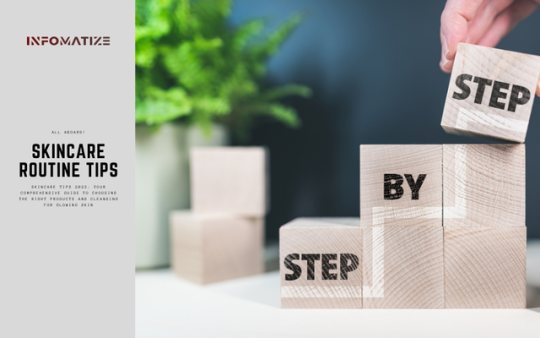
Maintaining a good skincare routine is crucial for achieving healthy and radiant skin. Here are some tips to keep in mind while building your skincare routine: - Cleanse your skin twice a day. The first step to any skincare routine is to cleanse your skin thoroughly to remove any dirt, oil, and impurities that have accumulated on your skin throughout the day or night. - Choose skincare products based on your skin type. Your skin type will determine the kind of products you should use. It's essential to find products that work well with your skin type, whether you have dry, oily, combination, or sensitive skin. - Apply products in order of texture. Start with the thinnest product and work your way up to the thickest to ensure that each product can penetrate the skin effectively. - Use sunscreen daily. Protect your skin from the damaging effects of the sun by wearing sunscreen with an SPF of at least 30 every day. - Don't forget to exfoliate. Exfoliating once or twice a week can help remove dead skin cells, unclog pores, and improve the texture of your skin. However, be gentle, and don't overdo it, as too much exfoliation can damage your skin. - Moisturize your skin daily. Using a moisturizer can help keep your skin hydrated and prevent it from becoming dry, flaky, or irritated. - Don't forget to take care of your lips. Use a lip balm or chapstick to keep your lips moisturized and protect them from the sun. - Be gentle with your skin. Avoid using harsh scrubs or rubbing your skin too vigorously, as it can damage your skin's protective barrier. - Use a gentle makeup remover. If you wear makeup, use a gentle makeup remover to remove it before cleansing your skin. - Be patient. It takes time to see results from a skincare routine, so be patient and consistent with your routine. By following these skincare routine tips, you can help ensure that your skin remains healthy, glowing, and beautiful. Read the full article
#Australia#Bestcleansingtechniquesforglowingskinin2023#Bestskincareproducts#Bestskincareproductsforglowingskinin2023#Canada#Choosingskincareproducts#Cleansingforglowingskin#Comprehensiveskincareguide#Comprehensiveskincareguidefor2023#Essentialskincareproductsforaglowingcomplexion#France#Germany#Glowingskintips2023#Howtochoosetherightskincareproductsforglowingskin#Naturalskincareremedies#Naturalskincareremediesforradiantskin#Netherlands#Norway#Radiantskintips#Rightskincareproducts#Skincareroutine2023#Skincareroutineforhealthyandglowingskin#Skincaretips2023#Sweden#Switzerland#Tipsforchoosingtherightskincareproductsin2023#Topskincaretipsforglowingskinin2023#Ultimateskincareroutineforglowingskin#UnitedKingdom#UnitedStates
0 notes
Text
Medical news and trends 2023: covering the latest research, news, and trends in the field of health and Wellness.

Introduction
Medical news and trends 2023 are constantly evolving, with new developments and discoveries emerging every day. Here are some of the latest research, news, and trends in the field of health and wellness: - Per-person medical cost increases are back to pre-pandemic levels, with insurers expecting plan sponsors to prioritize improvements despite double-digit medical cost increases in some markets . - Retail healthcare is becoming an increasingly visible trend, with researchers predicting that the amount of healthcare business conducted through retail outlets will double in 2023 . - Common levels of traffic pollution can impair human brain function in only a short amount of time, according to a new study . - Medical research is continuing to make advancements in a wide range of fields, such as biology, chemistry, pharmacology, and toxicology, with the goal of developing new medicines or medical treatments . - Healthcare labor trends in 2023 include increased burnout and executive stress, as well as a rise in union activity as the sector continues to recover from the COVID-19 pandemic . - The federal plan to reduce homelessness by 25% by 2025 includes health care as part of the solution . - Medical practice marketing is evolving rapidly, with some exciting and challenging new trends and changes to be aware of in 2023 . - Plan management requires greater rigor, with insurers in Asia adjusting medical plan premiums based on COVID-19 vaccination status. Employers should consider these trends as insurers play a key role in shaping the benefits landscape . - Everyday Health provides the latest research, top stories, and trending topics in health and medical news information from their award-winning team of health and medical journalists . - New research suggests COVID-19 has made people more health-conscious and willing to change their lifestyles to stay well. Americans believe their health is more important to them than before the pandemic, and this trend is expected to continue in 2023 . These are just some of the latest medical news and trends to keep an eye on in 2023, as the field of health and wellness continues to evolve and grow.
Women's Health Concerns

Women's health concerns cover a broad range of topics that are specific to women's biology and gender-related factors. Some of the top health risks for women include heart disease, breast cancer, and gynecological conditions. However, there are many other health issues that women face, which are different from men and require specific attention. Here are some key points from the provided web search results: - Mayo Clinic provides a comprehensive overview of women's health, including the top health risks, and ways to manage daily health concerns such as premenstrual syndrome . - Women's Health Concern (WHC) is an independent service that advises women on gynecological, sexual, and post-reproductive health issues . - WHO highlights that women's health is of particular concern due to discrimination rooted in sociocultural factors, which can lead to health disparities . - Harvard Health Publishing explains that women have unique health concerns, such as menstrual cycles, pregnancy, birth control, and menopause. Some health issues affect only women, while others are more common in women . - Healthgrades lists the top 10 women's health concerns, which include heart disease, breast cancer, osteoporosis, depression, and autoimmune diseases . - Johns Hopkins Medicine notes that many health issues affect women differently from men, and in ways that impact diagnosis and care. It's important to consider women's health beyond gynecological concerns . - WHC also provides fact sheets on menopause-related issues such as postmenopausal bleeding, vaginal dryness, and osteoporosis . - UC San Diego Health emphasizes the importance of visiting healthcare providers regularly and having recommended screenings, which can detect diseases even before symptoms arise . - The National Institute of Child Health and Human Development (NICHD) provides information on women's health conditions, including pregnancy and menopause, uterine fibroids, and pelvic floor disorders . In summary, women's health concerns encompass a wide range of issues that are specific to women's biology and gender-related factors. Some of the top health risks for women include heart disease, breast cancer, and gynecological conditions. However, there are many other health issues that women face, and it's important to consider women's health beyond gynecological concerns. Women should visit healthcare providers regularly and have recommended screenings to detect diseases early on. Healthcare providers should also consider sociocultural factors that may lead to health disparities among women. The Importance of Regular Breast Cancer Screenings for Women Regular breast cancer screenings are essential for women because early detection is key to successful treatment and improving the chances of survival. Mammograms are currently the best way to detect breast cancer in most women of screening age and can help find cancer before it is big enough to feel or cause symptoms . When breast cancer is detected early and has not spread, the five-year relative survival rate is 99% . The American Cancer Society recommends women between the ages of 40 and 44 should have the option to start screening with a mammogram every year. Women aged 45 to 54 should get mammograms every year, while women aged 55 and older can switch to a mammogram every other year, or they can choose to continue yearly mammograms. Screening should continue as long as a woman is in good health and is expected to live at least... . Screening tests, such as mammograms, are essential for early detection of breast cancer. The U.S. Preventive Services Task Force (USPSTF) recommends regular screening for breast, cervical, colorectal (colon), and lung cancers . A mammogram is an x-ray picture of the breast, which can be used to check for breast cancer in women who have no signs or symptoms of the disease. Screening mammograms usually involve two or more x-ray pictures, or images, of each breast. The x-ray images often make it possible to detect tumors that cannot be felt . In summary, regular breast cancer screenings, including mammograms, are essential for early detection of breast cancer, which can improve the chances of successful treatment and survival. Women should consult their healthcare provider to determine when to start screening and how often to have them. Managing Menstrual Pain: Tips and Treatments Many women experience menstrual pain, and there are several tips and treatments available to help manage it. Some of the options include: - Heat therapy: Applying heat to the lower abdomen can help ease menstrual cramps. This can be done using a heating pad, hot water bottle, or heat patch . - Exercise: Physical activity has been found to ease menstrual pain . - Herbal tea: Drinking herbal teas such as chamomile, fennel, or ginger tea can help reduce inflammation and muscle spasms in the uterus, which cause cramping . - Diet: Eating a diet high in minimally processed foods, fiber, and plants can help decrease menstrual pain. Papaya and brown rice are examples of foods that can help relieve pain . - Stress management: Reducing stress can also help manage menstrual pain . It is important to note that some women may require medication or medical treatment to manage menstrual pain. If pain is severe or interfering with daily activities, it is recommended to consult a healthcare provider for further evaluation and management . Navigating Pregnancy: Common Concerns for Women Pregnancy can be a wonderful experience, but it can also come with many concerns and potential complications. Here are some common concerns for women during pregnancy: - Maternal morbidity: Maternal morbidity refers to physical and psychological conditions that result from or are aggravated by pregnancy and can have an adverse effect on a woman's health. Severe maternal morbidity affects more than 50,000 women in the United States every year . - Reproductive problems: Reproductive problems such as infertility, multiple miscarriages, or early labor are common concerns for women during pregnancy. It's important to see your health care provider for routine exams as some women may have no symptoms . - Pregnancy-related depression and anxiety: Research shows that up to 13% of U.S. women reported frequent symptoms of depression after childbirth, and that anxiety co-occurs in up to 43% of depressed pregnant and postpartum women. These medical conditions can have significant effects on the health of the mother and her child . - Common pregnancy challenges: High blood pressure, flu, and sharp pain are all common challenges during pregnancy. It's important to be in tune with your body so you recognize issues that need to be addressed. Learn about these common challenges and when to call your doctor . - Eating disorders: Body image changes during pregnancy can cause eating disorders to worsen. Eating disorders are linked to many pregnancy complications, including birth defects and premature birth. Women with eating disorders also have higher rates of postpartum depression . It is important for women to stay informed and seek medical advice for any concerns during pregnancy. Regular prenatal care can help prevent or manage potential complications and promote a healthy pregnancy for both the mother and the baby.
Men's Health Issues

Men's health issues encompass a range of physical and mental health concerns that affect men. Some common health issues that men face include heart disease, cancer, unintentional injury, depression, and low testosterone . It is important for men to prioritize their health and take action to prevent or address these issues. In addition to these common health concerns, men also face unique health issues such as prostate cancer and benign prostate enlargement . Penis health is also an important part of overall men's health, as penis problems can be a sign of underlying health conditions and can impact other areas of life . Lifestyle choices can greatly affect men's health, and making healthy choices such as eating a healthy diet and including physical activity in daily routines is important . Managing risky behaviors such as excessive drinking and casual sex can also help prevent health issues . Regular check-ups and medical care are also important for men's health, as early detection and treatment can prevent or address many health issues . Additionally, HPV vaccines and condom use can help prevent HPV and other sexually transmitted infections . In conclusion, men's health issues are diverse and affect both physical and mental health. It is important for men to prioritize their health by making healthy choices, managing risky behaviors, seeking regular check-ups, and promptly addressing any health concerns. By doing so, men can maintain optimal health and wellbeing. The Link Between Heart Health and Erectile Dysfunction in Men Erectile dysfunction (ED) and heart disease are strongly linked. Research has shown that men with ED are at greater risk of developing heart disease, and those with heart disease may experience ED as a symptom. In fact, ED can be an early warning sign of current or future heart problems, and getting the right treatment for heart disease might help with ED . Several studies have found a strong connection between ED and heart disease. One study showed that 57% of men who had bypass surgery and 64% of men hospitalized for a heart attack experienced ED . Another study found that men with ED were twice as likely to have a heart attack or other cardiac event during a four-year study period compared to those without ED . ED is defined as the inability to get and keep an erection firm enough for sex. While having erection trouble from time to time isn't necessarily a cause for concern, ongoing ED can cause stress, affect self-confidence, and contribute to relationship issues . The connection between ED and heart health has important implications for both patients and healthcare providers. Understanding the link can help identify those at risk for heart disease and encourage them to seek appropriate medical care. It can also prompt healthcare providers to screen for ED in patients with heart disease, potentially improving both their sexual and cardiovascular health . In summary, the connection between heart health and erectile dysfunction in men is strong and multifaceted. Men with ED should be aware of their increased risk for heart disease, and healthcare providers should consider screening for ED in patients with heart disease. Treating heart disease may also improve ED, highlighting the importance of managing both conditions. Preventing and Managing Male Pattern Baldness Male pattern baldness, also known as androgenic alopecia, is a common condition that affects men as they age. While there is no known way to prevent male pattern baldness, there are treatments available to help manage it. The condition is caused by an inherited sensitivity to dihydrotestosterone (DHT), which leads to hair follicles shrinking and producing finer hair, eventually leading to a receding hairline and deserted scalp . Stage 2 to 4 are the stages of male pattern baldness. In stage 2, there is slight hair loss near the skin between the ears and forehead (temples). In stage 3, there is deep hairline recession around the temples, and the hairline may have an M or U shape. In stage 4, there is very deep hairline recession and a loss of hair at the top of the head (crown) . Treatments for hair loss include medications and surgery. Medications are available to treat pattern baldness, and if the hair loss is caused by an underlying disease, treatment for that disease will be necessary . However, it is important to note that some medications can cause hair loss, and your doctor may advise you to stop using them for a few months. Stress may also cause hair loss by increasing the production levels of sex hormones in the body . Nutritional deficiency and psychological stress may also trigger hair loss, but hair usually grows back within about 2 to 6 months . In conclusion, while male pattern baldness cannot be prevented, there are treatments available to help manage it. It is important to consult with a healthcare professional to determine the appropriate course of treatment for individual cases of hair loss. Addressing Mental Health Stigma in Men Mental health stigma is a major barrier to men seeking help for their mental health issues. Men face a significant amount of stigma, secrecy, and reluctance to discuss their mental health concerns . This can lead to a reluctance to seek help or treatment , as well as bullying, physical violence, or harassment . Men are also more likely to die by suicide and alcohol-related causes than women, and they are two to three times more likely to misuse drugs . To address mental health stigma in men, it is important to increase general awareness and education around mental health, substance abuse, and their treatment . Additionally, we must work to reduce the stigma surrounding men seeking help for their mental health and encourage transparency around mental health issues . By creating an open dialogue around mental health and reducing stigma, we can help men access the care they need and deserve.
Gender-Specific Health

Gender-specific health refers to health issues and conditions that are unique to a particular gender. There are various health concerns that are specific to men and women, and it is important to address these issues to ensure optimal health and well-being for everyone. For women, some of the health concerns that are unique to them include pregnancy and menopause, gynecological conditions such as uterine fibroids and pelvic floor disorders, and breast cancer. Women also have higher rates of autoimmune diseases such as lupus and multiple sclerosis, and mental health conditions such as depression and anxiety . For men, some of the health concerns that are specific to them include prostate cancer, testicular cancer, and male-pattern baldness. Men also have higher rates of heart disease and suicide . Transgender and gender-diverse individuals also have specific health concerns that are related to their gender identity. Some of these concerns may be due to experiences of gender minority stress, such as negative attitudes and disapproval toward transgender and gender-diverse people. Health care for transgender and gender-diverse individuals may involve gender affirmation surgery, hormone therapy, and mental health services . Gender bias in health research is an ongoing issue and gender-specific health programs can address important issues but risk creating new biases . To further promote awareness and education about sex and gender-specific health, there are online resources available, such as the Sex and Gender Specific Health education site which includes categorized libraries of disease-specific slide sets highlighting sex and gender differences, and interactive case-based modules for use in traditional healthcare settings . In conclusion, addressing gender-specific health concerns is crucial in promoting optimal health and well-being for all individuals, regardless of their gender identity. It is important for healthcare providers to be knowledgeable and informed about the specific health concerns of each gender to provide appropriate care and support. Understanding and Managing Hormonal Imbalances in Women and Men Hormonal imbalances can occur in both men and women, and can have a variety of causes and symptoms. In women, hormonal imbalances can be caused by conditions such as menopause or polycystic ovary syndrome (PCOS), which can lead to fluctuations in hormones such as estrogen and progesterone . Symptoms of hormonal imbalance in women may include acne on the face, chest and/or upper back, hair loss, and changes in menstrual cycle . To manage hormonal imbalances in women, it is recommended to aim for a minimum of 20-30 grams of protein per meal and engage in regular exercise . In men, hormonal imbalances may be caused by conditions such as hypogonadism, which can lead to low hormone levels . Symptoms of hormonal imbalance in men may include gynecomastia, or the development of breast tissue, breast tenderness, erectile dysfunction (ED), and changes in beard and body hair growth . To manage hormonal imbalances in men, it is recommended to engage in regular exercise and eat a balanced diet that includes protein and healthy fats . In both men and women, hormonal imbalances can occur naturally during puberty, which can cause fluctuations in hormones . Read the full article
#Advancementsinwellnessresearch#Australia#Austria#Belgium#Breakthroughsinmedicalscience#Canada#Cutting-edgehealthresearch#Cutting-edgehealthcaretrends#Denmark#Emergingmedicaltechnologies#Finland#France#Futureofmedicalcare#Germany#Groundbreakinghealthstudies#Healthandwellnessbreakthroughs#Healthandwellnessnews#Healthandwellnessupdates#Healthresearch2023#Healthscienceupdates#Healthtrends2023#Healthtrendstowatchin2023#Healthcareinnovations#Healthcarenewsandtrends#Healthcaretrends2023#HongKong#Innovationsinhealthcaredelivery#Innovativehealthtreatments#Ireland#Italy
0 notes
Text
Aging and Longevity: Tips and Advice for Maintaining Good Health as You Get Older
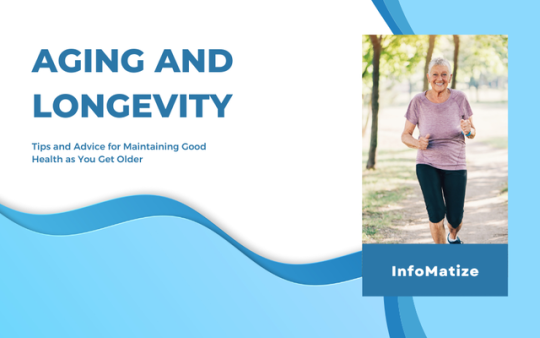
Introduction
As we age, taking care of our physical, mental, and cognitive health becomes increasingly important for healthy aging. Fortunately, making even small changes in our daily lives can help us live longer and better. Here are some tips and advice for maintaining good health as you get older: - Stay active: Regular physical activity, like walking, jogging, biking, swimming, or aerobics, can help prevent, delay, and manage chronic diseases; improve balance and stamina; reduce the risk of falls; and improve brain health 4. Aim for moderate physical activity, like walking, for at least 150 minutes a week and muscle strengthening activity, like carrying groceries, for at least 2 days a week . - Eat well: A healthy diet can help you maintain a healthy weight, lower your risk of chronic diseases, and boost brain health. Aim to eat a balanced diet with plenty of fruits, vegetables, whole grains, and lean proteins. Swap out white bread for whole grain and add fibre-rich foods to your meals, like kidney beans and apples . - Get enough sleep: Getting enough sleep is important for your physical and mental health. Most adults need 7-8 hours of sleep per night to feel rested and alert. Try to establish a regular sleep schedule and create a relaxing bedtime routine . - Visit your doctor regularly: Regular check-ups with your doctor can help you manage any health conditions and prevent future ones. Make sure to follow recommended screening guidelines for your age and sex, and talk to your doctor about any health concerns you may have . - Manage stress: Chronic stress can have negative effects on your health. Finding ways to manage stress, like meditation or exercise, can help improve your mental and physical health . - Stay socially engaged: Social isolation can have negative effects on your mental and physical health. Try to stay connected with friends and family, join a social group or club, or volunteer in your community . - Avoid risky behaviours: Smoking, excessive drinking, and substance abuse can have negative effects on your health. Avoiding these risky behaviours can help you maintain good health as you age . By following these tips and advice, you can help maintain good health as you get older and improve your chances of healthy aging. Remember, it's never too late to make positive changes to your lifestyle and take steps to improve your overall well-being.
The Importance of Gender-Specific Healthcare

Gender-specific healthcare is crucial for promoting the health and well-being of individuals, particularly women and gender-diverse individuals. Gender refers to the socially constructed characteristics, norms, behaviours, and roles associated with being a woman, man, girl, or boy, which can vary across societies and change over time . Research shows that gender norms, roles, and relations, such as gender inequality and inequity, affect people's health all around the world . For instance, gender-affirming healthcare has been shown to improve the mental health and overall well-being of gender-diverse people . Moreover, promoting primary healthcare for women can improve the health and economic well-being of the population as a whole . However, less than 30 per cent of medical schools incorporate gender-specific topics in their curriculum, and only 9 per cent of medical schools offer women's health . Gender bias in health research is an ongoing issue, and gender-specific needs are important to address. However, a gendered approach may ignore people who identify as neither and risk creating new biases . To address these challenges, specialized, gender-specific care is becoming more common, and comprehensive women's health centres are developing quality care for women . However, there is a need for more attention to how sex and gender influence healthcare, including providing sex/gender-specific information on any topic . In summary, gender-specific healthcare is crucial for promoting the health and well-being of individuals, particularly women and gender-diverse individuals. However, a gendered approach should not ignore people who identify as neither, and there is a need for more attention to how sex and gender influence healthcare . It is important to address gender-related barriers to healthcare, advance gender equality and the empowerment of women and girls in all their diversity, and achieve health for all . Understanding Gender Differences in Health Gender differences play a significant role in health outcomes and healthcare access, and it is important to understand these differences to achieve equitable health outcomes for all. Sex and gender are different concepts, where sex is biological and gender is a social or cultural construct . Gender norms, roles, and relations can affect people's health globally, and gender-related barriers to healthcare must be addressed to advance gender equality and empower women and girls in all their diversity . Medical schools, however, are not adequately addressing the issue of gender differences in health. Despite women making up 50% of the population, only 44% of medical schools have women's health curricula, and even fewer offer interdisciplinary training . The lack of attention to gender differences in medical education can lead to gender bias in healthcare, which can have serious consequences, including fatal outcomes . The FDA has recognized the importance of understanding gender differences in clinical drug evaluations and has issued guidance on the study and evaluation of gender differences in the clinical evaluation of drugs . It is critical to recognize that gender differences can impact health outcomes and access to healthcare, and addressing these differences must be a priority to ensure equitable health outcomes for all. How Hormones Impact Women's Health Hormones play a crucial role in women's health. Estrogen and progesterone, which are mainly produced by the ovaries, are the primary female hormones that affect a variety of bodily systems . Estrogen, in particular, promotes the development of female characteristics and regulates bone health and mood management . However, fluctuations in hormone levels, such as during menopause, can lead to various symptoms, such as hot flashes and vaginal discomfort, which can be treated with hormone therapy . In addition to their effects on reproductive and bone health, hormones can also impact mental health. The stress hormone cortisol, along with reproductive hormones like estrogen and progesterone, can cause anxiety, depression, and irritability . It is important for women to have open and honest conversations with their primary care providers about the impact of hormones on their overall health and well-being. Hormone therapy can be an effective treatment option for certain symptoms, but it is not without risks. Women should weigh the potential benefits and risks with their healthcare providers to determine the best course of action for their individual needs. Addressing Men's Health Concerns Men's health concerns can vary depending on age, lifestyle, and genetics. It is important for men to prioritize their health and regularly seek medical attention to address any concerns. Common health concerns for men include heart disease, cancer, unintentional injury, obesity, and mental health issues . Men may feel embarrassed or uncomfortable discussing certain health issues with their healthcare providers. However, it is crucial to openly communicate and seek treatment to prevent and address potential health problems . Men of colour may face additional health disparities due to poverty, violence, incarceration, and limited access to healthcare services . Healthcare providers can help men address multiple health concerns, such as addressing underlying health conditions that may contribute to erectile dysfunction . By maintaining a healthy lifestyle, seeking regular check-ups, and promptly addressing any health concerns, men can maintain optimal health and well-being .
Preventative Healthcare for Women and Men
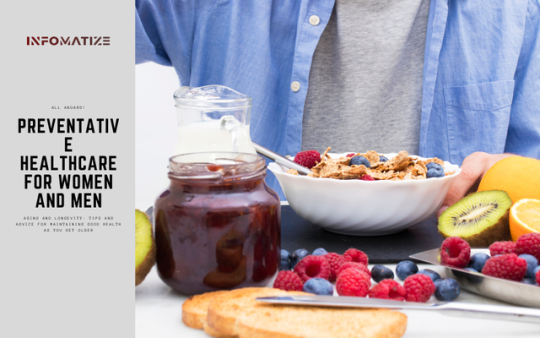
Preventative healthcare is crucial for both women and men to maintain overall health and prevent diseases. The Affordable Care Act requires most health insurance plans to cover certain preventative care services for both genders without any out-of-pocket costs . Here are some preventative care measures that women and men can take to stay healthy: For Women: - Cervical cancer screening, including Pap smears and HPV DNA tests, every three years for women aged 21-65 years - Breast cancer screening, including mammograms and breast exams, every 1-2 years for women aged 40 years or older - Osteoporosis screening for women aged 65 years or older and for younger women with certain risk factors - Contraceptive counselling and FDA-approved contraceptive methods without cost-sharing for women of reproductive age - Routine gynaecological exams for women of all ages For Men: - Blood pressure screening and cholesterol screening for men of certain ages or at higher risk - Colorectal cancer screening for men aged 45-75 years - Prostate cancer screening, including PSA blood tests and digital rectal exams, for men aged 50 years or older and for younger men with certain risk factors - Testicular exams for young men to check for lumps or abnormalities It's important to talk to a healthcare provider to determine which preventative care measures are appropriate for an individual's specific health needs and risk factors. By getting recommended preventative care, women and men can reduce their risk of developing diseases and improve their overall health and well-being. The Importance of Regular Screenings Regular screenings are an essential part of preventive healthcare . Screenings are tests that are done to detect the presence of a disease or a health condition in individuals who may not be showing any symptoms . These screenings can help identify health issues early on when they are typically easier to treat and can prevent further complications from developing . There are various types of screenings available, and the recommended screening schedule can vary depending on an individual's age, gender, and overall health status . Some common types of preventive healthcare screenings include breast cancer, cervical cancer, colon cancer, lung cancer, and skin cancer screenings, as well as cholesterol and blood pressure screenings . Routine screenings can help healthcare providers monitor changes in an individual's health over time, allowing them to identify potential issues and intervene early on with medications or lifestyle changes to prevent more severe problems from developing . It is essential to follow the recommended screening schedule for your age and gender and discuss any concerns or questions with your healthcare provider . By regularly attending screenings and following recommended health guidelines, individuals can take a proactive approach to their health and reduce the risk of developing serious health conditions later on in life. Lifestyle Factors that Affect Women's Health The lifestyle choices that women make can have a significant impact on their overall health and well-being. Here are some lifestyle factors that can affect women's health: - Weight: Being overweight or underweight can affect women's health, including fertility . - Smoking: Smoking is a major risk factor for many health problems, including cancer and heart disease. Women who smoke are at increased risk for infertility, pregnancy complications, and menopause-related issues . - Physical activity: Regular physical activity is important for overall health and can help prevent chronic conditions such as heart disease, diabetes, and osteoporosis. Physical activity can also help improve mental health and reduce stress . - Diet: A healthy diet that includes a variety of fruits, vegetables, whole grains, lean proteins, and healthy fats is important for maintaining overall health and reducing the risk of chronic diseases such as heart disease, cancer, and diabetes . - Alcohol consumption: Excessive alcohol consumption can lead to a range of health problems, including liver disease, cancer, and mental health issues. Women are more susceptible to the harmful effects of alcohol than men due to differences in body size and metabolism . - Sleep: Getting enough sleep is important for overall health and well-being. Sleep deprivation can affect mood, and cognitive function, and increase the risk of accidents and chronic health problems . - Sexual health: Maintaining good sexual health is important for overall health and well-being. Women can reduce the risk of sexually transmitted infections (STIs) by practising safe sex, getting tested for STIs, and getting vaccinated against HPV . - Stress management: Chronic stress can have negative effects on both physical and mental health. Women can reduce stress by practising relaxation techniques such as deep breathing, yoga, or meditation, and by seeking support from friends, family, or a mental health professional . In conclusion, there are several lifestyle factors that can affect women's health. By making healthy choices and practising self-care, women can reduce their risk of developing chronic health conditions and improve their overall well-being. Mind-Body Approaches to Men's Health The mind-body approach refers to the techniques that aim to enhance the positive impact of the mind on the body, including behavioural, psychological, social, expressive, and spiritual approaches . While the majority of the search results address mind-body approaches for reducing stress, anxiety, and depression, there is no indication that these practices are gender-specific. Therefore, they can also be used to enhance men's health. Mind-body techniques such as meditation, guided imagery, breathing techniques, autogenic training, biofeedback, genograms, and self-expression through drawings and movement have been found to improve well-being and reduce stress in both men and women . Furthermore, research suggests that mindfulness-based meditation can have positive effects on depression as well, and its effects can last for six months or more . Therefore, men who experience symptoms of depression can benefit from practising mindfulness-based meditation. In addition, some studies have found that mind-body approaches, such as relaxation techniques, yoga, tai chi, and meditation, may be useful for managing symptoms of stress in patients, including men . The Integrative Medicine and Health Research Program at Mayo Clinic studies the effectiveness of using mind-body techniques to reduce anxiety before and during medical procedures, improve the quality of life for patients and caregivers, and help people manage stress . Therefore, men may benefit from incorporating mind-body practices into their health routines to improve their overall well-being.
Top 10 Health Concerns for Women and Men
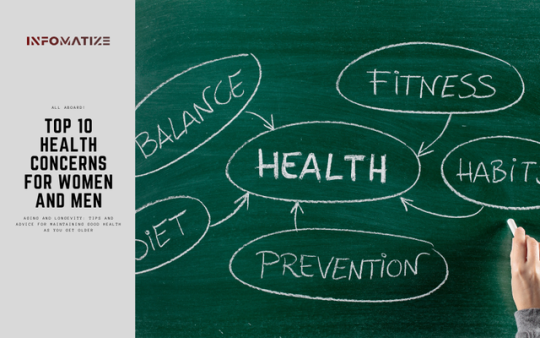
There are several health concerns that are common among women and men, but some of these conditions affect each gender differently. Here are the top 10 health concerns for women and men Top 10 Health Concerns for Women: - Breast Cancer - Women are at a higher risk for breast cancer than men. Regular mammograms and breast self-exams can help with early detection and treatment . - Heart Disease - Women may have different symptoms than men when it comes to heart disease. Risk factors include high blood pressure, high cholesterol, diabetes, smoking, and a family history of heart disease . - Stroke - Women are more likely to have a stroke than men. Symptoms include sudden weakness on one side, loss of speech and balance, and confusion . - Depression - Women are more likely to experience depression than men, and suicide is a leading cause of death for women under 60. It is important for women to seek assistance and treatment for mental health issues . - Osteoporosis - Women are at a higher risk for osteoporosis, a condition where bones become weak and brittle than men. Regular exercise and a diet rich in calcium and vitamin D can help prevent osteoporosis . - Autoimmune Diseases - Women are more likely than men to develop autoimmune diseases such as lupus, rheumatoid arthritis, and multiple sclerosis . - Pregnancy-Related Issues - Racial disparities exist in pregnancy-related deaths, and surveillance of hypertension among women of reproductive age is important . - Thyroid Disorders - Women are more likely than men to develop thyroid disorders such as hypothyroidism and hyperthyroidism. Symptoms include weight gain or loss, fatigue, and changes in the mood . - Urinary Tract Infections - Women are more likely to develop urinary tract infections (UTIs) than men due to the anatomy of the female urinary tract. Symptoms include painful urination and frequent urination . - Reproductive Health - Women may experience issues related to their reproductive health, such as infertility, polycystic ovary syndrome (PCOS), and endometriosis . As men age, they face a variety of health concerns that can affect their quality of life and even be life-threatening. Here are the top 10 health concerns for men, according to various reputable sources: - Heart disease: This is the leading cause of death in men over 50 and can be caused by smoking, obesity, high blood pressure, and high cholesterol . Men should watch for warning signs, such as discomfort or pain in the chest, shortness of breath, and lightheadedness or fainting . - Cancer: Men are at risk for several types of cancer, including lung, prostate, and colorectal cancer. Regular screenings and early detection are crucial for successful treatment . - Unintentional injuries: Men are more likely to engage in risky behaviours, such as driving under the influence or not wearing a seatbelt, which can lead to unintentional injuries . - Stroke: Men have a higher risk of stroke than women, and risk factors include high blood pressure, high cholesterol, smoking, and diabetes . - Respiratory diseases: Chronic obstructive pulmonary disease (COPD) and other respiratory diseases are more common in men than in women, and smoking is a major risk factor . - Diabetes: Men with diabetes are at risk for lower testosterone levels and sexual impotence, and they are also more likely to develop heart disease . - Mental health: Men are less likely to seek help for mental health issues, but depression and suicide are significant concerns. Men should talk to their healthcare provider if they are experiencing symptoms of depression . - Erectile dysfunction: As men age, they may experience difficulty achieving or maintaining an erection. Read the full article
#Adviceforalongandhealthylife#Adviceforagingwell#Age-relatedhealthadvice#Agingandbalancetips#Agingandbrainhealthtips#Agingandexercisetips#Agingandhearinghealthtips#Agingandhearthealthtips#Agingandlongevitytips#Agingandmobilitytips#Agingandnutritiontipsforseniors#Agingandrespiratoryhealthtips#Agingandsleeptips#Agingandwellnesstips#Aginggracefullytips#Anti-agingfoods#Anti-agingstrategies#Australia#Austria#Belgium#Canada#Denmark#Finland#France#Germany#Healthyagingadvice#Healthyaginghabits#HongKong#Ireland#Italy
0 notes
Text
Furniture Restoration and Upcycling: The Ultimate Beginner's Guide to Restore and Upcycle for Your Home

Introduction:
If you're looking for a way to bring new life to your old furniture while also promoting sustainability, furniture restoration and upcycling are excellent options. In this comprehensive guide for beginners, we'll walk you through the steps to restore and upcycle your furniture to create a fresh look while doing your part for the environment. Firstly, cleaning your furniture is an essential first step before beginning any restoration or upcycling work. This can involve using gentle cleaners or soap and water to remove dirt, dust, and grime that may have accumulated over time. Once cleaned, you can then assess the furniture's condition and determine what needs to be repaired, replaced, or restored. If you're looking to restore damaged or worn-out furniture, it may be necessary to replace hardware such as drawer pulls, knobs, or handles. You can also consider repairing any structural damage by filling in cracks, smoothing out scratches, and sanding rough edges. Additionally, consider re-staining or painting your furniture to give it a fresh look . Upcycling your furniture is another option to consider. This involves taking your old furniture and transforming it into something new and unique. Some popular upcycling ideas include turning old chairs into planters, transforming dressers into bathroom vanities, or repurposing old headboards into benches . The possibilities are endless, and you can get as creative as you want. Regardless of whether you decide to restore or upcycle your furniture, it's important to keep sustainability in mind. Upcycling old furniture not only reduces waste but also promotes sustainable living. You can also consider using eco-friendly paints and materials when restoring your furniture to reduce your carbon footprint . Overall, furniture restoration and upcycling are fantastic ways to breathe new life into old furniture while promoting sustainability. With the right tools and techniques, you can transform your old furniture into something unique and beautiful, all while doing your part for the environment.
The Benefits of Furniture Restoration and Upcycling
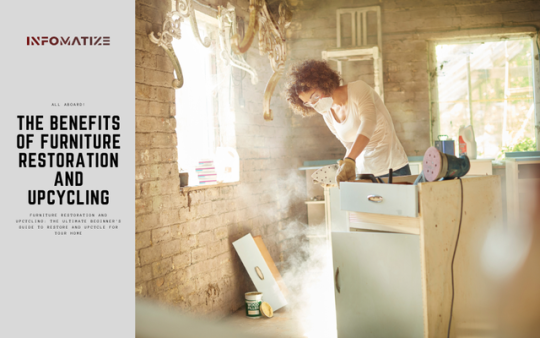
Furniture restoration and upcycling offer several benefits for both the environment and individuals. One of the most significant advantages is reducing waste and saving resources by keeping items out of landfills. Upcycling also contributes to the fight against deforestation and plastic production, which are responsible for soil erosion, biodiversity loss, greenhouse gas emissions, and pollution . Furniture restoration and upcycling also have mental benefits, as they can boost creativity, foster a sense of community, and teach valuable home repair skills . Furthermore, upcycling can create unique and personalized items of higher quality or value than the original . Restoring old furniture also has environmental benefits as it requires less energy and produces fewer carbon dioxide emissions than making new furniture from scratch. Moreover, restoring old furniture preserves heritage designs while reducing the need for new materials and resources . In summary, furniture restoration and upcycling offer several benefits such as reducing waste, saving resources, fighting against deforestation and plastic production, boosting creativity, building community, and preserving heritage designs. Moreover, restoring old furniture has environmental benefits such as producing fewer carbon dioxide emissions and preserving resources. Why Furniture Restoration and Upcycling is Good for the Environment Furniture restoration and upcycling offer many benefits to the environment. Firstly, buying or repurposing used furniture instead of purchasing new ones reduces waste, as Americans discard over 12 million tons of furniture each year, with 80% of it ending up in landfills . Secondly, it helps prevent deforestation, which contributes to biodiversity loss, soil erosion, and 15% of global greenhouse gas emissions, as buying new items made from wood means cutting down trees . Upcycling furniture is also financially sensible, as converting a rejected object into something useful increases its value . Additionally, upcycling reduces waste and the need to use unethically sourced or unsustainable materials, like plastic, to create new products, benefiting the planet . Moreover, upcycling encourages creativity and can become a fun hobby for some people, and it has a fairly large online community on platforms like Pinterest and Facebook . Furniture restoration, on the other hand, is all about returning a piece of furniture to its original condition, involving repairing any damage, refinishing the wood, and replacing any missing parts . Restoration reduces the need to dispose of classic furniture, lowering the amount of waste added to overflowing landfills and the negative environmental impact of harmful chemicals emitted from the rubbish . Additionally, furniture refinishing helps make damaged and worn-out pieces pristine again, regaining their value, and can also be used as a way to reduce waste . In summary, furniture restoration and upcycling have numerous benefits to the environment, including reducing waste, preventing deforestation, reducing the need for unethically sourced or unsustainable materials, encouraging creativity and a fun hobby, and regaining the value of antique furniture. How Upcycling Can Save You Money Upcycling is the process of taking an object that is considered to no longer be useful and repurposing it into something new and functional. Upcycling can save you money in various ways. Firstly, upcycling allows you to use what you already have and save money on buying new products. By repurposing old items, you can create new and beautiful items without spending much money . Secondly, upcycling can help you save costs as you can turn something that you were going to throw away into something useful again . Thirdly, upcycling can reduce your consumption of new raw materials when creating new products, thus reducing energy usage, air and water pollution, and even greenhouse gas emissions. By reusing materials, you are also reducing the amount of waste that ends up in landfills . Finally, upcycling can also become an alternative to a personal or small business loan or even a means of earning extra cash by reducing expenses . Overall, upcycling is an excellent way to save money and reduce waste while getting creative and innovative in repurposing old items. The Unique Benefits of Restoring Old Furniture Restoring old furniture comes with a number of benefits that can make the effort and expense worthwhile. Here are some unique benefits of restoring old furniture that is supported by various Sources: - Increased value: By restoring old furniture, you can bring it back to its original condition, which can increase its value. According to one source, "Antique furniture restoration can increase the value of your piece, sometimes significantly" . - Environmental benefits: Restoring old furniture can be more environmentally friendly than buying new furniture. Furniture-making is energy-intensive and produces a significant amount of carbon dioxide emissions. By restoring old furniture, you can help reduce the demand for new furniture and prevent deforestation . - Unique styles and craftsmanship: Old furniture often features unique styles and craftsmanship that may not be available in modern furniture. By restoring old furniture, you can preserve these unique features and enjoy them in your home . - Less wasteful: Americans discard more than 12 million tons of furniture each year, with 80% of it ending up in landfills. By restoring old furniture, you can help reduce this waste and extend the lifespan of furniture pieces . - Personal satisfaction: Restoring old furniture can be a fulfilling and rewarding experience. It allows you to give new life to old pieces and create something unique that reflects your personal style . In conclusion, restoring old furniture can offer a variety of benefits, including increased value, environmental benefits, unique styles and craftsmanship, less waste, and personal satisfaction. If you are interested in restoring old furniture, be sure to research appropriate techniques and materials to ensure that your project is successful.
Getting Started with Furniture Restoration
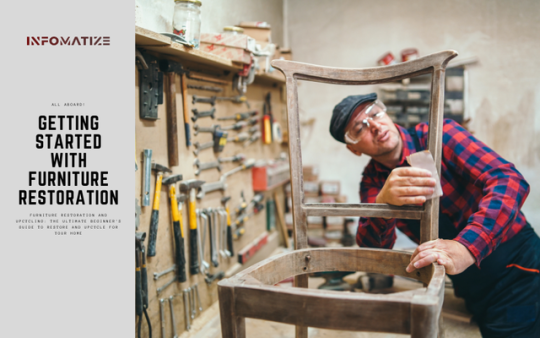
Furniture restoration can be a rewarding and eco-friendly hobby or business. If you are interested in getting started with furniture restoration, here are some tips: - Learn the basics of furniture restoration: Before spending any money, familiarize yourself with local ordinances and laws concerning toxic chemicals such as lead in older paints and flame retardants in modern furniture. - Evaluate your furniture: Before starting any restoration work, evaluate your furniture and determine what needs to be done. Use mineral spirits to clean and evaluate the condition of the wood. - Clean your furniture: Before refinishing your furniture, clean it thoroughly with dish soap and warm water. If necessary, use mineral spirits or toothpaste and steel wool to remove grime and buildup. - Remove the old finish: You'll have to remove the old finish before you can apply a new one. Strip the wood with a power sander (an orbital sander, random orbital sander, or belt sander work well) and fine-grit sandpaper. - Re-glue any loose joints: Use a mallet to gently re-break any joints or cracks, so you can get to the surfaces where glue will be applied. Excavate any globs of glue from previous repairs. - Refinish your furniture: Apply a new finish to your furniture using a brush, spray gun or rag. You can use wax, gel stain, or filler sticks for wood to create a smooth and polished finish. Remember to ensure that you're using eco-friendly restoration practices, especially when buying old wood furniture that you can easily turn into something new or refurbish. If you plan to upcycle chairs and footstools, you'll need to learn how to reupholster furniture. Starting a furniture restoration business requires a little start-up investment and is a great way to work from home. Choosing the Right Tools and Materials When it comes to building or designing, choosing the right tools and materials is crucial. There are a plethora of decisions that need to be made by builders, architects, homeowners, and anyone else who works on houses. Some decisions are personal preferences, while others can make or break the project. Here are some tips and considerations to keep in mind when choosing the right tools and materials: - Quality vs. Cost: When it comes to choosing tools, finding a balance between quality and cost is essential. Higher-quality tools may be more expensive but can last longer and make your life easier . On the other hand, lower-quality tools may be more affordable but may not last as long. - Material Selection: Selecting the right materials for your project is equally important. Consider what you are building, the problem it solves, your target user(s), the other products in the market that aim to solve the same problem, and the availability and pricing of materials . - Types of Tools: There are two main types of tools: hand tools and power tools . Hand tools are the most basic and include everything from hammers and screwdrivers to wrenches and pliers. Power tools, on the other hand, are designed to make your life easier by providing a mechanical advantage. Common power tools include drills, saws, and sanders. - Material Properties: The properties of the materials being worked with are also crucial to consider. For example, when cutting metal, the choice of cutting tool depends on whether the metal is ferrous or non-ferrous, which determines its hardness, strength, ductility, thermal conductivity, and chemical composition . - Quality of Tools: The quality of the manufacturing materials of the blade, handle, and fittings should be considered when choosing hand tools . Choosing the right tools and materials is crucial to the success of any building or design project. By keeping these tips and considerations in mind, builders, architects, and homeowners can make informed decisions that will lead to successful projects. Preparing Your Furniture for Restoration Restoring furniture can be a fun and rewarding DIY project that breathes new life into old pieces. Before you begin the restoration process, it's important to properly prepare your furniture for the task at hand. Here are some tips on how to prepare your furniture for restoration based on various Sources: - Clean the furniture: Before beginning the restoration process, it's important to clean the furniture thoroughly to remove any dirt, grime, or debris that may have accumulated over time. To do this, you can use mild dish soap, warm water, and a sponge . Alternatively, you can use a mixture of vinegar and olive oil to restore shine to your furniture . - Remove the old finish: In order to apply a new finish to your furniture, you'll need to remove the old finish first. You can do this using a power sander (such as an orbital sander, random orbital sander, or belt sander) and fine-grit sandpaper . You can also use mineral spirits to remove the old finish by soaking a cloth and wiping down the furniture in a well-ventilated area . - Protect the blade of your scraper: When removing paint or other materials from your furniture, it's important to use a scraper with a protected blade. To do this, wrap a layer of masking tape around each end of the blade and bend the blade slightly so it's curved. This will hold the blade slightly off the surface so you can knock off paint spatters without the blade even touching the wood . - Give the furniture a good sanding: Once you've removed the old finish, you'll need to sand the furniture to prepare it for the new finish. Begin with coarse-grit sandpaper to remove any remaining finish, and then work your way up to fine-grit sandpaper to smooth out the surface of the wood . - Apply a new finish: Finally, you can apply a new finish to your furniture. To do this, use a brush or lint-free cloth to apply a coat of finishing oil to the wood. Allow the oil to penetrate for 10 minutes and then wipe away any excess before it becomes sticky . By following these steps, you can properly prepare your furniture for restoration and ensure that your finished product looks beautiful and lasts for years to come. Repairing and Sanding Your Furniture Repairing and sanding your furniture can be a great way to restore its beauty and functionality. Here are some tips based on the various sources to help you get started. Before sanding your furniture, make sure to remove any excess dust or dirt from the repair area using a clean rag . You should also check for any deep gouges, cracks, or dents and fill those with wood filler to get the best finish possible . Once the surface is clean and smooth, you can begin sanding. To sand your furniture, you can use sandpaper with different grits depending on the job. Medium grit (80-150) is great for general sanding and removing old paint or stain, while fine grit (180-220) is ideal for scuffing up furniture before painting and smoothing out a wood's finish. Extra fine grit (320-400) is used for the final sanding before finishing the wood . When sanding, be sure not to scratch the area surrounding the damage . If you're dealing with scratches or surface damage, you can try using scratch remover that matches the wood's colour. Apply a small amount of the scratch remover onto a cloth and buff it over the damaged area . Another option is to use rottenstone mixed with oil to make a thin paste, which can be gently rubbed over the stain along the grain of the wood. Rottenstone is a fast-cutting abrasive, so be sure to rub very carefully and check the surface frequently to avoid cutting too deep . If your furniture has joint or structural damage, you may want to consider professional repair services. Furniture Medic, for example, offers in-home or on-site furniture repair as a convenient alternative to costly furniture replacement . When restoring furniture, it's important to focus on restoration rather than revamping, especially with valuable pieces. Do some research and use your best judgment, and seek the advice of a professional if necessary to ensure the furniture maintains its value . Overall, repairing and sanding your furniture can be a rewarding DIY project that can breathe new life into old or damaged pieces. By following these tips and utilizing professional services when necessary, you can restore your furniture to its former glory.
Upcycling Your Furniture with Paint
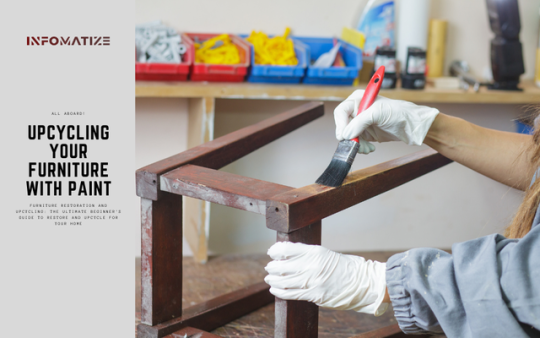
Upcycling your furniture with paint is an excellent way to refresh your interiors without spending a lot of money, and it's also great for the environment because it reduces waste and the need for new materials . Before you start painting, there are some steps you need to follow. First, you should sand down the furniture and ensure that it is very secure and out of the way when you begin to paint . It's also essential to clean your furniture and remove any old paint before beginning to paint . Once you have prepped your furniture, you can begin to paint. It's important to stir your paint well and work in small sections, including the edges. Eggshell paint is best for upcycling furniture, and you may need to apply a second coat depending on the desired finish . You can use any brand of paint in eggshell for a matte finish or satinwood for a semi-matte finish. Before you start painting, be sure to use painter's tape to tape down sections that you don't want to paint . Using chalk paint is another option for upcycling your furniture. An oval bristle brush will work best when using chalk paint, and you can achieve a variety of finishes with different techniques . Additionally, you can whitewash your furniture by adding water to white latex paint in a 1:1 mixture, brushing it on the furniture, and then wiping off the paint mixture in long strokes with a moist rag in the direction of the grain until you achieve the desired look . Overall, upcycling your furniture with paint is an excellent way to give it new life while also being environmentally friendly. With proper preparation and technique, you can achieve beautiful results with different types of paint, including eggshell, chalk paint, and whitewash. Choosing the Right Paint for Your Project Choosing the right paint for your project can be overwhelming, but it doesn't have to be. The first step is to determine the surface you will be painting and the type of finish you want. Paint finishes can range from flat to glossy, and each has its own advantages and disadvantages . Read the full article
#andhinges#Australia#Austria#Beginner'sguidetofurniturerestoration#Belgium#Bestproductsforfurniturerestoration#Bestwaystocleanandrestoreleatherfurniture#Canada#Denmark#DIYfurnituremakeover#DIYfurniturerestoration#DIYfurniturerestorationtechniques#Eco-friendlyfurnitureupcyclingideas#Finland#France#Furnitureflipping#Furnituremakeover#Furnituremakeoverideas#Furniturepainting#Furniturerefurbishing#Furniturerehab#Furniturerepair#Furniturerestoration#Furniturerestorationmistakestoavoid#Furniturerestyling#Furniturerestylingtipsandtricks#Furnituretransformation#Furnitureupcyclingideas#Furnitureupcyclingprojects#Germany
0 notes
Text
10 Surprising Facts About Breast Cancer You Need to Know
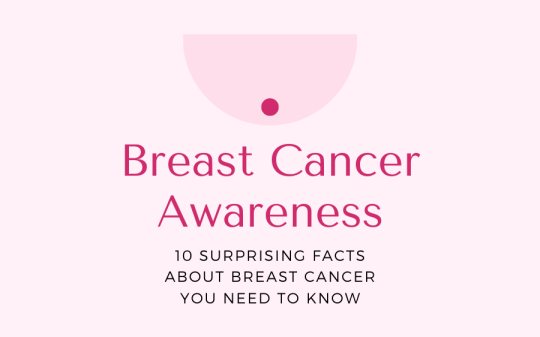
Introduction
Breast cancer is a significant health concern that affects millions of women around the world. It is the most common cancer among American women, and one in eight women will develop the disease in their lifetime . Early detection is crucial as it greatly increases cancer survival rates, and with early detection, the five-year survival rate for breast cancer is nearly 100% . In this essay, we will explore ten surprising facts about breast cancer that you need to know. It is not just a women's issue; it can also affect men, although it is rare. About one in a thousand men in the United States will experience breast cancer in their lifetime . Age is a significant factor in breast cancer risk, and a woman's risk for developing breast cancer increases as she gets older. In fact, the chances of developing breast cancer are 12% for women or 1 in 8 . it can be a fatal disease, and it is the second leading cause of cancer-related death among American women. However, there are over 3 million breast cancer survivors in the United States, and early detection and treatment can significantly improve survival rates . Breast cancer research has made significant strides in recent years. Scientists have discovered that there are different types of breast cancer, and each type responds differently to a treatment. In addition, genetic testing can help identify women who may be at a higher risk of developing breast cancer . It affects women from all walks of life, regardless of their race, ethnicity, or socioeconomic status. It is crucial to raise awareness about the disease and promote early detection and treatment to improve survival rates . In conclusion, breast cancer is a significant health concern that affects millions of women around the world. Early detection and treatment are critical in improving survival rates, and research continues to make strides in identifying new treatments and risk factors. By raising awareness and promoting early detection, we can make a significant impact in the fight against breast cancer.
Breast Cancer Statistics

Breast cancer is a type of cancer that begins in the breast tissue. Here are some key statistics: - Breast cancer is currently the most common cancer globally, accounting for 12.5% of all new annual cancer cases worldwide . - Breast cancer is the most common cancer in women in the United States, except for skin cancers . - In the United States, it is estimated that about 297,790 new cases of invasive breast cancer will be diagnosed in women in 2023 . - Breast cancer incidence rates have risen in most of the past four decades; during the most recent data years (2010-2019), the rate increased by 0.5% annually, largely driven by localized-stage and hormone receptor-positive disease . - Breast cancer is the second leading cause of cancer death in women in the United States, after lung cancer . - In 2022, about 13% (about 1 in 8) of U.S. women are expected to develop invasive breast cancer in the course of their life . - In 2022, it is estimated that breast cancer will account for approximately 30% of all new women cancer diagnoses in the United States . - Females had much higher rates of getting breast cancer than those dying from breast cancer in the United States. In 2019, 264,121 new breast cancers were reported in females and 42,280 females died from breast cancer . - For women, the three most common cancers are breast, lung, and colorectal, and they will account for an estimated 50% of all new cancer diagnoses in women in 2020 . It's important to note that breast cancer statistics may vary depending on factors such as age, race/ethnicity, family history, and lifestyle factors. It's also important to talk to a healthcare provider about breast cancer screening and risk factors. The Prevalence of Breast Cancer in Women It is the most common cancer among women in the United States, except for skin cancers . It is estimated that approximately 1 in 8 women in the U.S. will develop invasive breast cancer over the course of their lifetime, which is approximately 12.9% of women based on data from 2017-2019 . In 2022, it is estimated that there will be 287,850 new cases of invasive breast cancer and 51,400 new cases of non-invasive (in situ) breast cancer diagnosed in women in the U.S. . It is important to note that rates of breast cancer vary among different groups of people, including women and men, people of different ethnicities, and different ages . Black women, in particular, have a higher mortality rate from breast cancer than white women in the U.S. . Globally, breast cancer is the most prevalent cancer among women, with 2.3 million new cases in 2020 and 685,000 deaths . The ten countries with the highest rates of breast cancer in women and the highest number of deaths from breast cancer in women in 2020 were shown in a report by the World Cancer Research Fund . Breast cancer can be divided into four main subtypes: HR+/HER2-, HR-/HER2-, HR+/HER2+, and HR-/HER2+. These subtypes are ordered by prevalence, with HR+/HER2- being the most common subtype. HR stands for hormone receptor, and HR+ means that tumour cells have receptors for the hormones estrogen or progesterone, which can promote the growth of HR+ tumours . In summary, breast cancer is prevalent cancer among women, with approximately 1 in 8 women in the U.S. developing invasive breast cancer over the course of their lifetime. Rates of breast cancer vary among different groups of people, and Black women have a higher mortality rate from breast cancer than white women in the U.S. Breast cancer is also the most prevalent cancer among women globally, with four main subtypes that can be distinguished by hormone receptor status and HER2 expression. The Incidence of Breast Cancer in Men Breast cancer is much less common in men than in women, with only about 1 out of every 100 breast cancers being diagnosed in a man in the United States . Men have a lifetime risk of getting breast cancer of about 1 in 833, compared to 1 in 8 for women in the United States . In 2023, an estimated 2,800 men in the United States will be diagnosed with breast cancer . The most common kind of breast cancer in men is invasive ductal carcinoma, which begins in the ducts and then grows outside the ducts into other parts of the breast tissue . Nearly all male breast cancer is ductal carcinoma, and other types of breast cancer that can occur in men include Paget's disease of the nipple and inflammatory breast cancer, although these are rarer . Incidence and death rates of male breast cancer are highest among men aged 80 years or older, although men aged 60 to 69 years account for the highest proportion of male breast cancer cases and deaths . In conclusion, while breast cancer in men is rare, it is still important for men to be aware of the signs and symptoms and to discuss any concerns with their healthcare provider, particularly if they have a family history of breast cancer or other risk factors . The Mortality Rate of Breast Cancer Breast cancer is a significant health concern, and understanding its mortality rate is important for public health efforts. According to the National Cancer Institute (NCI), an estimated 281,550 women were diagnosed with breast cancer in the United States in 2021, and about 43,600 women died of the disease that year . It is also estimated that about 43,250 women in the U.S. will die from breast cancer in 2022 . The mortality rate of breast cancer has been decreasing steadily since 1989, with an overall decline of 43% through 2020. This translates to 460,000 fewer breast cancer deaths during that time . The death rate for breast cancer dropped to 19.6 per 100,000 women per year based on 2015-2019 cases and 2016-2020 deaths . Breast cancer mainly occurs in middle-aged and older women, with the median age at the time of diagnosis being 62 years old. This means that half of the women who developed breast cancer are 62 years of age or younger when they are diagnosed. . The five-year relative survival rate for breast cancer varies based on the stage of cancer. If the cancer is located only in the breast, the five-year survival rate is 99%. The average five-year survival rate for all people with breast cancer is 89%, the 10-year rate is 83%, and the 15-year rate is 78% . These rates suggest that early detection and treatment are critical in improving survival rates. Finally, the mean breast cancer mortality rate was 13.77 per 100,000 in 1990 worldwide, and the overall slope of the mortality rate was 0.7 per 100,000 from 1990 to 2015. Latin America and the Caribbean showed the highest increasing trend of breast cancer mortality rate from 1990 to 2015 (1.48 per 100,000) .
Breast Cancer Risk Factors
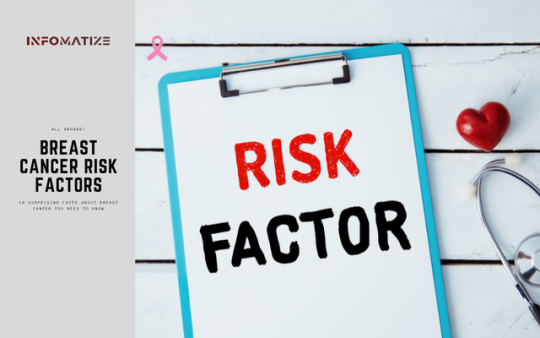
Breast cancer is a type of cancer that can result from multiple environmental and hereditary risk factors. Risk factors for breast cancer may be divided into preventable and non-preventable factors, which are studied in the field of epidemiology . Some of the main factors that increase the risk of breast cancer include being a woman and getting older. Most breast cancers are found in women who are 50 years old or older. Having a risk factor does not mean you will get the disease, and not all risk factors have the same effect . Other factors associated with an increased risk of breast cancer include a personal history of breast conditions, increasing age, and being female . While some breast cancer risk factors, such as family history and ageing, cannot be changed, there are some that can be controlled, such as lack of exercise, smoking cigarettes, and eating certain foods. These lifestyle-related risk factors can be changed by making healthier choices . Additionally, reproductive factors such as early menarche, late menopause, late age at first pregnancy, and low parity can increase breast cancer risk. Each 1-year delay in menopause increases the risk of breast cancer by 3%, while each 1-year delay in menarche or each additional birth decreases the risk of breast cancer by 5% or 10%, respectively . First-degree relatives of patients with breast cancer have a 2-fold to 3-fold excess risk for developing the disease, while 5% to 10% of all breast cancer cases are due to genetic factors, which may account for 25% of cases in women younger than 30 years . Women in certain subgroups may also have an increased risk of breast cancer, although these predictions do not allow one to say precisely which woman will develop breast cancer. In fact, some women who do not develop breast cancer have higher risk estimates than some women who do develop breast cancer . It is important to note that having a risk factor for breast cancer does not necessarily mean that a person will develop the disease. Likewise, not having any risk factors does not guarantee that a person will not develop breast cancer. Regular screening and early detection are crucial for improving outcomes in breast cancer cases. Women should talk to their healthcare providers about their personal risk factors and any recommended screening tests or preventive measures that they may need . Genetic Predisposition to Breast Cancer Breast cancer is a complex disease that can be caused by various factors, including genetic predisposition. About 5% to 10% of breast cancers are thought to be hereditary, caused by abnormal genes passed from parent to child . Genetic testing for breast cancer susceptibility is widely used to identify individuals who have an increased risk of developing breast cancer . Currently, three classes of predisposition factors are known to be associated with an increased risk of breast cancer : - High-penetrance breast cancer predisposition genes, including BRCA1 and BRCA2, which are identified by genome-wide linkage analysis and positional cloning. - Moderate-penetrance genes, including CHEK2, ATM, and PALB2. - Low-penetrance genes, including FGFR2, MAP3K1, and LSP1. Cancer-related genetic changes can occur due to random mistakes in our DNA, carcinogens in our environment, and inherited gene mutations . Genetic testing for hereditary breast and ovarian cancer looks for mutations in the BRCA1 and BRCA2 genes, which are the most common high-penetrance genes associated with an increased risk of breast cancer . Inheriting certain gene changes, about 5% to 10% of breast cancer cases are thought to be hereditary, meaning that they result directly from gene changes passed on from a parent. Most breast cancers are found in women aged 55 and older . A hereditary predisposition to breast cancer significantly influences screening and follow-up recommendations for high-risk women. However, in patients with a suggestive personal and/or family history, a specific predisposing gene is identified in less than 30% of cases . Male breast cancer is much more likely to be related to a genetic predisposition than breast cancer in women. Children who develop cancer may have a genetic predisposition, but they do not always have a family history of cancer. A study of over 1000 children with cancer found that 8.3% had predisposing gene mutations . The risk of breast and ovarian cancer is very high in women with mutations in either BRCA1 or BRCA2. This syndrome can also lead to fallopian tube cancer, primary peritoneal cancer, male breast cancer, pancreatic cancer, and prostate cancer, as well as some others. Some people might have more than one cancer . ICD-10-CM code Z15.01 is used to indicate a genetic susceptibility to malignant neoplasm of the breast, and it became effective on October 1, 2022 . The Impact of Age on Breast Cancer Risk Breast cancer risk increases as a person gets older . Age is an established risk factor for breast cancer, with rates of breast cancer being low in women under 40. About 4 per cent of women diagnosed with breast cancer in the U.S. are younger than 40 . The ageing process is one of the biggest risk factors for breast cancer in women because genetic damage (mutations) in the body increases with age, and as we age, our bodies are less capable of repairing genetic damage . Breast cancer incidence rates for all cancer types climb steadily as age increases, with more than 1,000 cases per 100,000 people in age groups 60 years and older . Women over 50 years of age accounted for approximately 78% of new breast cancer cases and 87% of breast cancer-related deaths in the United States in 2011 . Age at diagnosis of the first breast cancer is a significant predictor of contralateral breast cancer risk in BRCA1/2 mutation carriers . Age at first childbirth also impacts breast cancer risk, with women who give birth to their first child at age 35 or younger having a decreased risk of breast cancer, and breast cancer risk is increased for about 10 years after a first birth . Women who have their first full-term pregnancy at an early age have a decreased risk of developing breast cancer later in life . The Role of Lifestyle Choices in Breast Cancer Risk Breast cancer is a disease that affects many women worldwide. Lifestyle choices have been shown to play a significant role in increasing or decreasing the risk of breast cancer. According to the Mayo Clinic, limiting alcohol intake is a lifestyle change that can decrease the risk of breast cancer, even in women at high risk . The American Cancer Society recommends at least 150 minutes of medium-intense activity each week, such as yoga and biking, to lower the risk of breast cancer . Other lifestyle-related breast cancer risk factors include diet and physical activity . High-fibre foods have been associated with a decreased risk of breast cancer recurrence . A Mediterranean diet has also been linked to a decreased risk of breast cancer . Smoking is a lifestyle choice that can increase the risk of breast cancer, especially in women who started smoking early and have not reached menopause . It is important to note that having a risk factor, or even many, does not mean that a person is sure to get the disease. Healthy lifestyle choices are linked to a lower risk of some cancers and other health conditions such as heart disease, diabetes, and osteoporosis . Despite improved treatment strategies for each characteristic molecular breast cancer subtype, recommendations for evidence-based preventive strategies for breast cancer treatment are not given equivalent attention . In conclusion, lifestyle choices such as limiting alcohol intake, being physically active, consuming high-fibre foods, and avoiding smoking can play a significant role in decreasing the risk. It is essential to integrate these healthier habits into everyday life, but it can be difficult .
Breast Cancer Symptoms

Breast cancer symptoms can vary depending on the type and stage of cancer. The most common symptoms include a breast lump or thickening that feels different from the surrounding tissue, a change in the size, shape, or appearance of a breast, changes to the skin over the breast such as dimpling, and a newly inverted nipple . Other possible symptoms include thickening or swelling of part of the breast, irritation or dimpling of breast skin, redness or flaky skin in the nipple area or the breast, pulling in of the nipple or pain in the nipple area, nipple discharge other than breast milk, including blood, pain in any area of the breast, and unusual warmth of the affected breast . Breast cancer symptoms can also include swelling of all or part of the breast, breast pain, nipple pain, nipple turning inward, redness, scaliness, or thickening of the nipple or breast skin, and a lump in the underarm area . These symptoms can also be signs of less serious conditions such as an infection or a cyst. If breast cancer is suspected, other tests will be done to determine the stage of cancer, which is determined by whether the cancer is only in the breast, found in lymph nodes under the arm, or has spread outside the breast . If you notice any changes in your breast, it's important to see a doctor for evaluation. Finding breast cancer early gives you a better chance of successful treatment . Lump or Thickening in the Breast A lump or thickening in the breast can be concerning, but it is important to note that not all lumps are cancerous. Some lumps may be due to hormonal changes, infections, or benign breast conditions . However, if you notice a lump or thickening in your breast, it is important to have it evaluated by a healthcare professional to determine the cause and appropriate course of action. Breast cancer can present as a painless, hard, irregularly shaped lump that is different from the surrounding breast tissue . The skin covering the lump may appear red, dimpled, or pitted like the skin of an orange. In some cases, breast size and shape may change or nipple discharge may occur . Read the full article
#Australia#Austria#Belgium#BRCAgenemutations#Breastcancerandbonehealth#Breastcancerandbreastreconstruction#Breastcancerandcaregiving#Breastcanceranddiet#Breastcancerandemotionalwell-being#Breastcancerandenvironmentalfactors#Breastcancerandexercise#Breastcancerandfamilyhistory#Breastcancerandfertility#Breastcancerandgenetics#Breastcancerandhearthealth#Breastcancerandlifestylefactors#Breastcancerandlymphedema#Breastcancerandmenopause#Breastcancerandmentalhealth#Breastcancerandpregnancy#Breastcancerandsexualhealth#Breastcancerandstress#Breastcancerawareness#Breastcancerclinicaltrials#Breastcancerdiagnosis#Breastcancerfacts#Breastcancerinolderwomen#Breastcancerinyoungwomen#Breastcancerprevention#Breastcancerrecurrence
0 notes
Text
Health Concerns: A Comprehensive Guide to Focusing on Specific Women's Health and Men's Health Concerns
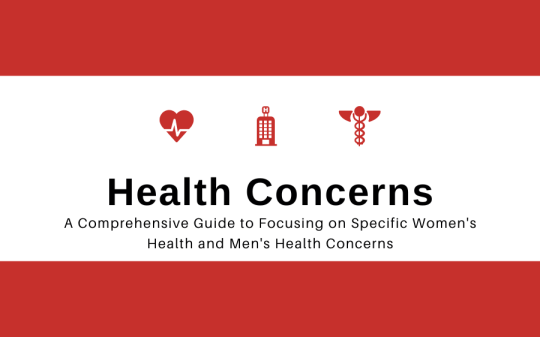
Introduction
Women's health and men's health are distinct fields of study that address specific health concerns for each gender. While both genders face certain health concerns, some conditions and diseases affect women differently than men, and vice versa. In this response, I will focus on specific health concerns for women and men. Women's Health: Women experience many unique health issues, such as pregnancy, childbirth, and menopause, that require specialized care and attention. Additionally, some health issues that affect both men and women pose unique challenges for women . For example, breast cancer affects women at a higher rate than men, and some conditions, like uterine fibroids and pelvic floor disorders, affect women primarily or more severely than men . Addressing racial disparities in pregnancy-related deaths, surveillance of hypertension among women of reproductive age, and analyzing maternal mortality-related federal legislation are also important aspects of women's health . Men's Health: Men also face specific health concerns that require specialized care and attention. For example, about 35 per cent more men than women are diagnosed with and die from colon cancer . Men are also more likely to experience certain health conditions like prostate cancer, erectile dysfunction, and male infertility . Addressing men's mental health is also an important aspect of men's health. Men are less likely to seek help for mental health issues, which can lead to higher rates of suicide and substance abuse . In conclusion, women's health and men's health are distinct fields of study that address specific health concerns for each gender. While some conditions affect both genders, addressing the unique health concerns of each gender is important for improving overall health outcomes. It is crucial to address the barriers and challenges faced by women, men, girls, boys, and gender-diverse people to achieve gender equality and ensure health and well-being for all .
Women's Health Issues

Women's health issues refer to medical conditions and concerns that specifically affect women. These issues can range from reproductive health concerns, such as pregnancy-related complications and gynaecological conditions, to broader health concerns, such as cardiovascular disease and mental health. Here are some key points to consider about women's health issues based on the provided search results: - Women's health is a broad field that encompasses a range of medical concerns and conditions that affect women throughout their lives . - Racial disparities in pregnancy-related deaths are a significant concern in the United States, and the CDC has analyzed maternal mortality-related federal legislation to address this issue . - Women face unique health challenges related to mental health, including higher rates of depression and suicide . - Certain health issues, such as heart disease and breast cancer, are among the top health risks for women . - Women's Health Issues (WHI) is a peer-reviewed journal that publishes research and review manuscripts related to women's healthcare and policy and is dedicated to improving the health and healthcare of all women throughout their lifespans . - Women may face discrimination and sociocultural barriers that impact their health and healthcare, making the health of women and girls a particular concern . - The FDA Office of Women's Health provides information and resources on women's health topics . - Women's health nurse practitioners play an important role in addressing women's health issues and providing specialized care . Overall, addressing women's health issues requires a multifaceted approach that takes into account factors such as race, culture, and socioeconomic status, as well as specific medical conditions and concerns. Regular healthcare check-ups, preventive care, and targeted interventions can all help improve women's health outcomes and quality of life. Common Gynecological Issues Faced by Women There are several common gynaecological issues that women may face. Here are some of them: - Pelvic Inflammatory Disease (PID): PID is an infection of the female reproductive organs, which can lead to infertility, multiple miscarriages, or early labour. Symptoms include feeling full in the lower abdomen, urinating often, pain during sex, and lower back pain. It is important to see your healthcare provider for routine exams to detect this condition. - Urinary Tract Infection (UTI): UTI is one of the most common gynaecological problems faced by women of all age groups. This usually occurs when bacteria present in the vagina or anus move up to the urethra and bladder, and in some cases even kidneys. Symptoms include pain or burning during urination, frequent urination, and cloudy or strong-smelling urine. - Dysmenorrhea: Dysmenorrhea is a painful menstrual cycle that can be primary (no associated pelvic disease) or secondary (associated with pelvic pathology). Symptoms include severe cramps and pain during periods. - Sexual dysfunction: This can involve a lack of sexual interest and willingness to be sexual or difficulty with arousal or become sexually aroused. It can affect a woman's quality of life and cause stress or relationship issues. - Uterine fibroids and pelvic floor disorders: These are two other gynaecological conditions that women may experience. Uterine fibroids are non-cancerous growths in the uterus that can cause heavy bleeding and pain, while pelvic floor disorders involve the weakening of the muscles that support the pelvic organs, leading to bladder and bowel control problems. It is important to consult with a healthcare provider if you experience any of these symptoms or have concerns about your gynaecological health. Regular check-ups and screenings can help detect potential issues early on and prevent complications. Understanding Menstrual Health: Challenges and Solutions Menstrual health is an important aspect of women's health and well-being. However, women may experience various menstrual problems that can affect their daily lives. Some of the common menstrual problems include premenstrual syndrome (PMS), irregular periods, heavy bleeding, and menstrual pain . These problems can be caused by various factors, such as hormonal imbalances, stress, reproductive organ problems, and health conditions such as polycystic ovary syndrome (PCOS) . Furthermore, women worldwide face challenges related to menstrual management, including stigma, privacy, and access to affordable materials . Access to menstrual products and adequate facilities for menstrual hygiene management (MHM) is essential to effectively manage menstruation. However, an estimated 500 million women lack access to these resources . Managing menstrual problems and maintaining menstrual health involves various strategies, such as stopping smoking, using heating pads, hot water bottles, or warm baths to ease pain, trying gentle forms of exercise, such as walking, tai chi, or yin yoga, and managing stress and making time for self-care . It is important for women to seek medical attention if they experience severe or unusual menstrual problems or if their periods interfere with their daily activities. Navigating Pregnancy: Health Tips and Precautions for Expectant Mothers Pregnancy is an exciting and challenging time for expectant mothers. It is important to prioritize health and take necessary precautions to ensure a safe and healthy pregnancy. Here are some tips and precautions for navigating pregnancy based on the provided web search results: - Seek prenatal care: Good prenatal care is essential for a healthy pregnancy. Find an ob-gyn or midwife you feel comfortable with and follow their recommended prenatal care plan . - Avoid harmful substances: Exposure to radiation, pesticides, some metals, and certain chemicals can cause birth defects, premature birth, and miscarriage. It is important to avoid contact with potentially harmful substances until you check with your healthcare provider . - Practice good oral hygiene: Nearly 60 to 75% of pregnant women have gingivitis, an early stage of periodontal disease that occurs when the gums become red and swollen from inflammation that may be aggravated by changing hormones during pregnancy. Untreated gingivitis can lead to periodontal disease, which can cause bone loss and tooth loss . - Stay hydrated: Drinking water during pregnancy can prevent constipation, haemorrhoids, UTIs, fatigue, headaches, swelling, and other uncomfortable pregnancy symptoms. Aim for at least 8 to 12 cups of water per day . - Exercise regularly: Building strength and reducing stress with a good exercise program can improve pregnancy outcomes. Talk to your healthcare provider about safe and appropriate exercise during pregnancy . - Know the risks associated with maternal age: Women over the age of 35 have a higher risk of pregnancy-related complications that might lead to a C-section delivery. Babies born to older mothers have a higher risk of certain chromosomal conditions, such as Down syndrome. The risk of pregnancy loss is also higher . It is important to discuss these risks with your healthcare provider and make informed decisions about your pregnancy.
Men's Reproductive Health

Men's reproductive health is an important component of their overall health and well-being, yet it is often overlooked in discussions of reproductive health . Reproductive issues such as contraception and infertility have often been perceived as female-related, leaving men out of the conversation . However, men and their partners face unique challenges related to their reproductive health, including issues with sexual function, testicular cancer, prostate cancer, and infertility . There is a growing recognition of the need to address men's reproductive health. In her book "GUYnecology: The Missing Science of Men's Reproductive Health," Yale sociologist Rene Almeling argues that men's reproductive health has been neglected in both medical research and public discourse . The male reproductive system includes both external and internal organs, including the penis, scrotum, testicles, vas deferens, prostate, and urethra . It is responsible for sexual function and urination. Men can seek reproductive health services from a variety of healthcare providers, including primary care providers, urologists, and reproductive endocrinologists . Planned Parenthood also provides reproductive and sexual health services for men, including cancer screenings and contraception counselling . Dermatologists specialize in the treatment of the skin, hair, and nails and can also provide care for skin conditions that affect the genital area . Factors that can affect men's reproductive health include diet, lifestyle, medical conditions, and occupational exposures . It is important for men to prioritize their reproductive health by seeking regular checkups and discussing any concerns with their healthcare provider. By doing so, men can take control of their reproductive health and ensure that they receive the care they need to maintain their overall well-being. Male Fertility: Understanding the Causes of Infertility and Available Treatments Male infertility refers to the inability of a man to contribute to conception, either due to a lack of viable sperm or issues with sperm function or delivery. There are various causes of male infertility, including biological and environmental factors, as well as lifestyle choices . Some common causes include: - Azoospermia: the inability to produce sperm cells - Oligospermia: low or poor-quality sperm production - Genetic diseases such as Klinefelter's syndrome, myotonic dystrophy, and microdeletion - Erectile dysfunction or decreased libido can limit opportunities for conception - Blockages that prevent the delivery of sperm Diagnosing male infertility typically involves a physical examination and medical history, as well as semen analysis to evaluate sperm count, motility, and morphology . Depending on the underlying cause, treatments for male infertility may include lifestyle modifications, medication, surgery, or assisted reproductive technologies such as intrauterine insemination (IUI) or in vitro fertilization (IVF) . In summary, male infertility can have multiple causes, ranging from genetic factors to lifestyle choices. Diagnosis typically involves a physical exam and semen analysis, and treatment options may vary depending on the underlying cause of infertility. It is important for couples struggling with infertility to seek medical advice and support to help identify the cause and explore treatment options. Testicular and Prostate Cancer: Early Detection and Prevention Testicular and prostate cancer are two different types of cancer that affect male reproductive organs. Here is some information on the early detection and prevention of each: Testicular Cancer: Testicular cancer is a rare type of cancer that mainly affects young men between the ages of 15 and 35, but it can occur at any age. Early detection is important, as the prognosis for testicular cancer is often excellent if it is caught early. Signs and symptoms of testicular cancer may include a lump or swelling in the testicle, pain or discomfort in the testicle or scrotum, and a feeling of heaviness in the scrotum . Self-examination is a useful way to detect testicular cancer early. Men should examine their testicles once a month for lumps or nodules, and any changes in size, shape, or texture . If any of these changes are noticed, men should consult their doctor. A doctor may perform a physical examination, blood tests, and imaging tests, such as a CT scan or ultrasound, to diagnose testicular cancer . Prostate Cancer: Prostate cancer is the most common cancer in men, with the risk increasing as men age. Early detection and prevention can significantly increase the chances of successful treatment and long-term survival. Men should talk to their doctor about when to begin prostate cancer screening based on their individual risk factors. The two most common tests used for screening are a digital rectal exam (DRE) and a prostate-specific antigen (PSA) blood test . Men can reduce their risk of developing prostate cancer by adopting a healthy lifestyle, including regular exercise, maintaining a healthy weight, eating a balanced diet, and not smoking. Studies have also shown that certain nutrients, such as lycopene and selenium, may help reduce the risk of prostate cancer . In summary, early detection and prevention are critical for the successful treatment of testicular and prostate cancer. Men should be aware of the signs and symptoms of these cancers, and talk to their doctor about when to begin screening based on their individual risk factors. A healthy lifestyle may also help reduce the risk of developing these cancers. Erectile Dysfunction: Causes, Diagnosis, and Treatment Options Erectile dysfunction (ED) is a condition in which a man has difficulty getting or maintaining an erection that is firm enough for sexual intercourse. It can be caused by a number of factors, including vascular disease, neurological disorders, and psychological factors such as anxiety or depression. According to the Mayo Clinic, having erection trouble from time to time isn't necessarily a cause for concern, but if it becomes an ongoing issue, it can cause stress, affect self-confidence, and contribute to relationship problems . Vascular disease, including atherosclerosis (hardening of the arteries), can block or narrow the blood supply to the penis, while neurological disorders such as multiple sclerosis can damage the nerves that send impulses to the penis . ED may also be a major warning sign of cardiovascular disease, indicating that blockages are building in a man's vascular system. The specific treatment plan for ED will depend on the underlying causes. A doctor may recommend lifestyle changes such as quitting smoking, limiting or stopping alcohol consumption, increasing physical activity, and maintaining a healthy body weight . Other treatment options may include medication, such as phosphodiesterase type 5 (PDE5) inhibitors like sildenafil (Viagra), tadalafil (Cialis), and vardenafil (Levitra), hormone therapy, penile injections, or surgery in severe cases . It's important to consult with a healthcare professional to determine the best course of treatment for ED.
Gender-Specific Health Concerns

Gender-specific health concerns are medical issues that predominantly affect one gender over the other. These concerns vary based on biological differences between males and females and may include physical, mental, and social factors. Here are some examples of gender-specific health concerns: - Women's Health Concerns: Women experience unique health issues and conditions such as pregnancy, menopause, and gynaecological conditions like uterine fibroids and pelvic floor disorders. Other health concerns that predominantly affect women include breast and cervical cancer, osteoporosis, and autoimmune diseases . - Men's Health Concerns: Some health conditions that affect men more commonly than women include prostate cancer, testicular cancer, erectile dysfunction, and male infertility. Men are also more likely to experience heart disease, stroke, and other cardiovascular conditions . - Transgender and Gender-Diverse Health Concerns: Transgender and gender-diverse individuals face specific health risks, often due to gender minority stress that can result from negative attitudes and disapproval toward them. Some common health concerns for this population include hormone therapy-related risks, mental health issues like depression, anxiety, and substance abuse, and higher rates of HIV and sexually transmitted infections . In conclusion, gender-specific health concerns are diverse and vary according to biological, social, and cultural factors. It is essential to understand and address these issues to provide optimal healthcare to individuals of all genders. It is crucial to seek medical attention promptly if you experience any health issues, regardless of your gender. Cardiovascular Health: Differences in Symptoms and Treatment for Men and Women Cardiovascular disease (CVD) affects both men and women, but there are differences in how it can manifest and be treated. According to recent studies, women also have their own unique heart disease risk factors, including metabolic syndrome, high levels of C-reactive protein, and autoimmune diseases . One major issue in the diagnosis and treatment of CVD is the general lack of awareness of women's heart disease, which may lead to doctors or patients missing heart attacks in women or delaying their diagnosis . Symptoms of heart disease can also differ between men and women. While chest pain is the most common symptom for both sexes, men are more likely to experience it than women. Read the full article
0 notes
Text
Medical Conditions and Diseases: The Ultimate Guide to Explained Symptoms, Causes, and Treatment Options

Introduction
There are numerous medical conditions and diseases that affect people, and it is important to have a basic understanding of their symptoms, causes, and treatment options. Here is a brief overview of some of the conditions and diseases that are commonly encountered: Heart conditions: The Mayo Clinic's highly specialized heart experts can diagnose and treat more than 200 heart conditions, including many rare and complex disorders . Some of the conditions treated include congenital heart disease in adults and heart arrhythmia. Genetic diseases and infectious diseases: Live Science provides an A-Z guide covering some of the more common diseases and conditions, including a definition and the causes, symptoms, and treatments of various genetic diseases as well as infectious diseases . Cancer: Signs and symptoms caused by cancer will vary depending on what part of the body is affected. Some general signs and symptoms associated with, but not specific to, cancer, include fatigue, a lump or area of thickening that can be felt under the skin, and weight changes, including unintended loss or gain . Inflammation: Inflammation can occur as a result of an injury or illness, and there are five key signs of acute inflammation: pain, redness, heat, swelling, and loss of function . Coagulation disorders: Coagulation disorders can cause blood to clot too much or too little, leading to various symptoms such as blood in urine or stool, heavy bleeding during menstruation or after childbirth, bleeding under the skin, redness and swelling around the body, and umbilical stump bleeding in newborns . Respiratory diseases: U.S. News and World Report's condition guide provides information on common respiratory diseases, including their symptoms, causes, and treatment options . Decidual cast: A decidual cast is when the uterine lining sheds in one large piece resembling the shape of the uterus. It can be painful but is rare and doesn't usually cause long-term complications . ADHD: Medications and different types of psychotherapy are common forms of treatment for ADHD. Therapy approaches can help individuals with ADHD learn how to adapt to or cope with the effects of the condition. Therapy can also help with other mental health conditions, such as anxiety or depression, which commonly occur along with ADHD . Diabetes: The symptoms of type 1, type 2, and type 1.5 diabetes are the same, but they occur in a shorter period than types 2 and 1.5. In type 2 diabetes, the onset tends to be slower. Tingling can occur in the hands and feet, and individuals may also experience increased thirst and frequent urination . Overall, understanding the symptoms, causes, and treatment options for various medical conditions and diseases can help individuals make informed decisions about their health and seek appropriate medical care when necessary. It is important to consult a healthcare professional for personalized advice on managing any medical condition.
Common Medical Conditions and Diseases

There are many common medical conditions and diseases that affect people of all ages and backgrounds. The following is a list of some of the most prevalent conditions and diseases, along with resources for further information: - Heart disease: Mayo Clinic is a renowned medical institution that provides diagnosis and treatment for more than 200 heart conditions, including congenital heart disease in adults and heart arrhythmia. - Asthma: The Centers for Disease Control and Prevention (CDC) offers information on asthma and how it affects the community. The CDC also provides resources on influenza, which can be particularly dangerous for those with asthma. - Cancer: Johns Hopkins Medicine provides information on various types of cancer affecting different parts of the body, including the brain, nerves and spine, breast, head and neck, kidney and bladder, eyes, prostate, stomach and gut. - Respiratory diseases: NHS Inform provides a list of common respiratory conditions, including chronic obstructive pulmonary disease, colds, coughs, and coronavirus (COVID-19). - Various conditions and diseases: U.S. News and World Report have a comprehensive condition guide that covers symptoms, causes, and treatment options for various conditions and diseases. - Comprehensive A-Z list of diseases and conditions: MedicineNet provides a comprehensive A-Z list of medical conditions and diseases. - Arthritis and musculoskeletal diseases: The National Institute of Arthritis and Musculoskeletal and Skin Diseases (NIAMS) supports research into the causes, treatment, and prevention of arthritis and musculoskeletal and skin diseases. - Other diseases and conditions: The Health Site provides a list of various diseases and conditions, including carpal tunnel syndrome, osteomyelitis, osteoporosis, slipped disc, cervical spondylosis, and skin diseases. - Chronic diseases in older adults: The National Council on Aging (NCOA) identifies the top 10 most common chronic conditions in older adults, including ischemic heart disease, which is caused by a build-up of plaque that narrows the arteries leading to the heart. - Children's diseases: WebMD provides information on common childhood illnesses, including ADHD, birthmarks, and skin rashes. In conclusion, there are many common medical conditions and diseases that affect people of all ages, ranging from heart disease and asthma to cancer and respiratory diseases. It is important to stay informed about these conditions and to seek medical attention when necessary. The resources listed above provide valuable information on symptoms, causes, and treatment options for these conditions and diseases. Understanding the Symptoms of Common Medical Conditions Understanding the symptoms of common medical conditions is important in identifying potential health issues and seeking appropriate medical care. Fortunately, there are several online resources that can provide information on the signs and symptoms of various health conditions. One such resource is the Mayo Clinic website, which features a list of over 200 heart conditions, including many rare and complex disorders, and provides information on their symptoms and treatment options . The website also offers a search function to help users find specific conditions and related information. Medical News Today provides a helpful distinction between signs and symptoms of health problems. A sign is an observable effect of a health problem, while a symptom is experienced only by the person with the condition . This distinction can be useful in identifying potential health issues. For a comprehensive list of common illnesses and conditions, the NHS Inform website offers an A to Z guide that includes information on symptoms, causes, and treatments . The website also provides advice on when to seek medical attention for specific conditions. Hopkins Medicine offers a list of common signs and symptoms of nervous system disorders, which can include persistent or sudden onset of a headache, changes in sensation or tingling, and loss of feeling . These symptoms may indicate the presence of a nervous system disorder and should be evaluated by a medical professional. Finally, Live Science provides an A-Z guide to causes, symptoms, and treatments of genetic, infectious, and communicable diseases, including heart disease, diabetes, and cancer . This resource can be helpful for understanding the symptoms of various diseases and seeking appropriate medical care. In summary, there are several online resources available to help individuals understand the symptoms of common medical conditions, including the Mayo Clinic, Medical News Today, NHS Inform, Hopkins Medicine, and Live Science. It is important to consult with a medical professional for accurate diagnosis and treatment. Common Causes of Medical Conditions and Diseases Medical conditions and diseases can have various causes, including genetic, infectious, autoimmune, and environmental factors. Here are some examples of common causes of medical conditions and diseases: - Genetic Causes: Some medical conditions and diseases are caused by genetic factors, which can be inherited from parents. These conditions can include congenital heart disease and various genetic diseases, such as cystic fibrosis and sickle cell anaemia . - Infectious Causes: Infectious diseases are caused by microorganisms such as bacteria, viruses, and parasites. They can be transmitted through direct contact with an infected person or an object contaminated with the microorganism. Common infectious diseases include the flu, chickenpox, and sexually transmitted infections . - Autoimmune Causes: In autoimmune diseases, the body's immune system mistakenly attacks its own tissues, leading to inflammation and damage. Some common autoimmune diseases include Type 1 diabetes and rheumatoid arthritis. The exact cause of autoimmune diseases is unknown, but it is believed to involve a combination of genetic and environmental factors . - Environmental Causes: Environmental factors, such as exposure to toxins, can also contribute to the development of medical conditions and diseases. For example, exposure to tobacco smoke can increase the risk of lung cancer and heart disease. Other environmental factors, such as air pollution and poor diet, can also contribute to the development of various health problems . In summary, medical conditions and diseases can have various causes, including genetic, infectious, autoimmune, and environmental factors. It is important to understand the causes of medical conditions and diseases to prevent their occurrence and manage their symptoms. Treatment Options for Common Medical Conditions and Diseases Medical conditions and diseases may have various treatment options depending on the specific condition and severity of the symptoms. Here are some common treatment options for different medical conditions and diseases: - Allergies: Treatment options for allergies include antihistamines, decongestants, nasal sprays, mast-cell stabilizing drugs, and immunotherapy . - Heart disease: Treatment options for heart disease include lifestyle changes, medications, procedures such as angioplasty and bypass surgery, and cardiac rehabilitation . - Infectious diseases: Treatment options for infectious diseases depend on the specific type of infection and can include antibiotics, antivirals, antifungals, and anti-parasitic medications. Laboratory tests such as blood and urine tests are often used to diagnose infectious diseases and guide treatment . - Urinary tract infections: Treatment options for urinary tract infections include antibiotics and pain relievers. Drinking plenty of water and urinating frequently can also help relieve symptoms . It is important to note that treatment options for medical conditions and diseases may vary depending on the individual case and consulting with a healthcare provider is essential for proper diagnosis and treatment.
Chronic Medical Conditions
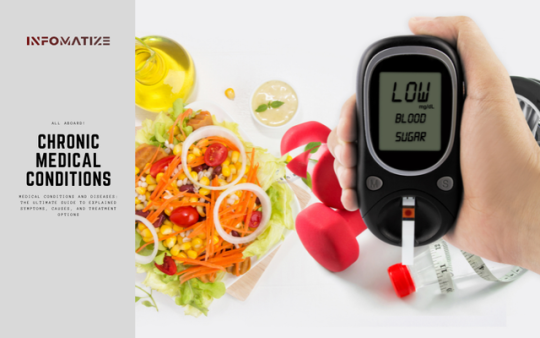
Chronic medical conditions are defined as long-lasting health conditions that require ongoing medical attention or limit daily activities for more than one year . Chronic diseases such as heart disease, cancer, and diabetes are the leading causes of death and disability in the United States . Six in ten Americans live with at least one chronic disease, such as heart disease, stroke, cancer, or diabetes, among others . Chronic obstructive pulmonary disease (COPD) is another common chronic condition, affecting 11% of older adults and causing shortness of breath, coughing, and chest tightness . Chronic conditions may affect individuals of all ages, but some groups are more likely to have them. People with disabilities are more likely to have chronic health conditions and to live in shared group settings, also known as congregate settings . Racial and ethnic minority groups are also more likely to develop chronic medical conditions at a younger age and to have more than one medical condition . There are various chronic medical conditions that individuals may experience. Some common chronic conditions include heart disease, cancer, diabetes, chronic obstructive pulmonary disease (COPD), Alzheimer's disease, and heart arrhythmia . Chronic conditions may develop and potentially worsen over time and may have immediate or rapidly developing symptoms . The prevention and management of chronic conditions is a public health priority. The Million Hearts® initiative, for example, prevented an estimated 135,000 cardiac events from 2012 to 2016, averting $5.6 billion in medical costs . Mayo Clinic offers specialized care for more than 200 heart conditions, including rare and complex disorders . Managing Chronic Medical Conditions with Medications Managing chronic medical conditions with medications is an important aspect of the overall treatment. Chronic pain, for example, can lead to complications beyond physical symptoms such as depression, anxiety, and trouble sleeping, which highlights the importance of effective pain management using medications . Medication adherence is also essential in chronic condition management, as it is directly linked to better health outcomes for patients, and non-adherence to medication can have significant impacts on the chronically ill . It is important for patients to be knowledgeable about their chronic condition as well as engaged and confident in managing the condition. One helpful strategy for coping with a chronic condition is to get a prescription for information. The more patients know about their condition, the better equipped they will be to understand what is happening and why . It is also worth noting that chronic illnesses such as cancer, heart disease, or diabetes may make patients more likely to have or develop a mental health condition. It is common to feel sad or discouraged after having a chronic illness diagnosis, and patients may face new limits on what they can do. However, managing the physical symptoms of the chronic condition with medications can help improve the overall quality of life and prevent the development of mental health conditions . Overall, managing chronic medical conditions with medications is an essential aspect of treatment. Patients should be knowledgeable about their condition, engaged in managing it, and adhere to their medication regimens for the best possible outcomes . It is important for patients to work closely with their healthcare providers to develop a personalized treatment plan that includes medication management. Lifestyle Changes to Manage Chronic Medical Conditions Managing chronic medical conditions often involves a combination of medication and lifestyle changes. Here are some lifestyle changes that can help prevent, delay, or manage chronic diseases : - Regular physical activity: Aim for moderate-intensity physical activity such as brisk walking or gardening for at least 150 minutes a week, with muscle-strengthening activities 2 days a week . - Healthy diet: Making simple dietary changes such as consuming less sodium by reducing the amount of packaged, processed foods in a diet can help patients manage or prevent high blood pressure. Maintaining a healthy diet is also helpful for managing chronic diseases like diabetes and heart disease . - Medication management: Remembering to take medication regularly can be challenging, especially when multiple medications are involved. It is important to establish a routine and follow it diligently. Patients should also discuss any concerns or side effects with their healthcare provider . - Adequate sleep: Getting enough sleep is crucial for managing chronic medical conditions. It is recommended to have a sleep routine and aim for at least 7-8 hours of sleep per night. Keeping the sleeping area cool, dark and comfortable and avoiding digital devices 90 minutes before bedtime can improve sleep quality . - Stress reduction: Chronic stress can worsen many chronic medical conditions. Patients can try mindfulness, yoga, or meditation to reduce stress levels. It is also helpful to establish a support system and participate in activities that bring joy and relaxation . In conclusion, lifestyle changes can be an effective way to manage chronic medical conditions. Patients should work with their healthcare providers to develop a personalized plan that includes medication and lifestyle modifications. Natural Remedies for Chronic Medical Conditions Chronic medical conditions can be challenging to manage, and traditional medical treatments may not always be effective. However, there are several natural remedies that may help relieve symptoms and improve the quality of life for individuals with chronic conditions. One review suggests that certain natural remedies can help reduce pain and swelling associated with chronic inflammatory skin conditions such as eczema . Additionally, holistic remedies, also known as complementary alternative medicine (CAMs), have been found to be effective in managing chronic conditions ranging from multiple sclerosis to ADHD . These include acupuncture, oriental medicine, chiropractic medicine, massage therapy, and naturopathic medicine . Hot or cold therapy can also be helpful for managing chronic conditions, such as arthritis, by reducing pain and stiffness . Additionally, research suggests that yoga may help relieve chronic back pain, although other types of exercise may be just as effective . It is important to note that while natural remedies may be effective for managing chronic conditions, they should not replace traditional medical treatments. Individuals with chronic conditions should always consult with their healthcare provider before trying any new remedies or treatments.
Mental Health and Medical Conditions
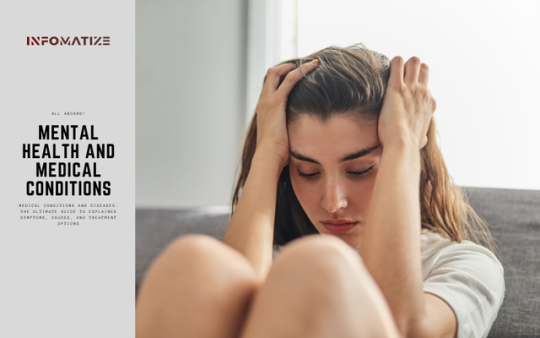
Mental health and medical conditions are often intertwined, as people with chronic illnesses such as cancer, heart disease, or diabetes are more likely to develop a mental health condition such as depression or anxiety . Mental health conditions can be characterized by issues regarding mood, thoughts, and behaviour, and they deeply impact day-to-day living, affecting a person's ability to relate to others and function in daily life . Mental health conditions may also be referred to as psychological disorders, mental illnesses, and mental health conditions . Mental illnesses are among the most common health conditions in the United States, with more than 50% of Americans being diagnosed with a mental illness or disorder at some point in their lifetime. Read the full article
#Acidreflux#Allergies#Alzheimer'sdisease#Anxietydisorder#Arthritis#Asthma#Asthmaattack#Attentiondeficithyperactivitydisorder(ADHD)#Australia#Austria#Belgium#Bipolardisorder#Breastcancer#Bronchitis#Canada#Cancer#Causesofabdominalpaininwomen#Causesofchronicbackpaininadults#Causesofchronicbronchitisinadults#Causesofchronicfatiguesyndrome#Causesofchronicheadachesinadults#Causesofchronicsinusitisinadults#Causesoferectiledysfunctioninmen#Causesofosteoporosisinwomen#Causesoftinnitusinadults#Chronicfatiguesyndrome#Chronicobstructivepulmonarydisease(COPD)#Chronicpain#Coloncancer#Crohn'sdisease
0 notes
Text
Personal Care and Hygiene: The Ultimate Guide to Skincare, Haircare, and Body Care for a Healthy You
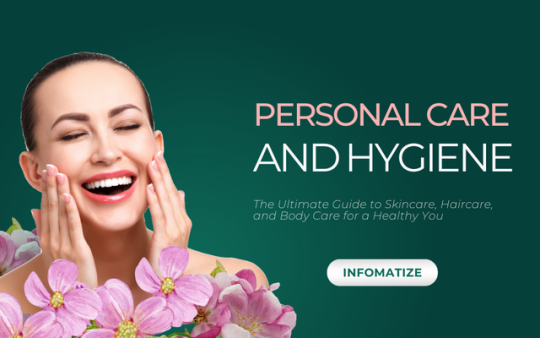
Introduction
Maintaining good personal hygiene is essential for overall health and well-being. Here are some tips and resources to help guide you in your personal care and hygiene routine: Skincare: For a comprehensive guide to skincare, check out Caroline Hirons' "skincare: The ultimate no-nonsense guide" . The book provides an award-winning, best-selling approach to skincare that will leave you with healthy and glowing skin. Additionally, Healthline provides a guide on skin care tips that covers everything from moisturizing to sleeping positions . Haircare: Maintaining healthy hair is essential to personal care, and Healthline provides a comprehensive guide to hair care routine, including the balance between cleansing hair without stripping it of its natural oils . WebMD also provides a list of grooming essentials, including exfoliators for the scalp . Body Care: Proper personal hygiene practices can prevent the spread of diseases and infections, and the Centers for Disease Control and Prevention (CDC) provide guidelines for maintaining personal hygiene. The guidelines include washing hands regularly and thoroughly, showering or bathing daily, and taking care of specific areas of the body that accumulate sweat . Additionally, the book "Personal Care and Hygiene Grooming" provides an overview of personal care practices such as bathing and showering, hair care, nail care, foot care, genital care, and dental care . In summary, maintaining proper personal care and hygiene practices is essential for overall health and well-being. The resources listed above provide comprehensive guides to skincare, haircare, and body care, and following the guidelines can help ensure a healthy and happy you.
Skincare
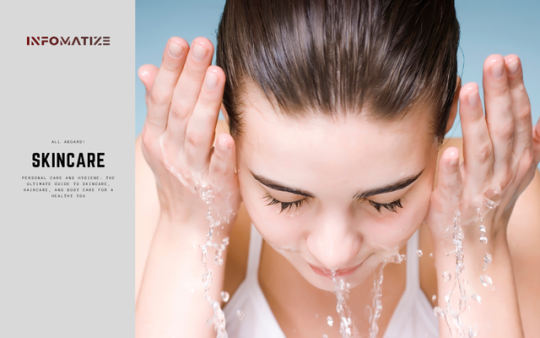
Skincare is a comprehensive approach to maintaining healthy skin. It involves a range of practices and products that aim to nourish and protect the skin, including cleansing, moisturizing, sun protection, and more. Skincare can help prevent and treat a variety of skin issues, such as acne, wrinkles, and discolouration. There is a wide range of skincare products and brands available on the market. Some popular brands include Olay Regenerist Retinol24, IT Cosmetics, and Fresh Skincare . These brands offer a variety of products, such as moisturizers, night creams, face oils, and more, to suit different skin types and concerns. In addition to skincare products, there are various DIY skincare practices that can help improve the health of the skin. For example, mixing dried oats with water to create a paste and applying it to the skin can help soothe and hydrate the skin . Drinking green tea can also have skin benefits when used as a rinse for the face . It's important to establish a consistent skincare routine that works for your specific skin type and concerns. This may involve experimenting with different products and practices until you find what works best for you. In general, a good skincare routine should include regular cleansing and moisturizing, as well as sun protection with non-comedogenic sunscreens . If you have specific skin concerns, such as acne or discolouration, it may be helpful to seek the advice of a dermatologist. Dermatology practices such as U.S. Dermatology Partners offer comprehensive skin care with the expertise of a national network and the convenience of a local practice . Medical spas such as Pure Radiance Medical Spa offer a range of proven medical-grade skincare products and treatments for anti-ageing and full-body rejuvenation . Overall, taking care of your skin is an important aspect of overall health and well-being. By establishing a consistent skincare routine and using high-quality products and practices, you can help keep your skin healthy and looking its best. The Importance of a Consistent Skincare Routine Maintaining a consistent skincare routine is crucial for achieving and maintaining healthy skin. It does not have to be a complicated process, but it should be tailored to your specific skin type and lifestyle needs . The benefits of a consistent skincare routine include preventing skin problems like deep wrinkles, hyperpigmentation, and acne scars , and can help save money in the long run by avoiding costly visits to the dermatologist or cosmetic surgeon . Additionally, healthy habits in your 20s and 30s can strengthen and prepare your skin for the effects of ageing down the road . However, consistency with skincare does not have to be a huge burden, as all it takes is a few short minutes in the morning and evening . In conclusion, a consistent skincare routine is essential at any age to ensure that your skin is at its best both now and for years to come . Best Skincare Products for Oily Skin Oily skin can be challenging to manage, and choosing the right skincare products can make a significant difference in managing it. Here are some of the best skincare products for oily skin according to the search results: - Cleansers: A good cleanser is an essential part of any skincare routine. The CeraVe Foaming Facial Cleanser and Neutrogena Oil-Free Acne Fighting Face Wash are two highly recommended options for oily skin. La Roche-Posay Effaclar Deep-Cleansing Foaming-Cream Cleanser is also a good option if you prefer a creamy cleanser . - Exfoliants: Oily skin can benefit from gentle exfoliation, and one of the best options for oily skin is Paula's Choice Skin Perfecting 2% BHA Liquid Exfoliant . - Serums: Serums can help manage oily skin by targeting specific concerns, such as blemishes and uneven skin tone. Topicals Faded Brightening and Clearing Serum is a good choice for oily skin . - Moisturizers: Moisturizing is an essential step in any skincare routine, even for oily skin. A lightweight, oil-free moisturizer such as Neutrogena Oil-Free Moisture is a good choice for oily skin . - Salicylic acid cleanser: Salicylic acid is an excellent ingredient for oily skin because it helps unclog pores and reduce oiliness. The Inkey List Salicylic Acid Cleanser is a highly recommended option for oily and acne-prone skin . Remember that everyone's skin is unique, and what works for one person may not work for another. It's always best to do a patch test on a small area of skin before using a new product and consult with a dermatologist if you have any concerns or questions. Skincare for Sensitive Skin Sensitive skin requires gentle and soothing ingredients to avoid irritation . When selecting skincare products for sensitive skin, it is recommended to look for non-comedogenic and fragrance-free options . Some of the best skincare brands for sensitive skin include Aveeno, which features colloidal oatmeal as its main ingredient and is formulated for sensitive skin , and Clinique, which offers a hydrating, aloe-based eye cream with a water-gel formula . For sunscreen, dermatologists tend to recommend physical sunscreens over chemical ones, and the Colorescience All Calm Clinical Redness Corrector SPF 50 is a good option for sensitive skin . When looking for ingredients in products for sensitive skin, one should look for ingredients like aloe vera, chamomile, green tea, and oats which are known for their soothing properties .
Haircare
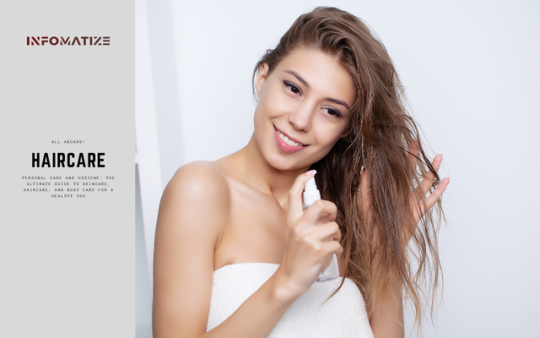
Haircare is a broad topic that encompasses a variety of practices and products designed to improve the health and appearance of hair: - Moisturizing and sealing are useful steps for those with kinky or coily hair, as they can help to add further hydration to the hair . - Drinking enough water is essential for maintaining good hair health, as it ensures both internal and external hydration . - Amazon offers a wide selection of haircare products and tools, including shampoos, conditioners, styling products, and more . - The CHI speed hair straightener is a highly rated option that earned a 100 out of 100 rating from beauty experts in flat iron testing . - Vogue recommends retaining moisture and softness, combating humidity, and protecting against heat and colour-related damage as essential elements of a haircare routine . - Haircare Group has been supporting the hair industry with exclusive products and brands since 1974 . - L'Oreal Paris recommends washing hair with lukewarm water, as scalding hot water can strip hair of essential oils and leave it feeling dry and dull . - Using lukewarm water to wash hair and cool water to rinse is recommended by Himmie Lau, a hair care expert and executive marketing director from Viori Shampoo Bars. Hot water can encourage hair cuticles to open too much, leading to moisture loss . - Kérastase is a luxury hair brand that offers quality haircare and styling products for different hair types, including the Curl Manifesto line for nourishing curls . - A DIY hair spray can be made using almond oil, coconut oil, hair conditioner, and water to nourish and hydrate hair . In summary, a good haircare routine involves moisturizing and sealing, drinking enough water, using high-quality haircare products and tools, protecting hair from heat and colour-related damage, and washing hair with lukewarm water. Different hair types may require different products and care, so it is important to choose products and routines that are suited to individual needs. The Benefits of Natural Haircare Remedies Natural haircare remedies have been gaining popularity in recent years due to their numerous benefits. Here are some of the benefits of using natural haircare remedies: - Aloe vera: Aloe vera is a natural remedy that has many benefits for hair, including strengthening hair and promoting hair growth . It contains essential amino acids, vitamins, minerals, and fatty acids that nourish and moisturize hair, making it stronger and healthier. - Coconut oil: Coconut oil is another natural haircare remedy that has many benefits for hair. It has been shown to relieve scalp irritations and symptoms of scalp psoriasis, as well as to restore lustre to dry and damaged hair . Coconut oil is also rich in fatty acids, which can improve hair health by nourishing and moisturizing the hair. - Omega fatty acids: Consuming omega fatty acids can help improve hair health from the inside out by providing essential nutrients and proteins. Omega supplements, along with antioxidants, can help improve hair health and promote hair growth . Overall, natural haircare remedies can provide numerous benefits for hair health, including strengthening hair, promoting hair growth, relieving scalp irritations, restoring lustre to dry and damaged hair, and improving hair health from the inside out. Incorporating these remedies into your haircare routine may be a great way to nourish and protect your hair naturally. Haircare Tips for Dry Hair Dry hair can be frustrating to deal with, but there are several natural remedies that can help improve its appearance and health. Here are some tips: - Use a homemade spritz hair perfume made from mixing argan oil, peppermint oil, lavender oil, and carrier oil like coconut oil together to make your hair feel less dry over time. - Give your hair more tender loving care by avoiding hot styling tools, such as curling irons or hair straighteners, and only wash your hair two to three times a week. - Avoid overuse of hair styling products, including hair dye and heated styling, and make some lifestyle changes that can help alleviate dry hair. - Be mindful of what you put in your hair, such as avoiding washing your hair too often, using harsh shampoos, conditioners, or styling products, and dying or chemically treating your hair regularly. - Gently brush or comb your hair 2-3 times a day for a couple of minutes each time. This can help distribute natural oils and prevent further damage. If you swim often, follow pool-smart tips for dry hair to prevent chlorine from making it worse. By following these tips, you can help alleviate dry hair and improve its overall health and appearance. How to Prevent Hair Damage Taking good care of your hair can prevent hair damage and keep it healthy. Here are some tips on how to prevent hair damage: - Use a gentle shampoo: Avoid washing your hair too often and use a gentle shampoo that suits your hair type. Instead of rubbing the shampoo into the length of your hair, gently massage it into your scalp and let it flow through the length of your hair when you rinse it out. This helps prevent damage to the hair shaft. - Avoid rubbing your hair with a towel: Drying your hair with a towel can cause breakage and damage, especially if you rub it aggressively. Instead, use a soft material like a cloth from a shirt to blot your hair dry, and opt for a wide-tooth comb or a wet brush when detangling wet hair. - Protect your hair from heat: Excessive heat styling can damage your hair, so it's important to use heat protectants and avoid using high heat settings. Try to air-dry your hair as much as possible, and if you must use a blow dryer, hold it at least 6 inches away from your hair. It's also important to avoid using hot tools on wet hair, as it can cause damage to the hair cuticle. - Be mindful of your hair accessories: Certain hair accessories can pull and tug on your hair, leading to damage and breakage. Avoid using tight hair ties and opt for scrunchies or hair clips instead. Additionally, be careful with hats and scarves that may rub against your hair and cause friction. - Protect your hair from hard water: Hard water can leave your hair limp, brittle, and hard to style, so it's important to take action to protect your hair from it. You can use a clarifying shampoo or a chelating shampoo to remove mineral buildup and use a shower filter to reduce the number of minerals in the water. By following these tips, you can prevent hair damage and keep your hair looking healthy and shiny.
Body Care and Hygiene
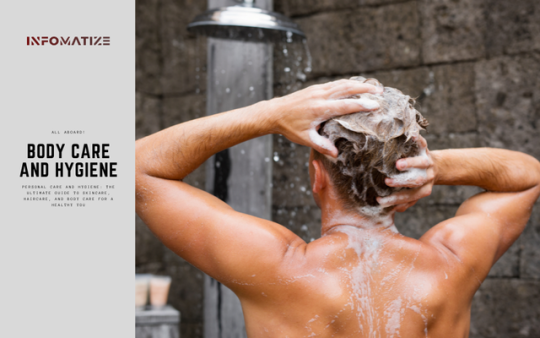
Body care and hygiene are crucial aspects of maintaining good health and preventing the spread of germs and diseases. To practice good hygiene, it is advisable to shower or bathe daily using soap and water to rinse away dead skin cells, oil, and bacteria. Pay special attention to areas that accumulate more sweat, such as the armpits and groin . In addition to daily bathing, it is essential to maintain proper hand hygiene. Always wash your hands after using the restroom, before preparing or eating food, after coughing or sneezing, and after handling garbage. Scrub your hands with soap for at least 20 seconds, and be sure to clean between your fingers, on the back of your hands, and under your nails . Other essential personal hygiene practices include brushing your teeth twice a day, flossing daily, and regularly visiting the dentist. Maintaining proper nail hygiene is also important in eliminating germs and bacteria and preventing diseases. It is also recommended to cover your nose and mouth when coughing or sneezing to prevent the spread of germs and avoid sharing razors, towels, or makeup with other people . In summary, body care and hygiene are crucial for maintaining good health and preventing the spread of germs and diseases. Regular bathing, hand washing, and dental care, as well as covering your nose and mouth when coughing or sneezing, are essential personal hygiene practices to adopt. Proper Hygiene Practices for Men and Women Proper hygiene practices are essential for maintaining good health and preventing the spread of infections. Both men and women can benefit from following hygiene practices that are specific to their gender as well as general hygiene practices that are common to both genders. Personal hygiene practices for both men and women include keeping hands clean, nail hygiene, facial cleanliness, coughing and sneezing etiquette, foot hygiene, hair and scalp hygiene, infant hygiene, and everyday cleaning . It is recommended to wash hands frequently with soap and water, especially before and after preparing food, eating, or using the bathroom. Keeping nails trimmed and clean can prevent infections such as hangnails and infected nail beds. Regular bathing and hair washing can help prevent body odour and keep the skin and hair healthy. It is also important to cover the mouth and nose with a tissue or elbow when coughing or sneezing. Dental hygiene is another important aspect of personal hygiene. The American Dental Association recommends brushing teeth for at least two minutes at least twice a day, preferably before breakfast and before bed . In addition, it is essential to maintain good environmental hygiene by regularly cleaning and disinfecting surfaces that come into contact with people, such as countertops, doorknobs, and light switches. Maintaining clean surroundings can help prevent the spread of infectious diseases. According to the World Bank, hygiene promotion is the most cost-effective health action to reduce disease . As of 2020, 2.3 billion people lacked basic hygiene services, such as a handwashing facility with soap and water, and 1.6 billion people had access to handwashing facilities that lacked water or soap. Both men and women can also benefit from gender-specific hygiene practices. For men, proper hygiene practices may include maintaining a clean-shaven face, using antiperspirant to prevent body odour, and wearing clean clothes . For women, proper hygiene practices may include regular breast self-exams, maintaining proper menstrual hygiene, and practising safe sex to prevent the spread of sexually transmitted infections . Overall, proper hygiene practices are essential for maintaining good health and preventing the spread of infectious diseases. It is important to follow both general hygiene practices and gender-specific hygiene practices to ensure good hygiene. Body Care Products for Men When it comes to body care products, men have a wide range of options to choose from. Many companies have introduced lines of products specifically tailored to men's skincare needs. Here are some of the body care products for men that can help maintain a healthy and fresh look: - Bath & Body Works : offers a variety of men's body care products, including hair and body wash, lotions, and body sprays, with different fragrances to choose from. - Amazon : offers a wide selection of men's body care products, including body washes, soaps, lotions, deodorants, and antiperspirants. - The Man Company : offers a range of men's body care products that contain natural ingredients like Aloe Vera, coconut oil, lemongrass, ginger, lime, cinnamon, neem, and vitamins. - Nivea Men : offers a range of men's body care products, including body washes, shaving gels, and post-shave lotions. - GQ : recommends a range of products that cater to different skin types, such as face washes, moisturizers, and serums, to name a few. When choosing body care products for men, it is important to consider factors such as skin type and individual needs. Read the full article
#Australia#Austria#Bathandbody#Bathandbodyproductsforaspa-likeexperience#Beauty#Beautyessentials#Beautyessentialsforeverydayuse#Beautyhacks#Beautyhacksforquickandeasygrooming#Beautyproducts#Beautyroutine#Beautyroutineforahealthyglow#BeautyTips#Beautytipsforaflawlesscomplexion#Belgium#Bestbeautyproductsfornaturalbeauty#Bestbeautyproductsforpersonalhygiene#Bodycare#Bodycareproductsforahealthyyou#Bodyhealth#Bodyhealthtipsforafitandtonedbody#Canada#Cleanbeauty#Cleanbeautyproductsforahealthyyou#Cleanliness#Cleanlinesstipsforahealthyhome#Denmark#Finland#France#Germany
0 notes